Page 1

®
POD® HD Pro
Advanced Guide
An in-depth exploration of the features &
functionality of POD HD Pro
Electrophonic Limited Edition
Page 2

Table of Contents
Overview ................................................................................. 1•1
Home Views ................................................................................................... 1•1
Tuner Mode .................................................................................................... 1•4
Tap Tempo ...................................................................................................... 1•5
Connections ................................................................................................... 1•5
POD HD Edit Pro Software ........................................................................... 1•6
System Setup ......................................................................... 2•1
Accessing System Setup ................................................................................. 2•1
Page 1, Setup:Utilities Options ..................................................................... 2•2
Page 2, Setup:Utilities Options ..................................................................... 2•3
Page 3, Setup: Input Options ......................................................................... 2•4
Page 4, Setup: Output Options ...................................................................... 2•8
Page 5, Setup: Digital Output Options .......................................................... 2•9
Page 6, MIDI/Tempo Options ..................................................................... 2•10
Page 7, Setup: Variax Options ..................................................................... 2•11
Page 8, James Tyler Variax Tuning Options ................................................ 2•16
Page 9, Setup: L6 LINK Audio .................................................................... 2•17
Page 10, Setup: L6 LINK Control ............................................................... 2•17
Features & Functionality ....................................................... 3•1
FX Blocks ....................................................................................................... 3•1
Mixer Block .................................................................................................... 3•4
Moving FX Blocks .......................................................................................... 3•5
FX & Amp Block FBV Footswitch Assignment ............................................ 3•7
Dynamic DSP ................................................................................................. 3•8
Set Lists & Presets ................................................................. 4•1
Working with Set Lists ................................................................................... 4•1
Working with Presets ..................................................................................... 4•5
Saving Presets ................................................................................................. 4•6
Page 3

FX Edit Mode ......................................................................... 5•1
Accessing FX Edit Mode ................................................................................ 5•1
Amp, Cab & Mic Models ........................................................ 6•1
Amp Model Positioning ................................................................................. 6•1
Selecting Amp, Cab & Mic Models .............................................................. 6•3
Editing Amp Parameters ................................................................................ 6•6
Amp & Cab Edit Display ............................................................................... 6•7
Amp/Preamp Models ................................................................................... 6•12
Cab Models ................................................................................................. 6•14
FX Models ............................................................................... 7•1
Dynamics Models ........................................................................................... 7•1
Distortion Models .......................................................................................... 7•2
Modulation Models ........................................................................................ 7•3
Filter Models .................................................................................................. 7•5
Pitch Models .................................................................................................. 7•6
Preamp & EQ Models .................................................................................... 7•9
Delay Models ................................................................................................ 7•10
Reverb Models ............................................................................................. 7•12
Volume/Pan & Wah Models ........................................................................ 7•14
Looper Mode .......................................................................... 8•1
Looper Controls & Performance View .......................................................... 8•1
Looper Settings .............................................................................................. 8•4
USB Audio .............................................................................. 9•1
The Line 6 USB Audio Driver ...................................................................... 9•1
The Line 6 Audio-MIDI Devices Panel ........................................................ 9•3
Mac® - Line 6 Audio-MIDI Devices ............................................................. 9•4
Windows® - Line 6 Audio-MIDI Devices ..................................................... 9•8
Page 4

Appendix A: Line 6 Monkey ................................................. A•1
Launch Line 6 Monkey ................................................................................. A•1
Grab Those Updates ..................................................................................... A•2
Line 6 Variax Updates ................................................................................... A•4
Appendix B: FBV Foot Controllers ......................................B•1
FBV MkII & FBV Series Controllers ............................................................. B•1
Setup Options for FBV ................................................................................... B•2
FBV Controller Devices - Footswitch & Pedal Mapping ............................. B•5
FBV Shortboard MkII .................................................................................... B•5
FBV Express MkII .......................................................................................... B•8
FBV Longboard ............................................................................................ B•10
FBV Shortboard ........................................................................................... B•13
Expression Pedal & Variax® Knob Controller Assignment ....................... B•16
Amp & FX Block Footswitch Assignment .................................................. B•18
Set List Select .............................................................................................. B•22
Tap Tempo .................................................................................................... B•22
Tuner Mode .................................................................................................. B•23
Appendix C: MIDI ................................................................. C•1
Controlling POD HD Pro Functions via MIDI .............................................C•2
Bank & Program Change Messages ...............................................................C•3
Using POD HD Pro/FBV as a MIDI Controller ............................................C•5
Line 6, POD, DT50, DT25, Variax, James Tyler, Vetta, L6 LINK, CustomTone and Line 6 Monkey are trademarks of Line 6, Inc. All
other product names, trademarks and artists’ names are the property of their respective owners, which are in no way associated or affiliated
with Line 6. Product names, images, and artists’ names are used solely to identify the products whose tones and sounds were studied during
the Line 6 sound model development for this product. The use of these products, trademarks, images, and artists’ names does not imply any
cooperation or endorsement.
Copyright © 2012 Line 6, Inc.
Page 5

Overview
Overview
Welcome to the POD® HD Pro Advanced Guide. This guide contains in-depth details
of the POD HD Pro features and functionality. Please be sure to also read through your
POD HD Pro Pilot’s Handbook for basic info on POD HD Pro and this Guide will take
it from there! In this chapter, we’ll present an overview of the main screens and features
to get you started.
This Guide covers POD HD Pro with Flash Memory version 2.0 (or later) installed.
Please use Line 6 Monkey to check for and install the latest updates for your device - see
“Appendix A: Line 6 Monkey” on page A•1.
Home Views
The place to start is in one of the Home View screens. Press the VIEW button to
SAVE
S
E
E
T
R
S
P
rotate through the available Home Views. While in any of these Home View
screens, you can turn the PRESETS knob and call up a Preset in the current
HOLD FOR SYSTEM & I/O
VIEW
Setlist, or push the PRESETS knob to select from among other Set Lists!
Signal Flow View
The Signal Flow View displays all Amp & FX “Blocks” and their ordering for the current
Preset. As you’ll see in several of the following chapters, this is the screen where you’ll
“select” the desired Block to perform other actions, such as choose a new Amp or FX
Model, edit its parameters, move its position, and more.
1•1
Currently loaded Preset
location and title
Use the and Nav.
Parallel Paths A (upper)
and B (lower) with Mixer
Block
Pad buttons to select the
desired Block
FX Blocks within
“Pre” position
Amp Blocks Looper
FX Blocks within
“Post” position
The items within the Signal Flow View
The signal flow architecture of each Preset is comprised of 3 main sections where Amp &
FX Blocks can be positioned: Pre, Post and parallel Paths A & B.
Page 6

Overview
1•2
At the bottom of the Signal Flow View screen, you’ll see up to four parameters that are
accessed using the Multi-function knobs 1-4.
Accessing parameters with the Multi-select Knobs
These parameters are specific to the currently selected Block and allow you to choose
new Models & edit parameters. Or, you can dive deeper using the Edit Mode and access
additional settings in other screens, as covered in the following chapters.
Big User View
This screen simply provides you with one BIG display of the currently loaded Preset
number - convenient for dark stages!
The Big User View
Page 7

Overview
Performance View
This screen displays the functions available for a Line 6 FBV™ Controller’s footswitch
functions, if an FBV is connected. This screen appears in three different variations,
depending on your device settings. The four options on the lower half of the screen pertain
to the FBV A, B, C & D footswitches.
You’ll see one of the following screens appear, dictated by the current POD HD Pro Setup
- FS MODE setting - Also see “Page 1, Setup:Utilities Options” on page 2•2 for details.
“FS 5-8” Mode“ABCD” Mode
1•3
When POD HD Pro is in Looper Mode (Looper Mode is available when an FBV device is
connected), a 3rd variation of the screen displays the Looper functions that are accessed
by the FBV A, B, C & D footswitches. Also see “Looper Controls & Performance View”
on page 8•1.
The Performance View with Looper Mode active
Page 8

Overview
1•4
Tuner Mode
To enter Tuner mode, press and hold the TA P button. A few options are available, adjusted
using the Multi-function knobs.
The Tuner screen
Note that the Tuner receives a signal only from the POD HD Pro Input 1 source.
Pluck an individual string on your guitar and you’ll see the name of the note displayed.
When the graphic bar is to the left of center, your string is flat; when it is to the right, your
string is sharp. When the bar is within the center range, triangles will appear above and
below it, indicating your string is in tune.
• Reference (Knob 1): If you’d like to tune to a reference other than standard 440Hz,
select from 425 to 455Hz.
• Audio (Knob 2): Select Mute to silence POD HD Pro output while tuning, or select
Bypass to hear your guitar dry.
Press the TAP switch, or any other button, to exit Tuner Mode.
Page 9

Tap Tempo
Tap Tempo is the term we use to refer to the “System Tempo” value that is
accessed via the TAP button on your device. Tap rhythmically to set your Tempo.
Alternatively, you can set a numerical Tempo value within Setup (see “Page 6,
MIDI/Tempo Options” on page 2•10). This setting is saved per Preset.
You’ll see the TA P switch blink to indicate your current Tap Tempo BPM (if your Tap LED
option is set to “On” - see “Page 6, MIDI/Tempo Options” on page 2•10). Tempo-based
FX (Modulation, Filter & Delay FX) that offer a Tempo Sync parameter can optionally be
set to a note division of this Tap Tempo value.
Connections
Please refer to your POD HD Pro Pilot’s Guide for descriptions of the Input & Output
connections. You’ll find more details on their specific uses within the following chapters
as well!
Overview
1•5
Page 10

Overview
1•6
POD HD Edit Pro Software
Be sure to visit line6.com/software to download the Line 6 POD® HD Pro Edit software
- the free patch editor/librarian for Mac® and Windows® computers. Using POD HD Pro
Edit and a USB connection you can easily create, audition, customize, backup/restore and
save an unlimited number of Tone Presets for your device.
The POD HD Pro Edit application
Page 11

SyStem Setup
In this chapter, we’ll cover the options for configuring your POD® HD Pro system settings.
Note that some System Setup options are “global” settings (they persist always, regardless of
the current Preset) while others are saved individually per Preset, as noted in the following
sections. You’ll want to be sure to save your Preset after changing settings of the latter type
in order to retain them. To restore all global settings to their factory default value, hold
down the Nav. Pad - left arrow button while powering on POD HD Pro.
Accessing System Setup
To access the System Setup options, press and hold the VIEW button. Here you can
configure several device functions, Input & Output settings and more.
SAVE
S
E
E
T
R
S
P
System Setup
2•1
HOLD FOR SYSTEM & I/O
VIEW
Use the Nav Pad buttons to navigate through the several Setup pages.
Page 12

System Setup
Page 1, Setup:Utilities Options
2•2
The top portion of the screen lists the Flash Memory and USB Firmware versions currently
installed on your POD HD Pro device. The lower portion of the screen offers four options,
adjustable using the Multi-function Knobs 1 - 4.
• Footswitch Mode (Knob 1): This option applies to a connected Line 6 FBV
Controller’s A, B, C & D footswitches (also see “Appendix B: FBV Foot Controllers”
on page B•1). You’ll see your POD HD Pro Performance View screen reflect the
functions of these buttons according to the mode selected here (see “Performance
View” on page 1•3). This setting is global.
• In “ABCD” Mode: The A, B, C & D FBV footswitches recall the current Bank’s
Presets A-D.
• In “FS 5-8” Mode: The A, B, C & D FBV footswitches toggle the FS 5-8 assigned
Models On/Off.
• Amp Knobs Display (Knob 2): When set to “On,” allows the LCD screen to
momentarily display the actual Amp Tone Knob values whenever adjusting any
physical amp knob. This setting is global.
• Looper FS Display (Knob 3): When Looper Mode is active (Looper Mode can be
accessed when an FBV device is connected), this option determines how and when
the Looper screen is displayed (see page 8•1). This setting is global.
• All Views: When Looper Mode is On, the Looper screen is always displayed.
• Performance View: When Looper Mode is On, displays the Looper screen, or the
other Performance View (Signal Flow or Big User) screens, by toggling the VIEW
button. This option can be useful for referencing your Presets or adjusting Models
while Looping.
Page 13

• Trails (Knob 4): When set to “On,” allows the echo repeats and/or decay of Delay
and Reverb FX to continue when the Model is toggled Off. With the Trails option
“Off” the decay is muted instantly when toggling the Model Off. This setting is
saved per Preset. (Note that this feature does not provide a “spillover” of the FX
decay when changing Presets.)
Page 2, Setup:Utilities Options
The options at the bottom of the screen are as follows - all are global settings.
System Setup
2•3
• LCD Contrast (Knob 1): Adjusts the screen’s contrast.
• Tap Tempo LED (Knob 2): Choose “On” to have the LED light for the TAP button
(or connected FBV TAP footswitch) flash to indicate the current Tap Tempo value.
Choose “Off” to have it remain unlit.
• AC Frequency (Knob 3): All HD Amp Models include simulation of AC hum, typical
of the AC Vacuum Tube Heater component - an important part of the tonality of
a tube amplifier. Set the AC Rate to match that of the USA (60Hz) or UK (50Hz)
frequency for authenticity. (This setting may be subtle depending on the current
Amp Model settings, and may be more apparent when synchronizing this setting
with the AC rate of any tube amplifier that POD HD Pro may be plugged into.)
• FBV Express (Knob 4): This option applies only to a connected Line 6 FBV
Controller. It should only be set to “On” specifically for a FBV Express MkII model
device. Please see “Setup Options for FBV” on page B•2.
Page 14

System Setup
Page 3, Setup: Input Options
2•4
The Inputs Setup page allows you to select which of the device’s audio inputs are used as
the “source” – sort of like a built-in, programmable patchbay. There is also a control which
adjusts the Guitar input impedance.
• Input 1 and Input 2 Source (Knobs 1 & 2) - Select the physical input(s) that you
want to be the “source” which feeds into the signal path. Note that you can choose
different Sources to independently feed each signal path, or choose Same to feed a
common Source into both paths.
• The Variax and Variax Mag Input Source options are provided for Line 6 Variax®
guitars when connected into the POD HD Pro VARIAX Digital Input (VDI).
• With a James Tyler® Variax® (JTV), the “Variax” Input Source receives the
Model or Magnetic signal, depending on the JTV’s Model switch settings.* The
“Variax Mag” Input Source receives only the JTV’s Magnetic Pickup signal.
*Note: With a JTV in use, the “Variax” Input Source selection also recalls whether you
were using mags or models per preset, allowing you to pick up exactly where you left off –
no need for manual selection or input changes.
• If you own a first-generation Variax instrument, it is recommended to choose the
Variax Input Source option. Please also refer to your Variax documentation.
• Guitar In-Z - Select the input impedance of the Guitar input. This feature affects
tone and feel because your guitar pickups are being loaded as they would be by an
effect pedal or a tube amplifier.
Note: The Guitar In-Z setting affects the GUITAR IN input only. Please see the Impedance
Ratings table at the end of this section to reference the input impedance of each individual
model.
Page 15

• The Auto option dynamically sets the input impedance to match the input
impedance of the very first Amp or FX model in your POD HD signal chain.
• Or, you can manually select from a variety of impedance values from low to high
(22k,32k,70k,90k,136k,230k,1M,or3.5M).Alowervaluewilltypicallyresult
in some high frequency attenuation, lower gain and overall “softer” feel. A higher
value provides full frequency response, higher gain and overall “tighter” feel.
• Inputs Setup -Determines whetherthe other 3 options inthis Inputs screen are
applied per Preset, or globally.
• Preset - Recalling a preset will load the Input 1 Source, Input 2 Source and Guitar
In-Z parameter settings as last saved with the individual preset.
• Global - Once the “Global” option is selected here, the other three Input options’
valuesonthis Setup page(InputSources1and2,andGuitarIn-Z)areutilized
globally, regardless of their values that are saved with each individual preset. The
Input values you choose on this Setup page are then retained independently for
the Inputs Setup - Global option. When you change the Inputs Setup back to
“Preset,” the Input options’ values saved with each individual preset are once
again utilized.
Note: Saving a preset while this option is set to “Global” will write the current global
Inputs and Guitar In-Z values to the individual, saved preset.
System Setup
2•5
Amp & FX Model - Guitar Input Impedance Ratings
Model Guitar Input Impedance
(Ohms)
Amps & Preamps
All Amp & Preamp Models 1M
Distortion FX
Screamer 230k
Color Drive 136k
Buzz Saw 230k
Facial Fuzz 22k
Jumbo Fuzz 90k
Fuzz Pi 22k
Octave Fuzz 230k
All Other Distortion Models 1M
Page 16

System Setup
2•6
Amp & FX Model - Guitar Input Impedance Ratings
Model Guitar Input Impedance
(Ohms)
Dynamics FX
All Dynamics Models 1M
Modulation FX
Dual Phaser 230k
U-Vibe 90k
Analog Choruis 22k
All Other Modulation Models 1M
Filter FX
All Filter Models 1M
Pitch FX
All Pitch Models 1M
Delay FX
Multi Head 22k
Analog Echo 230k
Analog w/Mod 90k
All Other Delay Models 1M
Preamp + EQ FX
All Preamp & EQ Models 1M
Reverb FX
All Reverb Models 1M
Wah FX
Weeper 90k
All Other Wah Models 1M
Volume & Pan FX
All Volume and Pan Models 1M
FX Loop
FX Loop 1M
Page 17

System Setup
About Source Input Signal Routing
ItisimportanttonotehowPODHDProactuallyroutesSourceInputs1and2through
Amp & FX Blocks that are positioned “Pre” position. The following behaviors apply:
• In a configuration with no Amp or FX Blocks in Pre, Input 1 is fed only to Path A
andInput2onlytoPathB.Therefore,thisisthebestcongurationifyouwantto
retain discrete Input Sources into Paths A & B.
• Placing an Amp Block or an active mono FX Model in Pre results in a “summing”
ofInputSources1&2,feedingthesame,combinedsignalintothesePre-positioned
Models, and thus into each Path A & B. You may need to adjust your instrument’s
volume level to avoid overloading your Pre-positioned Amp or FX Models.
• Placing a Stereo FX Model in Pre results in the left channel FX output being fed to
Path A and its right output to Path B.*
• The Mixer Block’s Volume and Pan options provide independent control for Path
A & B outputs before they are fed through any Blocks positioned “Post” the Mixer.
• BysettingInput2to“Same,”thiseffectivelyroutesyourInputSourcetobothstereo
Paths A & B (which is how you can feed one guitar input into two Amp Models and/
or parallel FX, for example).
2•7
*Please also see “Model Types and Mono/Stereo Signal Routing” on page 3•6 for more
about how mono and stereo FX affect your signal chain.
Page 18

System Setup
Page 4, Setup: Output Options
Note that this Mode setting affects the signal fed to the POD HD Pro Left & Right
2•8
Balanced, Unbalanced, Digital & Headphone outputs, as well as the signal fed to the USB
Record Send & L6 LINK™ output.
The Mode setting on this page allows you to configure the type of signal fed to your POD
HD Pro outputs to optimize for direct recording versus connecting to an external amplifier.
Knob 1 selects the Output Mode. This is a global setting.
• Studio/Direct: Typically the best option when connecting “Direct” to a mixing
console or recording device. This signal includes “Studio” Cab Models, Mic Model
and an “AIR” convolution to best emulate a mic’ed amp within a room.
• Combo and Stack settings: Optimizes your tone for connecting to an external
amplifier. The signal includes “Live” Cab Models,with no Mic Model or “AIR”
convolution, with a special EQ curve added for each.
• Combo Front & Stack Front: For connecting into the front input of a typical
combo amp or amp head + external cab, respectively. When choosing either of
these Modes, you’ll see these additional options for further tone shaping:
• Lows (Knob 2): Attenuates the low frequencies.
Page 19

System Setup
• Focus (Knob 3): Increases the overall midrange.
• Highs (Knob 4): Attenuates the high frequencies.
• Combo Power Amp & Stack Power Amp: For connecting to the power amp of a
combo or head amp.
TIP: When using the Combo or Stack options and connecting into a tube amplifier, we also
recommend that you choose a Preamp Model from the Amp Model menu (rather than one
of the “Full” Amp Models). HD Preamp Models include no power amp emulation, making
them typically better suited for this connection. That said, there is no wrong choice! PODs
have always been about flexibility... Check out all the possibilities and decide which Models
work best for your tone!
Page 5, Setup: Digital Output Options
Theseoptionsare strictly forconguringthe signalfedto the24-bitdigital outputs(S/
PDIF or AES/EBU). All settings are global. When connecting to another digital device,
it is best to clock the external device to follow POD HD Pro (with POD HD Pro as
the “master” device) to maintain proper synchronization - please see your digital device’s
documentation for its digital clock features.
2•9
Note: The AES/EBU - L6 LINK output is an XLR jack that can be used for either type
of connection (also see “Page9,Setup:L6LINKAudio”onpage2•17). The AES/EBU
options in this screen apply only the AES/EBU output and do not affect the L6 LINK audio
signal when connected to a Line 6 DT Series amplifier.
Page 20

System Setup
2•10
Page 6, MIDI/Tempo Options
• Digital Output (Knob 1): Selects the type of output mode signal.
• Match Outputs: Uses the setting as configured on the Setup:Outputs screen - see
page 2•8.
• Dry Input: Your Source Input signal with no Amp, Cab, Mic, “E.R.” or FX
processing applied. (Handy for recording a dry signal in your DAW, to which you
can add a Plug-In or “re-amp” later!)
• Sample Rate (Knob 2):Selectsthesamplerate:44.1kHz,48kHz,88.2kHzor96kHz.
When connecting to another device’s S/PDIF or AES/EBU input, always be sure to
set both units to utilize the same sample rate.
• Digital Level (Knob 3): Increases the amplitude of the S/PDIF or AES/EBU signal:
0dBto+12dB.
• Digital Format (Knob 4): Choose between settings for the S/PDIF or AES/EBU
digital outputs.
• MIDI Channel (Knob 1): Sets the “System” MIDI Channel that POD HD Pro
utilizes for both receiving and sending MIDI communication via the MIDI DIN
Input/Output. Choose any individual Channel 1 - 16, or “Omni” for all Channels.*
This is a global setting.
*Note: The MIDI Channel selected here also affects the MIDI Channel settings utilized by
L6 LINK - see “Page 10, Setup: L6 LINK Control” on page 2•17.
• MIDI Out/Thru (Knob 2): Allows the MIDI Out DIN to be switched between a
MIDI Output versus MIDI Output + Thru.
Page 21

• Tempo Sync (Knob 3): The “Speed” or “Time” parameters of all tempo-based FX
(Modulation, Pitch & Delays) can optionally be set to a note value to follow the
(Knob 4) Tempo BPM value. This Tempo Sync option is a global setting that allows
you to choose whether the FX follow the Tap Tempo as a per-Preset value or globally.
• Preset: Tempo settings are saved and recalled on a per Preset basis.
• Global: Tempo information stored within any Preset is ignored. When saving a
Preset while this option is set to “Global,” the current tempo value will be saved
with the Preset.
• Tempo (Knob 4): Enter in a specific “Tap Tempo” for your current Preset (as opposed
to pressing rhythmically on the TAP button). This value is saved individually per
Preset.
Page 7, Setup: Variax Options
System Setup
2•11
Setup Page 7 - No Variax connected Setup Page 7 - James Tyler Variax connected
Asillustratedabove,Setuppage7willdisplayadditional,model-specicoptionswhena
Variax instrument is connected to the POD HD Pro VARIAX (VDI) input. The specific
Variax family and firmware version are displayed at the top right of the screen when the
Variax is connected. Available options and behaviors displayed will differ depending on
the Variax type and model you have connected, as described in the following sections.
With any Variax connected to the VDI input, the Knob 1 option functionality is as follows.
• Variax Control (Knob 1): Choose whether you want to assign all your Variax settings
onthisSetuppg7screenonaperPresetbasisorGlobally.*
• When set to “Preset,” all the parameter settings shown on the Variax Setup
screens(Setup pages 7 & 8) are saved and recalled individually per POD HD
Pro preset. You’ll see additional options in the screen when you have a Variax
connected and choose “Preset.”
Page 22

System Setup
2•12
• When set to “Global,” this provides complete manual control over all Variax
functions, regardless what Variax settings you may have saved within the POD
HD Pro presets.
*Note: For a James Tyler Variax (JTV) this will also determine whether the guitar’s Mag/
Model switch selection (as heard through the “Variax” Input Source option) will be recalled
per Preset or Globally.
Also note that the Setup Pg 8 - JTV Tuning Options are not affected by this Variax Control
setting - the Tuning settings are saved per Preset.
James Tyler® Variax®
All James Tyler Variax Electric Guitars are supported. (Also see “Page 8, James Tyler
Variax Tuning Options” on page 2•16 for more options!)
• Variax Control (Knob 1): See page 2•11.
• Model (Knob 2): Selects the Variax Model & pickup position setting. Choose the
“Don’t Force” option if you prefer to not have the JTV local Model changed by the
Model value saved within the POD HD Pro presets.
• Local Control (Knob 3): Determines whether the JTV Volume and Tone knobs, and/
or toggle switch are to remain active or be “locked.” When locked, the knob/switch
no longer controls the JTV guitar’s local functions for the Modeled output of the
guitar.*
James Tyler® is a registered trademark of James Tyler Guitars.
Page 23

*Note: When utilizing the Magnetic output mode on the JTV guitar, only the Volume knob
is “Locked” by any of the Local Control - Locked settings. For the Magnetic output, the
Tone and Pickup switch functions remain unlocked even when set to “Locked” via Knob
3. This feature allows you to freely use the JTV Tone knob or Pickup selector switch when
the JTV is in the Magnetic pickup output mode, while keeping the Modeled settings still
“locked” if you prefer these Modeled settings to remain unchanged when you toggle back
to Modeled output mode!
Also note that when any of these JTV controls are locked, changing the JTV guitar’s Model
Encoder knob automatically always resets all to unlocked.
• Setting the JTV Volume and/or Tone knobs to “Locked” can be desirable when the
knobs are assigned to remotely control any POD HD Pro Amp or FX parameters
- see “Expression Pedal & Variax® Knob Controller Assignment” on page B•16
for details.
• It can also be handy to “Lock” the JTV Pickup Toggle switch - for example,
when switching between Acoustic (Model) and Electric (Mag) tones, you can
lock the Acoustic Model controls so that tweaking knobs and switching pickups
when playing the Electric sound won’t affect the sound of the Acoustic when you
switch back.
• Tone (Knob 4): Allows the JTV Tone knob value to be saved with the current preset,
or applied Globally, per the Variax Control (Knob 1) setting.
System Setup
2•13
Variax Electric
All first generation Variax Electric Guitars are supported.
Page 24

System Setup
2•14
• Variax Control (Knob 1): See page 2•11.
• Model (Knob 2): Selects the Variax Model & pickup position setting. Choose the
“Don’t Force” option if you prefer to not have the Variax guitar’s model changed by
the Model value saved within the POD HD Pro presets.
• Local Control (Knob 3): This feature is not applicable for first generation Variax
instruments, therefore, no options are available.
• Tone (Knob 4): Allows the Variax guitar’s Tone knob value to be saved with the
current preset, if desired.
Variax Acoustic 700
ForaVariaxAcousticGuitar,you’llseetwoSetuppages,7aand7b,toaccommodatethe
additionalcontrols.MultifunctionKnobs1,2&3arecommoncontrols,shownonboth
Setup pages. Knob 4 is unique on each page.
• Variax Control (Knob 1): See page 2•11.
• Model (Knob 2 - pgs. 7a & b): Selects the Variax Acoustic Model. Choose the “Don’t
Force” option if you prefer to not have the JTV local Model changed by the Model
value saved within the POD HD Pro presets.
• Local Control (Knob 3 - pgs. 7a & b): This feature is not applicable for Variax
Acoustic, therefore, no options are available.
• Mic Position (Knob 4 - pg 7a): Changing this value simulates changing the mic
position on the acoustic from closer to further from the soundhole.
• Comp (Knob 4 on pg 7b): Selects the amount of compression effect applied to the
Variax Acoustic tone.
Page 25

System Setup
Variax Bass 700 & 705
ForaVariaxBass,you’llseethreeSetuppages,7a,7b&7ctoaccommodateallthecontrols
ontheBass.MultifunctionKnobs1,2&3onallpagesarecommoncontrols.Knob4on
each page is unique.
2•15
• Variax Control (Knob 1 - pgs. 7a, b & c): See page 2•11.
• Model (Knob 2 - pgs. 7a, b & c): Selects the Variax Bass Guitar Model. Choose the
“Don’t Force” option if you prefer to not have the Variax Bass Model changed by the
Model value saved within any POD HD Pro preset.
• Blend (Knob 4 - pg. 7a): Adjust this controls the balance between a neck and bridge
pickup tone on the Bass.
• Bass (Knob 4 - pg. 7b): Adjusts the amount of bass frequencies.
• Treble (Knob 4 - pg. 7c): Adjusts the amount of treble frequencies.
Page 26

System Setup
Page 8, James Tyler Variax Tuning Options
The Page 8 Setup screen offers Tuning options for James Tyler Variax guitars.* These allow
you to configure and edit alternate tunings for your connected JTV guitar, which can be
saved right along with any POD HD Pro preset!
2•16
*Note: This tuning functionality is only available for James Tyler Variax family guitars.
If no JTV (or any first-generation Variax) is connected, this screen offers no accessible
options.
• Variax Tuning (Knob 1): Choose “Don’t Force” if you do not want the POD HD Pro
preset to affect the local tuning on your JTV guitar. Choose “Custom” to create a
tuning of your own, which can be saved with the current preset.
• String Select (Knob 3): Select the desired guitar string, 1 though 6, for which you
want to change the pitch.
• Note Offset (Knob 4): Choose the amount of half-steps, positive or negative, for
which you want to raise or lower the pitch of the selected string. The resulting note
will then be displayed on the tuning graphic at the top of the screen. For example,
in the screenshot above, we’ve altered the low E string down two half-steps to a D
note.*
*Note: The offset value will always be accurate - the note labels displayed assume the guitar
is tuned to standard pitch (E, A, D, G, B, E), with the A using a 440Hz reference pitch.
Page 27

Page 9, Setup: L6 LINK Audio
These options configure the POD HD Pro audio signal fed to up to four Line 6 DT Series
amplifiers using the L6 Link connection.* These settings are saved per Preset.
*Note: For details on using the L6 LINK connection with DT Series amplifiers, please see
the additional POD HD documentation available at http://line6.com/support/manuals/.
• Amp 1 - Amp 4 - Select the audio signal you want fed to each DT Series amplifier:
• Choose the main output signal - Left, Right or Left/Right (summed).
• Choose the output of one or two specific Amp Models - Amp Model A, Amp
Model B, or both Amp Model A/B.
System Setup
2•17
Page 10, Setup: L6 LINK Control
These options allow you to dictate how up to four connected Line 6 DT Series amplifiers
each “follow” the POD HD Pro Amp Models & settings. Parameters 1 - 4 correspond to
L6 LINK connected DT amplifiers 1 - 4, respectively.
Page 28

System Setup
2•18
• Each DT amplifier can be set independently to follow either the current Preset’s
Amp Model A or Amp Model B.
• The DT amplifier automatically configures its power amp Topology settings to
match the selected Amp Model A or B.
• The DT amp controls are also synced to the selected Amp Model A or B.
• Alternatively, you can select a MIDI Channel to set the DT amp’s MIDI
communication channel. This effectively sets the respective DT amp to utilize its
own internal Amp Model (rather than the POD HD Pro Amp Model), and “syncs”
its front panel controls with other DT Series amps that are set to the same MIDI
Channel.
Page 29

Features & Functionality
FeatureS & FunctiOnality
Ready to dive deeper? In this chapter, we’ll go into more detail on the major features &
functionality offered on POD® HD Pro.
FX Blocks
For each Preset there is always a total of 8 FX Blocks, each capable of loading any FX
Model, (or the FX Loop - see next section). When in the Signal Flow View screen, select
any FX Block and you’ll see options at the bottom of the screen, adjustable using the
Multi-Function Knobs 1-4.
The Signal Flow View with an FX Block selected
• Model Type (Knob 1): Select from among the FX Model categories.
• To load no effect in the selected Block, choose “None.” You’ll see the Block
then appear “Null,” as shown below. A Null FX Block can still be moved and
loaded with a new Model at any time. Setting unneeded FX Blocks to None is
a great way to minimize your tone’s DSP usage (see “Dynamic DSP” on page
3•8).
3•1
FX Blocks with the Model set to “None”
• FX Model (Knob 2): Choose the desired Model from the Model Type list.
Page 30

Features & Functionality
• FX Parameters (Knob 3): Choose from up to 5 adjustable parameters. Alternatively,
double-press the ENTER button to access all the Model’s parameters in one screen see “FX Edit Mode” on page 5•1.
• Parameter Value (Knob 4): Adjusts the value for the currently selected parameter.
Each FX Block also offers the following features:
3•2
• On/Off: Toggle the FX Block “On” or “Off” by pressing the ENTER button once.
When Off, your signal flows through the FX Block unprocessed.
• Move FX Position: Each FX Block can be moved throughout the signal chain,
providing complete routing flexibility. Place any FX Model before the Amp (“Pre”),
after the Amp (“Post”), or within one of the parallel Paths A & B - see “Amp Model
Positioning” on page 6•1 for details.
• Saved Per Preset: All FX Block positions, their loaded FX Models and all FX
parameter values within the tone are saved with each Preset.
FX Loop
For any one of the 8 FX Blocks, you can load the FX Loop rather than an FX Model. This
allows you to position the POD HD Pro hardware FX Loop anywhere you like within the
current signal path - even within one of the parallel Paths A or B!
The Signal Flow View with the FX Loop selected
Note that it is necessary to set one of the FX Blocks within your Preset to the “FX Loop”
before you’ll hear the signal fed through your SEND & RETURN device connections.
Page 31

Features & Functionality
Access options for the FX Loop at the bottom of the Signal Flow View, or in the Edit Mode
screen. You can also toggle the FX Loop “On” or “Off” by pressing the ENTER button
once. The FX Loop’s position and all its parameter values are saved per Preset. Please also
see “FX Loop” on page 5•4.
Amp Blocks
A single Amp Block can be placed in the “Pre” or “Post” signal flow positions, or within
parallel “Path A.” Or, two Amps can be used if positioned within Paths A & B, as shown
below. Much like FX Blocks, Amp Blocks can be toggled On/Off and include several
editable parameters. But there’s quite a bit more available for Amps as well, so please refer
to the dedicated chapter “Amp, Cab & Mic Models” on page 6•1 for details!
3•3
A Preset with two Amp Blocks
Page 32

Features & Functionality
Mixer Block
The Mixer is permanently positioned at the end of the parallel Paths A & B and provides
individual Level and Pan controls for each Paths’ output before fed to the “Post” position.
When the Mixer is selected in the Signal Flow View, its four parameters are available at
the bottom of the screen, accessible using the Multi-function Knobs 1-4.
3•4
The Signal Flow View with the Mixer Block selected, showing its 4 parameters
• Volume A (Knob 1): Controls the volume level of the Path A output. 0 dB is unity
gain.
• Volume B (Knob 2): Controls the volume level of the Path B output. 0 dB is unity
gain.
• Pan A (Knob 3): Adjusts the left/right stereo balance of the Path A output.
• Pan B (Knob 4): Adjusts the left/right stereo balance of the Path B output.
Page 33

Features & Functionality
Moving FX Blocks
Any of the 8 FX Blocks can be moved throughout your tone’s signal flow, providing
tremendous routing flexibility. To move any FX Block, start within the Signal Flow View
and select the FX Block to be moved. Press the MOVE button and you’ll see the selected
FX Block appear “raised” to indicate it is now moveable.
ENTER
AMP & FX ON / OFF
DBL PRESS TO ASSIGN CTL
MOVE
Pressing the Move button to reposition an FX Block
The FX Block can now be moved as follows:
• Use the Nav. Pad buttons to move the FX Block to the desired position.
• Move the FX Block into either Path A or B, and place it before or after an Amp
Model within the path. Use the Nav. Pad buttons to move the FX Block to
the opposite path. This allows you to run your effect in “parallel” and blend the
individual Path A & B outputs using the Mixer’s Level & Pan options!
• Once the FX Block is in the desired position, press the MOVE button again to drop
it into place.
• Amp Blocks can be moved into fixed positions within the Pre or Post signal path
areas, or within the Paths A & B - see “Amp Model Positioning” on page 6•1.
• The Looper can also be selected and moved either to the start (“Pre”) or end (“Post”)
of the signal flow - see “Looper Mode” on page 8•1.
3•5
Page 34

Features & Functionality
Model Types and Mono/Stereo Signal Routing
It is important to note that some Models (all EQs, Wahs, Volume & FX Loop, and some
Modulations, Filters, Pitches & Delays) preserve a stereo output within the signal chain,
while others (all Dynamics, Distortions, all Amps & Preamps, and other various Models)
are mono FX and do not. The POD HD Pro Inputs 1 & 2 are fed into the signal chain as
stereo (see “Page 3, Setup: Input Options” on page 2•4). Therefore, wherever a mono
FX or Amp Model is inserted, the Left & Right channels of this stereo signal is “monoized” and heard as a two-channel mono signal at the Model’s output. To follow are a few
3•6
examples:
• As shown above, if you place the Ping Pong Delay (a stereo-output FX Model) after
any other FX and/or Amp Models, you’ll hear its delay repeats bounce back and
forth between your Left and Right outputs.
Ping Pong Delay
No mono-output FX or Amp follows Delay
Ping Pong Delay
A Distortion (mono) FX Model follows Delay
• If you place the Ping Pong Delay immediately before a mono FX Model (as shown
above, left) or Amp Model within the same Path (shown above, right), you’ll hear
its delays “mono-ized,” equally through both the Left and Right outputs.
Ping Pong Delay
An Amp Model Follows Delay, within same Path
Page 35

Features & Functionality
• The FX Loop is capable of stereo, just like any stereo-output FX Model, provided
that you utilize both stereo pairs of the SEND & RETURN jacks. If you use only the
Left SEND or RETURN jack, the FX Loop signal is summed to mono.
• The above rules also apply within each of the parallel Paths A and B, since
these are each stereo signal paths as well. The Mixer Block offers Pan controls to
independently adjust the stereo balance of each of these Paths before they are fed
into the first “Post” FX (or Amp Block, if the Amp is placed here), immediately
following the Mixer.
• Please also see “Amp Model Positioning” on page 6•1 for additional signal flow
information.
FX & Amp Block FBV Footswitch Assignment
Any of the FX and Amp Blocks can also be configured with a “FS” (Footswitch) assignment
to utilize a connected Line 6 FBV™ Controller to remotely toggle the Block’s Model On/
Off. For details, please see “Amp & FX Block Footswitch Assignment” on page B•18.
It is worth noting here that, when the Setup - FS MODE option (see “Page 1, Setup:Utilities
Options” on page 2•2) is set to “FS 5-8,” your FBV device’s A, B, C & D footswitches will
trigger the FS 5-8 assigned Blocks. To create and edit FS assignments, select the desired FX
or Amp Block within the Signal Flow View, then hold the VIEW button. This displays the
FS ASSIGN screen. All assignments are saved per Preset.
3•7
The Footswitch Assign screen - use Knob 1 to create or edit a Block’s FS assignment
Page 36

Features & Functionality
Dynamic DSP
We’ve offered up a whole lot of sound possibilities in POD HD Pro and it can take some
serious Digital Signal Processing (DSP) to run these goodies. Rather than limit your
creative potential with fewer Models or signal routing options, we chose to implement a
“Dynamic DSP” system, which dynamically assigns DSP resources to accommodate your
tone configurations. When creating a tone that utilizes several heavy-hitting DSP Models,
it is possible to surpass the amount of processing power available. In these cases, you’ll see
the DSP LIMIT REACHED indicator appear, and the current Model is bypassed to allow
3•8
your tone to remain active.
DSP Limit alert is
temporarily displayed
Currently selected Model
is automatically bypassed,
with DSP message shown
here
Signal Flow View - displaying DSP Limit alert
In the above example, trying to change the Model for a 2nd Amp placed our tone over
the DSP limit. Therefore, the DSP LIMIT REACHED message is shown temporarily, and
the Amp B Model we selected is automatically bypassed, as indicated by the DSP Over
message. When the DSP Limit is reached, you have a few options to free up DSP resources.
• Try using different Amp Models. Some of the HD Amp Models require more DSP
power than others, so try switching to a different Amp Model.
• Use only one Amp Model rather than two.
• Try toggling Amp and/or FX Models “Off” or set the Block’s Model to “None,” (see
“FX Blocks” on page 3•1). Some FX types, such as Pitch Shifters and Reverbs, utilize
DSP more heavily.
Note: Setting an Amp or FX Block to “None” more substantially reduces the Block’s DSP
usage than toggling its Model to “Off.”
• Once you’re happy with your customized tone, save it so that you can recall it later.
Page 37

Set Lists & Presets
Set liStS & preSetS
This chapter covers all you need to know about working with Set Lists and Presets to
manage your POD® HD Pro Tones.
Be sure to also check out the free Line 6 POD HD Pro Edit software. It can be used to
create, customize & manage an unlimited library of POD HD Pro Set Lists & Presets right
on your Mac® or Windows® computer! See “POD HD Edit Pro Software” on page 1•6.
Working with Set Lists
POD HD Pro stores 64 Presets within each of its 8 Set Lists. The big idea here is that you
can load any one of these Set Lists to then gain access to any of its Preset locations - where
you can save your complete settings to, or load a Preset from.
Accessing Set Lists
Push the PRESETS knob to display the Set Lists screen.
4•1
SAVE
S
E
E
T
R
S
P
HOLD FOR SYSTEM & I/O
VIEW
The Set Lists screen
DT Series Amp Owners... The “L6 LINK<->DT” Set List is filled with Presets specifically
designed for use with POD HD Pro connected to a DT Series amp utilizing the L6 LINK
connection. Also, the Presets within this Set List that include “LVM” within their titles are
designed for use with your DT Series amp set to its “Low Power Mode.”
Page 38

Set Lists & Presets
Load a Set List: Use the and Nav. Pad buttons, or turn the PRESETS knob to
select any Set List, then press the ENTER button. This immediately loads the selected
Set List, making all its Presets available. Note that your previously loaded Preset is
automatically closed, and the Preset of the same Bank/Channel location number from
the new Set List is loaded.
Rename a Set List: With the desired Set List selected, press the SAVE button to display
the Rename Set List screen.
4•2
SAVE
S
E
E
T
R
S
P
HOLD FOR SYSTEM & I/O
VIEW
To edit the Set List name, use Multi-function Knob 3 to select the desired character,
then use Knob 4 to edit the character. Once complete, press SAVE again to commit
your new name, and you’ll be returned to the Set Lists screen. Or, just press PRESETS
button to return to the Set Lists screen without committing any name changes.
Page 39

Set Lists & Presets
ENTER
AMP & FX ON / OFF
Arranging Presets within Set Lists
While in the Set Lists screen, double-press the ENTER button to display the list of Presets
in the current Set List, where you can reference each Preset’s Bank/Channel location, load
a Preset, or rearrange the Presets into in any order you like.
The Set List - Presets screen
Load a Preset: Use the Nav. Pad buttons, or turn the PRESETS knob to select any
of the 64 locations, or use the Nav. Pad buttons to navigate through the list one
Bank at a time. Press the ENTER button to immediately load the selected location’s
Preset.
4•3
Move a Preset: Here is an example where we’ll move the “HIWAY 100” Preset from
location 2A to location 2C.
• Select location 2A for the “HIWAY 100” Preset, then press the MOVE button.
You’ll see the selected Preset appear “raised” to indicate it is now moveable:
DBL PRESS TO ASSIGN CTL
MOVE
Page 40

Set Lists & Presets
4•4
• Use the Nav. Pad buttons or PRESETS knob to select the 2C destination location.
Note that as you select a new Bank/Channel location, the resulting Preset order
is displayed on the screen. For our example, “HIWAY 100” is inserted into 2C,
resulting in the Presets from the original location (2A) to the destination (2C) to
move up one slot:
“Hiway 100” moved from 2A to 2C
• Once you’ve placed the Preset over the desired channel location, press the MOVE
button again to “drop” it into the slot.
• Repeat the above steps to rearrange any additional Presets as desired. To commit
all your changes, you must next press the PRESETS button - you’ll see the
“Saving” screen displayed to indicate this process.
The Set List Saving screen
Page 41

Set Lists & Presets
SAVE
HOLD FOR SYSTEM & I/O
VIEW
P
R
E
S
E
T
S
Working with Presets
Each of the 8 Set Lists within POD HD Pro includes 64 Channel locations for holding
Presets. These Set Lists and Presets are all retained in your POD HD Pro internal memory.
Each Preset includes all current FX & Amps in use, all their parameter settings, their
position within the signal flow, footswitch & pedal assignments, Mixer settings, as well as
input & output and other Setup options, as indicated throughout this Guide.
Accessing Presets
From any of the Home View screens, simply turn the PRESETS knob to increment through
the current Set List. The currently loaded Bank/Channel number and Preset name are
displayed at the top of the Home View screen. (Note that you’ll need to save your current
Preset before loading a different one if you wish to retain any changes made!)
Turn the PRESETS knob to increment through Presets
Alternatively, you can access Presets that reside within any Set List from within the Set
List - Preset screen (see page 4•2).
4•5
Page 42

Set Lists & Presets
FBV™ Controller A, B, C & D Channel Footswitches
With the use of some Line 6 FBV Controller device models, you can utilize Bank Up
or Bank Down A, B, C, D footswitches to navigate POD HD Pro Banks and Presets.
Please also see “Appendix B: FBV Foot Controllers” on page B•1.
• Press the FBV Bank Up or Bank Down footswitch and you’ll see the Queued
4•6
• Continue pressing the Bank Down or Bank Up FBV footswitch and you’ll see the
Bank screen displayed, with the current Bank/Channel flashing at the top:
The Queued Bank screen - the next Bank is queued
previous/next Bank’s A, B, C & D Channels & their Presets “queued,” as shown
above. Then press the A, B, C or D footswitch to load the respective Preset from the
queued Bank.
Saving Presets
To retain any customization you may have performed on your Preset, or if you want to
rename or move the current Preset, you can use the Save function. Whenever your current
Preset is in an “unsaved” state, you’ll see an asterisk appear in the Signal Flow View.
Asterisk indicating Preset is in an unsaved state
Page 43

Set Lists & Presets
Remember to always save your Preset before calling up a different Preset to retain any
changes you may have made!
Press the SAVE button to display the Save Preset screen.
The Save Preset screen
Use the Multi-function Knobs 1-4 to choose your Save functions.
• Set List (Knob 1): Choose any one of the 8 Set Lists here in which you’d like to save
your Preset. By default, you’ll see your currently loaded Set List.
4•7
• Destination (Knob 2): Choose the specific Bank/Channel location within the
selected Set List to save your Preset. Note that this will permanently overwrite the
Preset within the destination location once you commit the save. Choose a location
that contains a “New Tone” to avoid overwriting customized Preset.
• Cursor & Character (Knobs 3 & 4): To rename your Preset, select a character with
Knob 3, then use Knob 4 to edit the selected character.
TIP! For speedy preset naming... The Nav. Disc buttons may be used to move the cursor left
& right. Pressing down clears the currently selected character. Pressing up cycles through
the first character of Upper Case, Lower Case, Numeric, and blank.
Once you’ve completed the above settings, press the SAVE button to commit. Or, to
cancel the save, press the PRESETS knob or VIEW button.
Page 44

Page 45

FX edit mOde
Within this chapter, we’ll cover the Edit Mode for FX, which provides access to all editable
parameters for the FX models and the FX Loop. (For info on Amp Models, see “Editing
Amp Parameters” on page 6•6.) All changes made in the Edit Mode are saved per Preset.
Accessing FX Edit Mode
First press the VIEW button to display the Signal Flow View screen, where you can select
the FX Block you wish to edit.
SAVE
S
E
E
T
R
S
P
HOLD FOR SYSTEM & I/O
VIEW
The Signal Flow View - Modulation FX Block selected
FX Edit Mode
5•1
Use the Nav. Pad buttons to select the Block you wish to edit. In our example above,
we’ve selected the first Block, which currently has a Modulation Model loaded. While in
the Signal Flow View, you can edit a few options for the selected Block’s FX Model using
the Multi-select Knobs 1 - 4. However, by entering the Edit Mode screen, you’ll have
instant access to all parameters. Double-press the ENTER button to display Edit Mode.
ENTER
AMP & FX ON / OFF
DBL PRESS TO ASSIGN CTL
MOVE
The FX Edit Mode - Modulation:U-Vibe FX Model loaded
Page 46

FX Edit Mode
Use the Multi-Function Knobs 1- 4 to access the respectively numbered options at the
bottom of the Edit Mode screen.
While the Edit Mode screen is displayed, these knobs access the following functions.
Knob 1 - Type
Select the type of FX Model you want to insert into this Block location. You’ll see the
selected Type displayed at the top of the screen, as well as a handy Model On/Off indicator
5•2
at the right.
The Multi-Function Knobs
• None: Choose “None” to remove any FX Model from the Block.
• FX: Choose from the list of FX types.
• FX Loop: Not technically an FX Model, but the device’s FX Loop can be inserted
and its options edited much like one! See “FX Loop” on page 5•4.
Knob 2 - Model
Choose the specific Model for the current FX Type. You’ll see the selected FX Model
displayed at the top of the screen.
Page 47

FX Edit Mode
Knob 3 - Parameter
Use the Nav. Pad buttons to select from among the parameters that are displayed. The
“selected” parameter is indicated by the arrow at the left.
Knob 4 - Value
Set the value for the selected parameter.
As shown above, some parameters utilize numerical values, while others utilize a graphical
bar display.
TIP: Most FX and FX Loop parameters can optionally be assigned for FBV™ Expression
Pedal control! See “Expression Pedal & Variax® Knob Controller Assignment” on page
.
B•16
5•3
Page 48

FX Edit Mode
FX Loop
The FX Loop can be inserted into any one FX Block.
5•4
The FX Loop Edit Mode screen
Adjust the Parameter & Value settings the same as with any FX Model. These FX Loop
Edit Mode settings are saved per Preset.
• Send: Reduces the level fed out the FX Loop SEND output(s) to your external
devices.
Note: Use the LINE-STOMP switch on the back of POD® HD Pro to choose between
levels for Rack FX versus Pedals. This Send parameter can then be used to further finetune the level fed to your connected devices.
• Return: Adjusts the level of the signal received into the FX Loop RETURN input(s).
• Mix: Blends the FX Loop signal that with the POD HD Pro tone signal. When set
to 100%, the full POD HD Pro signal is fed to the FX Loop SEND outputs. When
set to 0%, your input signal bypasses the FX Loop completely, so that you’ll hear
only your POD HD-processed signal. Be sure to set the Mix to less than 100%, or
toggle the FX Loop Block “Off,” if you do not have a complete connection between
the device’s SEND & RETURN jacks, or you’ll hear only silence from the output of
POD HD Pro!
Page 49

Amp, Cab & Mic Models
amp, cab & mic mOdelS
This chapter provides details on selecting & editing the exemplary HD Guitar Amp &
Preamp Models, all of which have been newly developed by our amazing team of sound
engineers for POD® HD Pro! Also covered here are details on Speaker Cabs, Mic Models
and putting Amp Models to use.
Amp Model Positioning
Each Preset includes the ability to run one or two Amp or Preamp Models. Much like
each FX Block, the Amp Block can be repositioned using the MOVE button (please see
“Moving FX Blocks” on page 3•5 ). Here we’ll cover the impact on your signal flow when
placing the Amp in different positions.
*Note: Looking for a Mic Preamp Model? You can find the Vintage Pre Model located
within the “Preamps+EQ” category of any FX Block. Having this Preamp Model within
the FX Blocks (rather than in the Amp Blocks) allows you the flexibility of using it with or
without the Amp models, and positioning it anywhere in the signal chain. See “Preamp &
EQ Models” on page 7•9
for more info.
6•1
Amps Within Paths A & B
You’ll find that a number of the Factory Presets already utilize this type of configuration.
When moving the single Amp Model into the parallel Paths A/B, a 2nd Amp B Block is
automatically created in Path B. In this configuration, the top amp is referred to as Amp
A and the other Amp B.
Amp A Amp B
Amp Models within Paths A & B
Behaviors for this configuration are:
• Each Amp Block can be individually set to a different Amp or Preamp Model,*
edited and enabled/disabled.
Page 50

Amp, Cab & Mic Models
*Note: Some Amp/Preamp Models utilize more DSP than others. You may find it necessary
to bypass or remove some FX Models to enable two simultaneous Amps - see “Dynamic
DSP” on page 3•8
• The Amp Blocks cannot be moved within the A or B Paths, however, it is possible
to move any FX Blocks before or after the Amps within either Path.
• Specific behaviors apply for moving an Amp Block out of the parallel Paths A/B:
• Select Amp A, push the MOVE button, then the Nav. Pad button. This
removes Amp B from the tone and moves Amp A to the Post position, where it
is placed directly after the Mixer (and before any “Post” FX).
• Select Amp A, push the MOVE button, then press the Nav. Pad button. This
removes Amp B from the tone and moves Amp A to the Pre position, where it
is placed just before the Path A/B split (and after any “Pre” FX).
• For the above actions, pressing MOVE when Amp B is selected has no function.
for more info.
6•2
Amp Block in Pre or Post Positions
Only a single Amp Block can be used within either of these positions.
Amp A
Amp in “Pre” position (before Path A & B)
With the Amp in Pre, as shown above, the single amp feeds both Paths A & B. You can
always move FX into either Path A or B, in which case they’ll behave as “Post Amp” FX,
yet be in parallel, with each Path’s output controlled by the Mixer’s A & B Level and Pan.
Note that when utilizing both Inputs 1 & 2 (or when using “SAME” for either of these
Input options) the two Input signals are combined to allow them to be fed into any Amp or
mono FX Model within the Pre position, which can result in a hot signal level. Reduce your
instruments’ volume as needed to avoid overloading your Pre Models.
Page 51

Amp, Cab & Mic Models
Amp A
Amp in “Post” position (after Path A & B)
With the Amp in Post as shown above, the parallel Paths A & B are fed into the input
of the Amp.* You can still move FX into either Path A or B, in which case they’ll be in
parallel, with each Path’s output individually controlled by the Mixer’s A & B Level and
Pan options to allow you to custom blend them before they hit the Amp.
*Note: All Amps & Preamps behave as “mono” Models, which impact the stereo output
of any FX Models positioned before them within the signal flow. For more info, please see
“Model Types and Mono/Stereo Signal Routing” on page 3•6.
Selecting Amp, Cab & Mic Models
Press the VIEW button to display the Signal Flow View and use the Nav. Pad to select
Amp A or Amp B.
The Signal Flow View - Amp B selected
Once an Amp Model is selected, you’ll see the 4 editable Amp options at the bottom of
the screen, accessible via the Multi-function knobs 1 - 4.
• Knob 1 - Selects the Amp or Preamp Model.
• Knob 2 - Selects the Cab Model.
6•3
Page 52
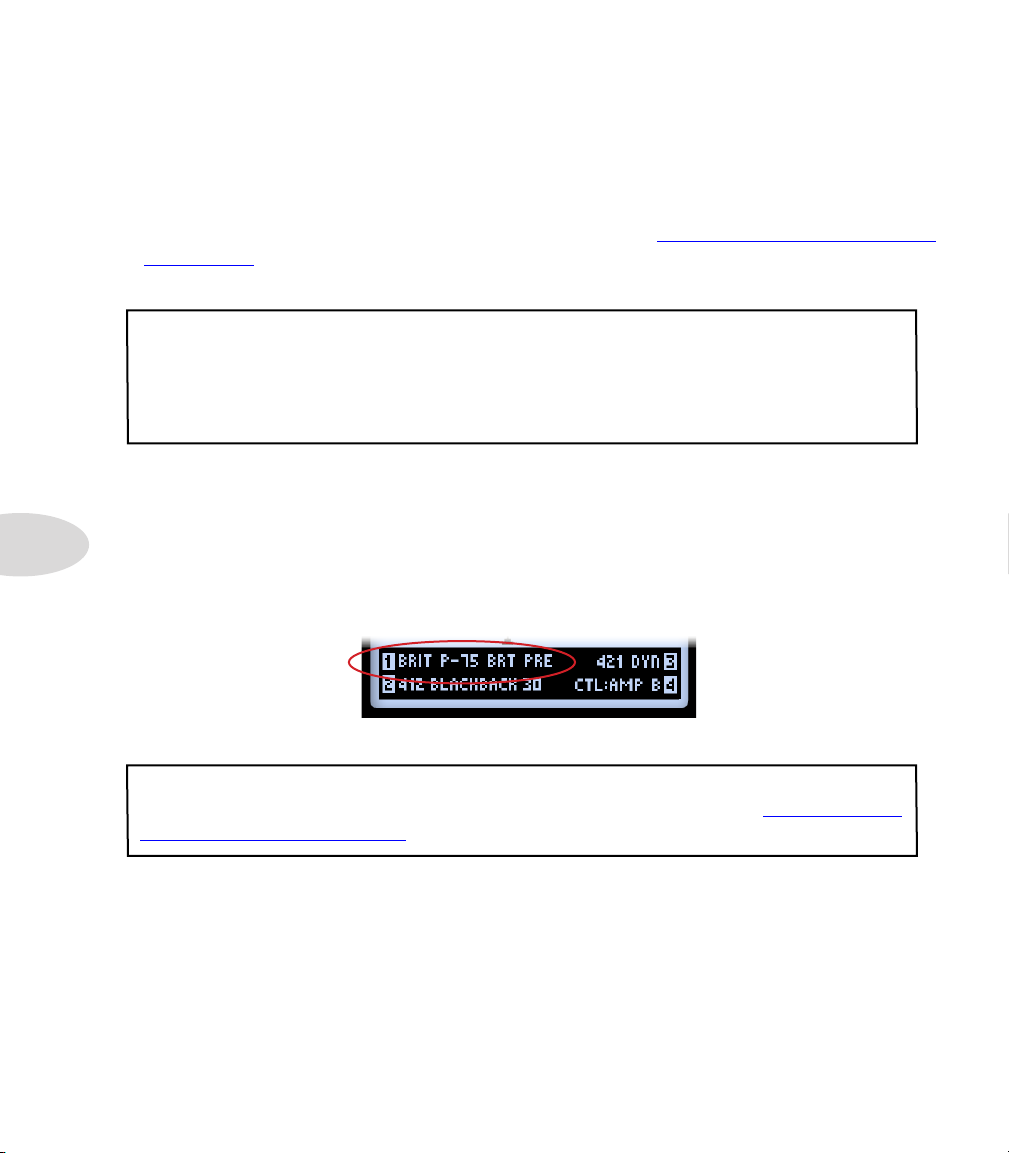
Amp, Cab & Mic Models
• Knob 3 - Selects the Mic Model.
• Knob 4 - When the current Preset includes two Amp models, this selects which
Amp (the Amp within Path A or B) is controlled by the Amp Tone knobs.
As you change the Amp Model (Knob 1), you’ll also see that default Cab and Mic models
are automatically selected for each Amp or Preamp (see “About Default Amp Settings”
on page 6•5). But you can use Knobs 3 & 4 to select any Cab and/or Mic you like. These
settings are saved per Preset.
Attention Bass Players: Try the Flip Top Bass Amp Model for some thump! Note that this
Model loads with a matching 1x15 Flip Top speaker cab, as well as a full set of Mic Model
options for stellar bass tones. (And yes, you can indeed select any other Cab with the Flip
Top Bass Amp Model, or choose the Flip Top Cab with any Guitar Amp Model!) See the
following sections for details about these models.
Amp and Preamp Models
6•4
We’ve included a complete set of “Preamp” versions of each Amp as well. Choose one
of these to obtain the tone of just the preamp stage of the amp - recommended when
feedingyourPODHDProoutputintoanexternalamplier,orwhenusingtheL6LINK™
connection.*
A Preamp Model is selected for Amp B
*Note that, whether an Amp or Preamp is selected, the additional application of Cab and
Mic Models is dependent upon the SETUP:OUTPUT settings. Please see “Page 4, Setup:
Output Options” on page 2•8
.
The overall volume levels among the different Preamp Models varies - this is normal. The
Preamp sections of each of the classic amplifiers we modeled are indeed quite different,
and we’ve set the Preamps’ default values to best match the type of power amp into which
they are intended to feed. Tweak the DRIVE and VOLUME knobs to optimize the level
for your specific needs!
Page 53

Amp, Cab & Mic Models
Amp Block States
The Amp Blocks have 3 available states: On, Off (bypassed) or Disabled (sometimes
referred to as a “Null” state for the Block).
Amp Block “On” Amp Block “Off” Amp Block “Disabled” (Null Block)
About Default Amp Settings
Whenever you change to a different Amp or Preamp Model, predetermined Cab &
Mic models are automatically loaded, as well as Amp Tone Knob settings, designed to
complement the Amp type. As noted throughout this chapter, you can certainly switch to
a different Cab and/or Mic Model - just be sure to save your Preset to retain these changes.
Mic Models
6•5
TofollowisalistofallMicModels.NotethatallGuitarAmp’sCabsofferaselectionof8
Mics,andthe1x15FlipTopBassCaboffersitsownselectionof8MicModels.
Mic Model Descriptions
Mic Name Based On...*
Guitar Cab Mic Models
57 On Xs
57 Off Xs
409 Dyn
421 Dyn
4038 Rbn Coles 4038 Ribbon
121 Rbn
67 Cond
87 Cond
*
All product names used in this manual are trademarks of their respective owners, which are in no way associated or affiliated with Line 6. These trademarks of other manufacturers are used solely to identify the products of those manufacturers whose tones and sounds were
studied during Line 6’s sound model development. Shure® is a registered trademark of Shure Incorporated, Sennheiser® is a registered trademark of Sennheiser Electronic Corporation, Neumann® is a registered trademark of Georg Neumann GMBH, Royer® is a registered
trademark of Bulldog Audio, Inc. DBA Rover Labs
Shure® SM57 Dynamic, On Axis
Shure® SM57 Dynamic, Off Axis
Sennheiser® MD 409 Dynamic
Sennheiser® MD 421 Dynamic
Royer® 121 Ribbon
Neumann® U67 Condenser
Neumann® U87 Condenser
Page 54
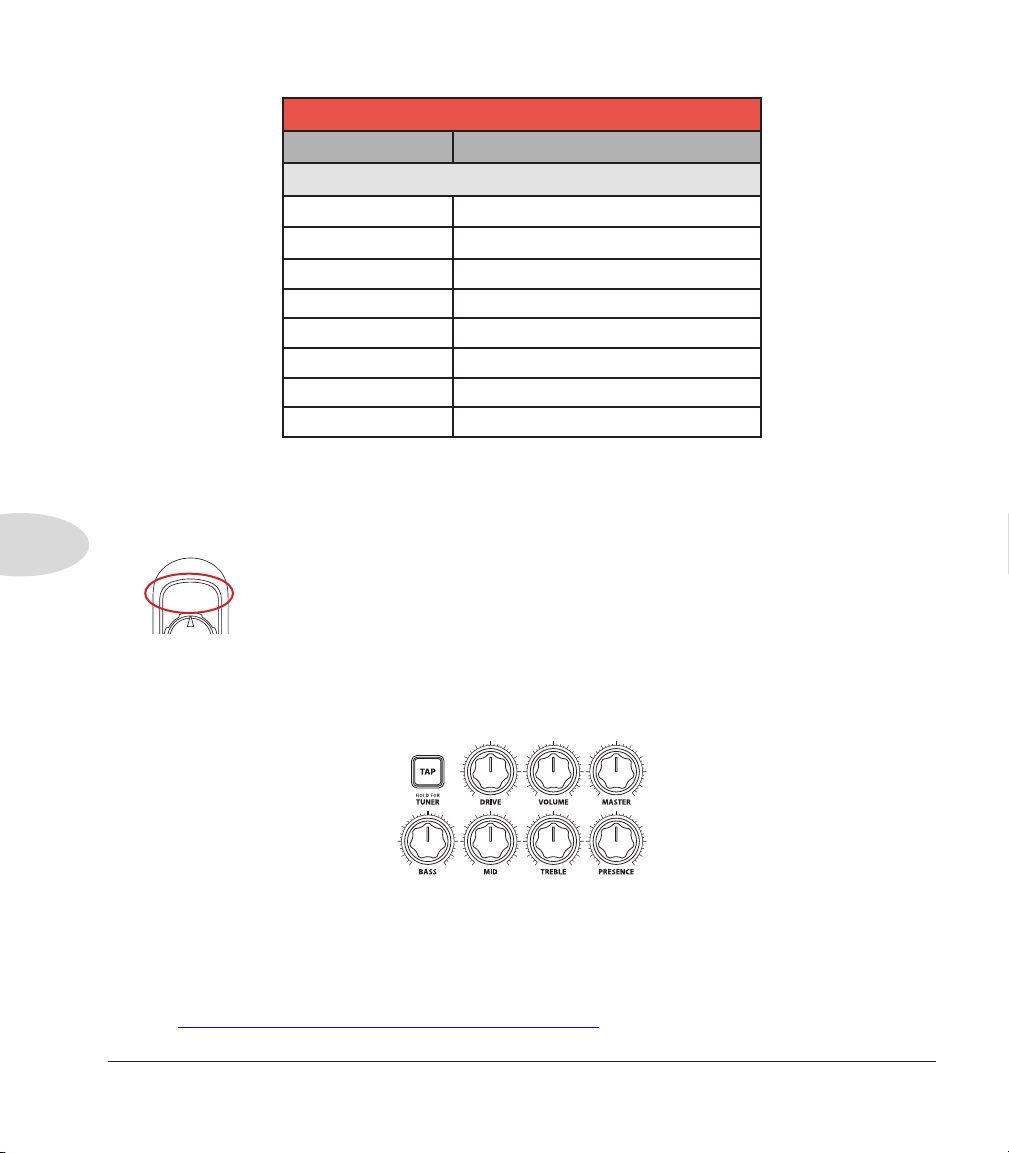
Amp, Cab & Mic Models
Editing Amp Parameters
Mic Model Descriptions
Mic Name Based On...*
Bass Cab Mic Models
57 On Xs
421 Dyn
12 Dyn AKG® D12
112 Dyn AKG® D112
20 Dyn EV® RE20
7 Dyn Shure® SM7B
40 Dyn Heil® PR40
47 Cond Neumann® U47
Shure® SM57 Dynamic, On Axis
Sennheiser® MD 421 Dynamic
6•6
To toggle the selected Amp model On or Off
Press the ENTER - AMP ON/OFF button once. Toggling the Amp “Off” results
ENTER
AMP & FX ON / OFF
in bypassing the Amp, Cab and Mic processing.
To adjust the Amp Tone
Turn any of the Amp Tone knobs to adjust the desired settings for the selected Amp.
The Amp Tone knobs: DRIVE, VOLUME, BASS, MID, TREBLE and PRESENCE
Whenever you adjust any of the Amp Tone knobs, you’ll see the “Momentary” AMP:
EDIT LCD screen temporarily displayed, showing the actual values of the Tone knobs for
both current Amp A & Amp B Models (depending on your Amp Knobs Display setting,
see “Page 1, Setup:Utilities Options” on page 2•2). Also see the next section for more
about the AMP: EDIT options.
*
All product names used in this manual are trademarks of their respective owners, which are in no way associated or affiliated with Line 6. These trademarks of other manufacturers are used solely to identify the products of those manufacturers whose tones and sounds were
studied during Line 6’s sound model development. Shure® is a registered trademark of Shure Incorporated, Sennheiser® is a registered trademark of Sennheiser Electronic Corporation, Neumann® is a registered trademark of Georg Neumann GMBH, Royer® is a registered
trademark of Bulldog Audio, Inc. DBA Rover Labs
Page 55
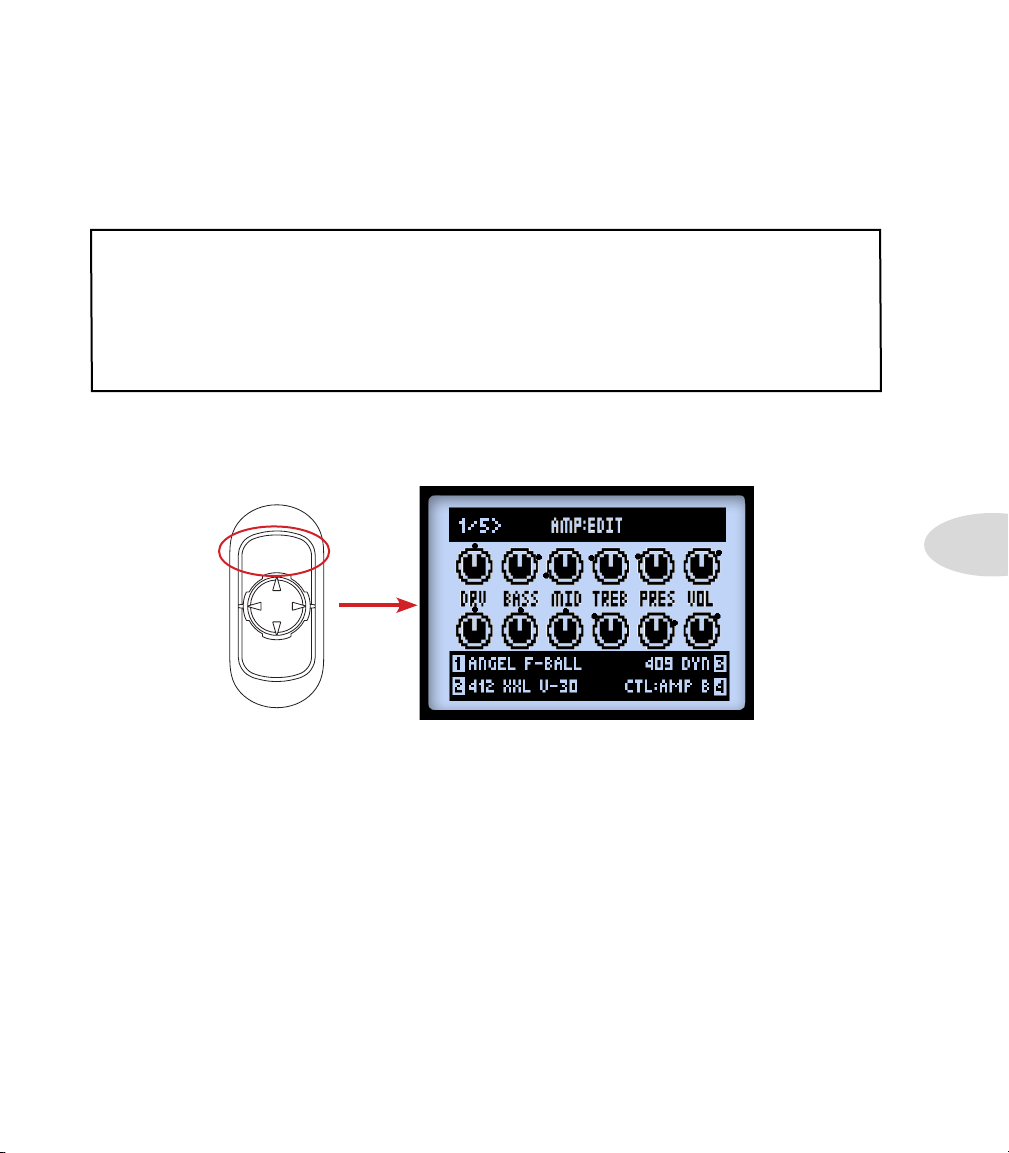
Amp, Cab & Mic Models
Amp & Cab Edit Display
Double-press the ENTER button to access the Amp & Cab Edit screens. You’ll see up to 5
pages of options here, allowing you to fine-tune Amp, Cab and Mic settings.* All settings
in these screens are saved per Preset.
*Note: When the selected Amp Model is a “full” Amp Model, you will see five Amp Edit
pages, with pages 2 & 3 offering additional “deep-editing” power amp-related functions,
and pages 4 & 5 offering deep-edit Cab functions, as described below. When the selected
Amp Model is a Preamp, you will see only three Amp Edit pages, which offer the same
options as the Amp/Cab Edit pages 1, 4 and 5 described below. Use the Nav. Disc left &
right arrow buttons to access all available pages.
Amp Edit - Page 1
ENTER
AMP & FX ON / OFF
DBL PRESS TO ASSIGN CTL
MOVE
Page 1 of the Amp:Edit Screen - both Amps are On
• With both Amp Models On: You’ll see the screen’s respective controls update as
you adjust the Amp Tone knobs, as shown above. Note that the black “dots” around
each knob indicate its last-saved value. You can also still access the Amp, Cab &
Mic Model and Amp A/B selections via the Multi-function Knobs 1-4 while this
screen is displayed.
6•7
Page 56

Amp, Cab & Mic Models
• With an Amp Model Off: You’ll see only a VOL knob, as shown above for Amp A.
This is a separate parameter strictly for the Amp Model’s Bypass Volume. Use the
VOLUME knob on your device to adjust this, and its value is stored separately with
the Preset for whenever the Amp Block is Bypassed.
Note that the VOLUME knob does not control the level at all for a “Null” Amp Block.
6•8
• Use the Multi-Function knobs 1 - 4 to adjust the options at the bottom of the screen:
• Knob 1: Select the desired Amp or Preamp Model.
Page 1 of the Amp:Edit Screen - Amp A Bypassed
• Knob 2: Select the desired Cab Model (also see the Page 4 options).
• Knob 3: Select the desired Mic Model (also see the Page 4 options).
• Knob 4: Choose between adjusting controls for Amp A or Amp B. (This option
is available on all AMP EDIT screens.)
Page 57
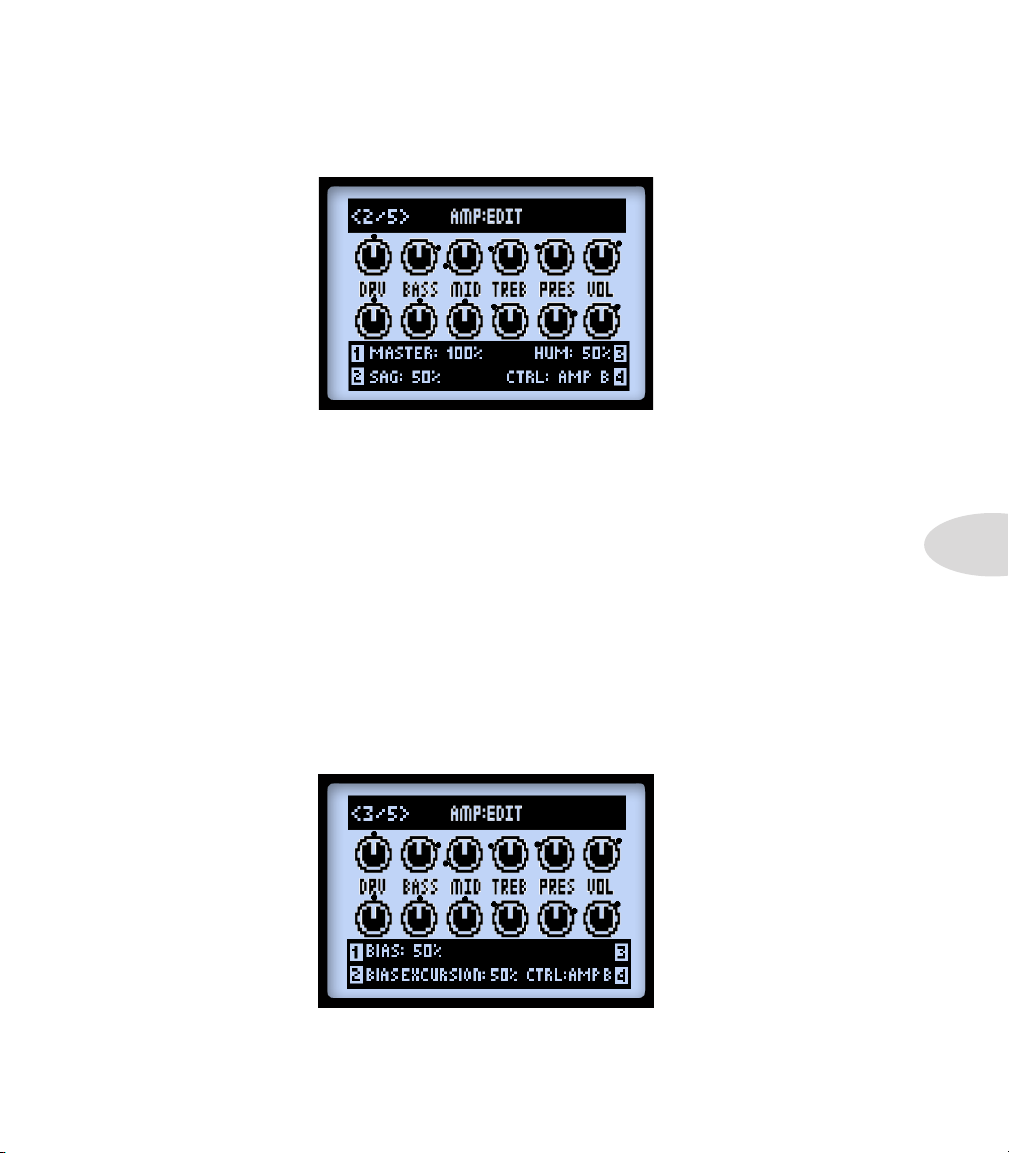
Amp, Cab & Mic Models
Amp Edit - Page 2
Page 2 offers three options that affect the power amp characteristics of your Amp Model.
Page 2 of the Amp:Edit Screen (not displayed for Preamp Models)
• Knob 1: Use this Master Volume to adjust the amount of power amp distortion. This
parameter is highly interactive with all other power amp parameters - the lower the
Master is set, the less effect the other controls will have.
• Knob 2: Setting the Sag to minimum offers a “tighter” responsiveness, and turning
clockwise provides more “touch” dynamics & sustain.
• Knob 3: Controls how much heater hum & AC ripple interacts with your tone. At
the maximum setting things get really freaky.
6•9
Amp Edit - Page 3
Page 3 offers two more options that affect the power amp characteristics.
Page 3 of the Amp:Edit Screen (not displayed for Preamp Models)
Page 58

Amp, Cab & Mic Models
• Knob 1: Changes the Bias of the power tubes. Set to minimum to achieve a very
“cold” Class AB biasing. At maximum the amp is operating in Class A.
• Knob 2: The Bias Excursion determines how the power amp tubes’ voicing reacts
when they are pushed hard. Set low for a tighter feel. Set high for more tube
compression. This parameter is highly reactive with the DRIVE & MASTER settings.
• Knob 3: Has no function on this page.
Amp Edit - Page 4
Here you’ll find Microphone and Speaker Cabinet options.
6•10
Page 4 of the AMP:EDIT Screen (appears as Page 2 for Preamp Models)
NOTE: If you selected “No Cab” for your Cab Model, these Mic and Early Reflections
settings will perform no function since no Speaker, Mic or Early Reflections processing is
applied.
• Knob 1: Sets the amount of “early reflections.” Higher values add more reflective
room sound to your Amp tone.
• Knob 2: Applies low frequency attenuation - helpful to tighten up the low end of
your tone.
• Knob 3: Selects the Mic type (see the Mic Model table on page 6•5).
Press the HOME button, or double-press the ENTER button to exit the AMP:EDIT screen
when done. Be sure to save your Preset to retain customized Amp Model settings.
Page 59

Amp, Cab & Mic Models
Amp Edit - Page 5
Here you’ll find even further “deep-editing” parameters for the Speaker Cab, allowing you
to surgically refine the the feel and frequency response to your personal taste.
• Knob 1: Adjusts the overall level of the modeled speaker Resonance, which results
in a more “lively,” brighter response on higher settings. Increasing the Resonance
Level will cause the overall volume to increase as well.
• Knob 2: Adjusts the low frequency level of the modeled speaker resonance. Just as
the name implies, increasing the value on this knob adds more low end “Thump” to
the Cab tone.
• Knob 3: Adjusts the Decay time of the modeled speaker resonance. This control
provides the feel of a “tighter” speaker cone at lower values and a “looser” speaker
at higher values.
Note: The above three Cab parameters are interactive - As the Resonance Level is decreased
so are the effects of the Thump and Decay parameters. Thump and Decay are applied to
the modeled speaker resonance, therefore, if the Resonance Level is set to a minimum, the
effects of Thump and Decay parameters will not be audible.
Resonance Level, Thump, and Decay controls will only be audible when the POD is in
Studio/Direct output mode.
6•11
Page 60

Amp, Cab & Mic Models
Amp/Preamp Models
To follow is a table showing the classic amplifiers upon which all our HD Amp/Preamp
Models are based.* For more details, please also check out the POD HD Model Gallery,
available from http://line6.com/support/manuals/.
Amp/Preamp Model Based On...*
Amp Disabled When selected, no Amp Model is loaded
Blackface Double Normal ‘65 “Blackface” Fender® Twin Reverb®, Normal input channel
Blackface Double Vibrato ‘65 “Blackface” Fender® Twin Reverb®, Vibrato input channel
Hiway 100 Hiwatt® Custom 100
Super O ‘60s Supro® S6616
Gibtone 185 Gibson® EH-185
Tweed B-Man Normal ‘59 Fender® Tweed Bassman®, Normal input channel
Tweed B-Man Bright ‘59 Fender® Tweed Bassman®, Bright input channel
6•12
Blackface ‘Lux Normal Fender® “Blackface” Deluxe Reverb®, Normal input channel
Blackface ‘Lux Vibrato Fender® “Blackface” Deluxe Reverb®, Vibrato input channel
Divide 9/15 Divided By 13 9/15
PhD Motorway Dr. Z® Route 66
Class A-15 ‘61 “Fawn” Vox® AC-15
Class A-30 TB Vox® AC-30 “Top Boost”
Brit J-45 Normal ‘65 Marshall® JTM-45 MkII, Normal input channel
Brit J-45 Bright ‘65 Marshall® JTM-45 MkII, Bright input channel
Plexi Lead 100 Normal ‘59 Marshall® “Plexi” Super Lead 100, Normal input channel
Plexi Lead 100 Bright ‘59 Marshall® “Plexi” Super Lead 100, Bright input channel
Brit P-75 Normal Park 75, Normal input channel
Brit P-75 Bright Park 75, Bright input channel
Brit J-800 Marshall® JCM-800
Bomber Uber 2002 Bogner Uberschall
Treadplate Mesa/Boogie® Dual Rectifier®
Angel F-Ball Engl® Fireball 100
Line 6 Elektrik A face-melting Line 6 original
Flip Top Ampeg® B-15NF Portaflex® bass guitar amp
POD HD Amp/Preamp Models
* All product names are trademarks of their respective owners, which are in no way associated or affiliated with Line 6. These product names and descriptions are provided for the sole purpose of identifying the specific products that were studied during Line 6’s sound model
development. Fender®, Twin Reverb®, Bassman® and Deluxe Reverb® are registered trademarks of Fender Musical Instruments Corporation. Vox® is a registered trademark of Vox R&D Limited. Marshall® is a registered trademark of Marshall Amplification Plc. Dr. Z®
is a registered trademark of Dr. Z Amps, Inc. Mesa/Boogie® and Dual Rectifier® are registered trademarks of Mesa/Boogie, Ltd. Engl® is a registered trademark of Beate Ausflug and Edmund Engl. Hiwatt® is a registered trademark of Fernandes Company, Ltd. Fane® is a
trademark of Fane International. Gibson® is a registered trademark of Gibson Guitar Corp. Supro® is a registered trademark of Zinky Electronics.
Page 61

Amp, Cab & Mic Models
Amp Control Labels
For some Amp Models, you’ll see slightly different labels for the Amp Tone knobs displayed
in the Amp:Edit screen. In the cases where the classic amps we’ve modeled include special
knob controls, we’ve emulated their behaviors accordingly. These are listed as follows...
• Super O: The actual Supro® only has a Drive and a Tone knob, so we mapped Tone
to the MID knob and invented Bass, Treble, and Presence controls:
Super O Amp:Edit screen
• Divide 9/15: The Divided by 13 amp offers two interactive channels. The DRIVE
knob controls the “clean” channel, and the BASS knob is being used as the Drive
knob for the “dirty” channel. The MID & TREBLE knobs behave like the amp’s
Tone & Cut knobs.
6•13
Divide 9/15 Amp:Edit screen
• Class A-15 & Class A-30TB: Following the Vox® design, we’ve labeled the MID
knob as “Cut” for these two Amp Models - turning the knob counter-clockwise
reduces the high-end frequencies.
Class A-15 & Class A-30TB Amp:Edit screen
* All product names are trademarks of their respective owners, which are in no way associated or affiliated with Line 6. These product names and descriptions are provided for the sole purpose of identifying the specific products that were studied during Line 6’s sound model
development. Fender®, Deluxe Reverb®, Twin Reverb® and Bassman® are registered trademarks of Fender Musical Instruments Corporation. Hiwatt® is a registered trademark of Fernandes Company, Ltd. Supro® is a registered trademark of Zinky Electronics. Dr. Z®
is a registered trademark of Dr. Z Amps, Inc. Vox® is a registered trademark of Vox R&D Limited. Marshall® is a registered trademark of Marshall Amplification Plc. Mesa/Boogie® and Dual Rectifier® are registered trademarks of Mesa/Boogie, Ltd. Engl® is a registered
trademark of Beate Ausflug and Edmund Engl.
Page 62
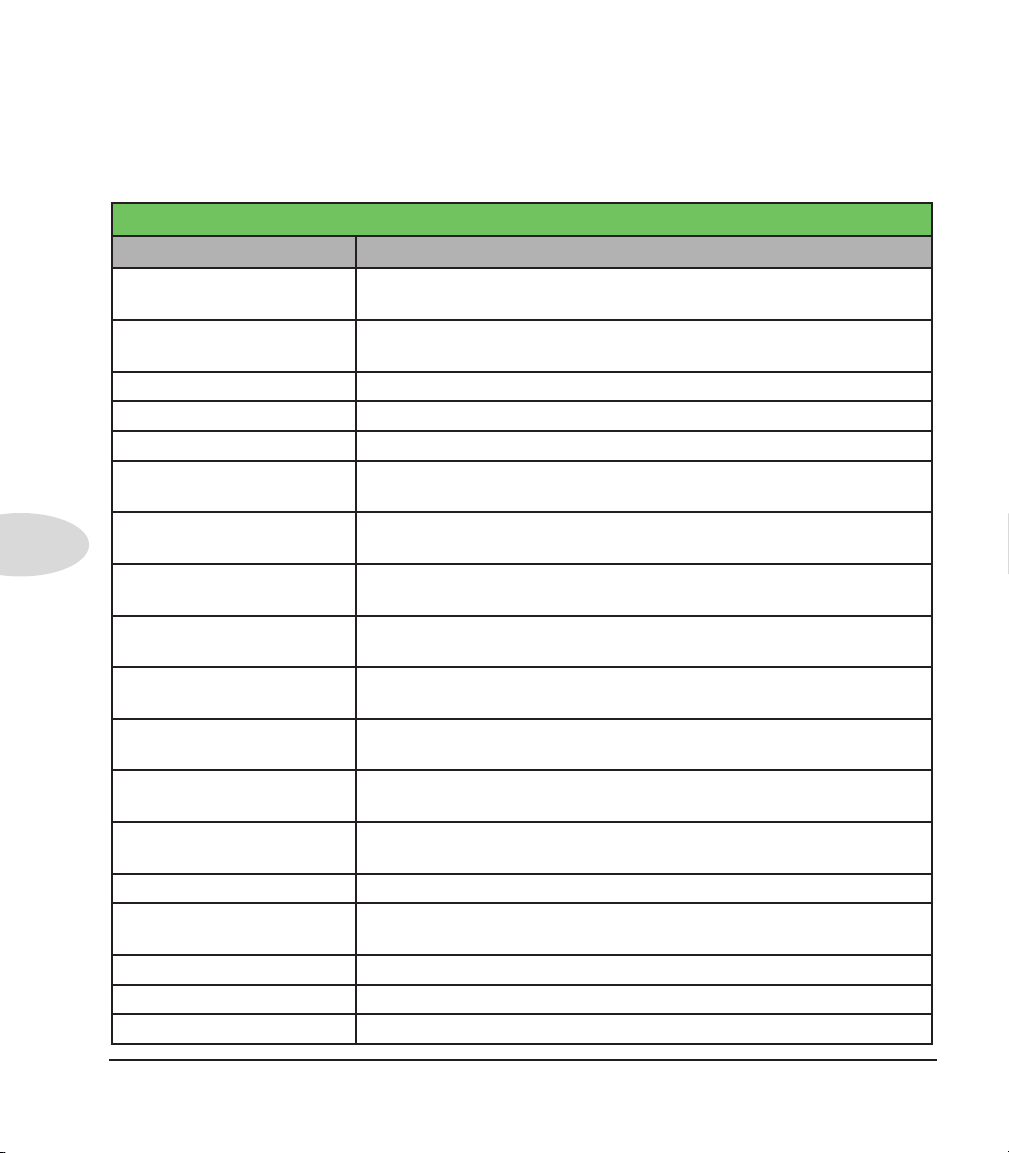
Amp, Cab & Mic Models
Cab Models
To follow is a table showing the classic speaker cabinets upon which our Cab Models are
based.*
Cab Model Based On...*
No Cab Choosing this option applies no Speaker, Mic or Early Reflections
212 Blackface Double Fender® “Blackface” Twin Reverb® combo cabinet, 2x12 inch
412 Hiway Hiwatt® cabinet, 4x12 inch Fane® 12287 50 watt speakers
6x9 Super O Supro® S6616 combo cabinet, one “6x9” size speaker
112 Field Coil Gibson® EH-185 combo cabinet, 1x12 Field Coil Speaker
410 Tweed ‘59 Fender® Tweed Bassman® combo cabinet, 4x10 inch Jensen®
112 BF ‘Lux Fender® “Blackface” Deluxe Reverb® combo cabinet , one 12 inch
6•14
112 Celest 12-H Divided By 13 9/15 combo cabinet, one 12 inch Celestion® G12H
212 PhD Ported Dr. Z®, Z Best cabinet, 2x12 inch Celestion® speakers (one G12H
112 Blue Bell ‘61 “Fawn” Vox® AC-15 combo cabinet, one 12 inch Celestion®
212 Silver Bell Vox® AC-30 “Top Boost,” 2x12 inch Celestion® Alnico Silver Bell
412 Greenback 25 Marshall® cabinet, 4x12 inch Celestion® G12M “Greenback”
412 Blackback 30 Marshall® cabinet, 4x12 inch Celestion® Rola G12H30W
412 Brit T-75 Marshall® cabinet, 4x12 inch Celestion® G12T75 speakers
412 Uber Bogner Uberschall cabinet, 4x12 inch Celestion® speakers (2 x
412 Tread V-30 Mesa/Boogie® cabinet, 4x12 inch Celestion® Vintage 30 speakers
412 XXL V-30 Engl® Pro cabinet, 4x12 inch Celestion® Vintage 30 speakers
115 Flip Top Ampeg® Custom Design, CTS 15 inch speaker
POD HD Cab Models
processing to your Amp Model.
Jensen® speakers
alnico speakers
Oxford 12K5-6 speaker
Heritage (70th anniversary) speaker
Heritage and one Vintage 30)
Alnico Blue speaker
speakers
speakers
“Blackback” speakers
G12T75 and 2 x Vintage 30 speakers)
* All product names are trademarks of their respective owners, which are in no way associated or affiliated with Line 6. These product names and descriptions are provided for the sole purpose of identifying the specific products that were studied during Line 6’s sound model
development. Fender®, Twin Reverb®, Bassman® and Deluxe Reverb® are registered trademarks of Fender Musical Instruments Corporation. Vox® is a registered trademark of Vox R&D Limited. Marshall® is a registered trademark of Marshall Amplification Plc. Dr. Z®
is a registered trademark of Dr. Z Amps, Inc. Mesa/Boogie® and Dual Rectifier® are registered trademarks of Mesa/Boogie, Ltd. Engl® is a registered trademark of Beate Ausflug and Edmund Engl. Hiwatt® is a registered trademark of Fernandes Company, Ltd. Fane® is a
trademark of Fane International. Gibson® is a registered trademark of Gibson Guitar Corp. Supro® is a registered trademark of Zinky Electronics. Celestion® is a registered trademark of Celestion International Ltd. Jensen® is a registered trademark of Jensen Loudspeakers
and Audiovox Corporation.
Page 63

FX mOdelS
POD® HD Pro includes a plethora of amazing FX Models, primarily from the popular Line
6 M13 Stompbox Modeler! This chapter provides Reference Tables showing all POD HD
Pro FX Models by category, as well as details on their parameters. FX Model parameters are
all accessible within the Edit Mode. Please see “FX Edit Mode” on page 5•1 for details
on Edit Mode features.
TIP: For more details about FX Models, please also check out the POD HD Model
Gallery
manuals/
Dynamics Models
Noise Gate Threshold Decay -- -- -Hard Gate Open Threshold Close Threshold Hold Decay -Tube Comp Threshold Level -- -- -Red Comp Sustain Level -- -- --
Blue Comp Sustain Level -- -- -Blue Comp Treb Sustain Level -- -- -Vetta Comp Sensitivity Level -- -- -Vetta Juice Amount Level -- -- -Boost Comp Drive Bass Comp Treble
and M13 Advanced Guide documents, available from http://line6.com/support/
.
Dynamics FX Models - Parameter Reference Table
Model Parameters
Output
FX Models
7•1
Common Parameters
The following parameters are common to most Dynamics FX Models.
• Threshold: For compressor FX, lower values result in greater compression, along
with an automatic makeup gain stage dependent upon the Threshold setting.
• Sustain: Some compressors include Sustain, which is much the same as a Threshold
control, but functions in reverse - higher settings add more compression and thus
more sustain and squishy goodness.
• Level: Adjusts the overall volume - higher settings typically offer an output boost.
Page 64
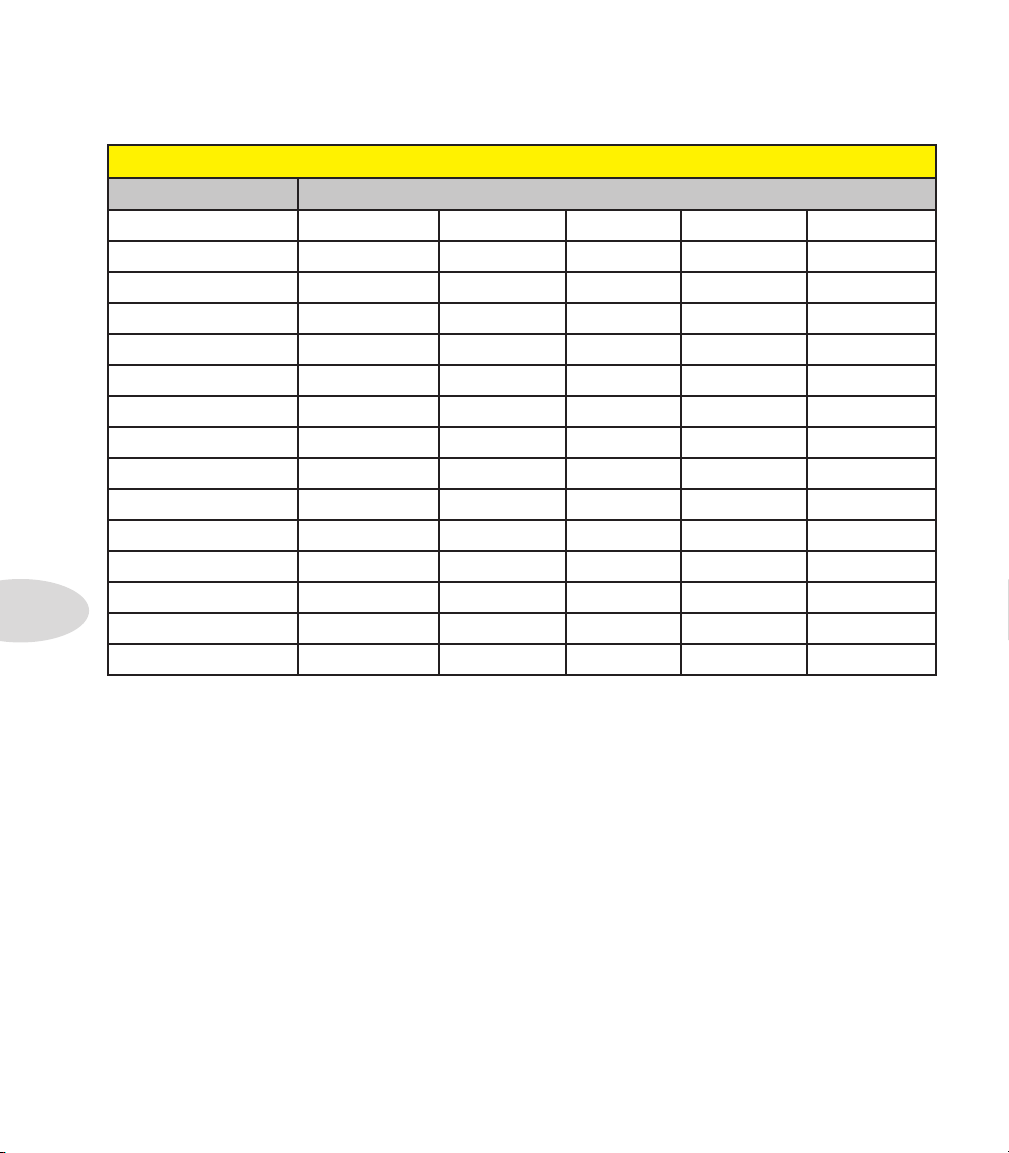
FX Models
Distortion Models
7•2
Distortion Model - Parameter Reference Table
Model Parameters
Tube Drive Drive Bass Mid Treble Output
Screamer Drive Bass Tone Treble Output
Overdrive Drive Bass Mid Treble Output
Classic Dist Drive Bass Filter Treble Output
Heavy Dist Drive Bass Mid Treble Output
Color Drive Drive Bass Mid Treble Output
Buzz Saw Drive Bass Mid Treble Output
Facial Fuzz Drive Bass Mid Treble Output
Jumbo Fuzz Drive Bass Mid Treble Output
Fuzz Pi Drive Bass Mid Treble Output
Jet Fuzz Drive Fdbk Tone Speed Output
Line 6 Drive Drive Bass Mid Treble Output
Line 6 Distortion Drive Bass Mid Treble Output
Sub Octave Fuzz Drive Bass Sub Treble Output
Octave Fuzz Drive Bass Mid Treble Output
Common Parameters
The following parameters are common to most Distortion FX Models.
• Drive: Adjusts the amount of overdrive, distortion or fuzz.
• Bass: Adjusts Bass EQ level
• Mid: Adjusts the Midrange EQ level.
• Treble: Adjusts Treble EQ level.
• Output: Adjusts the overall volume level - higher settings offer an output boost.
Page 65
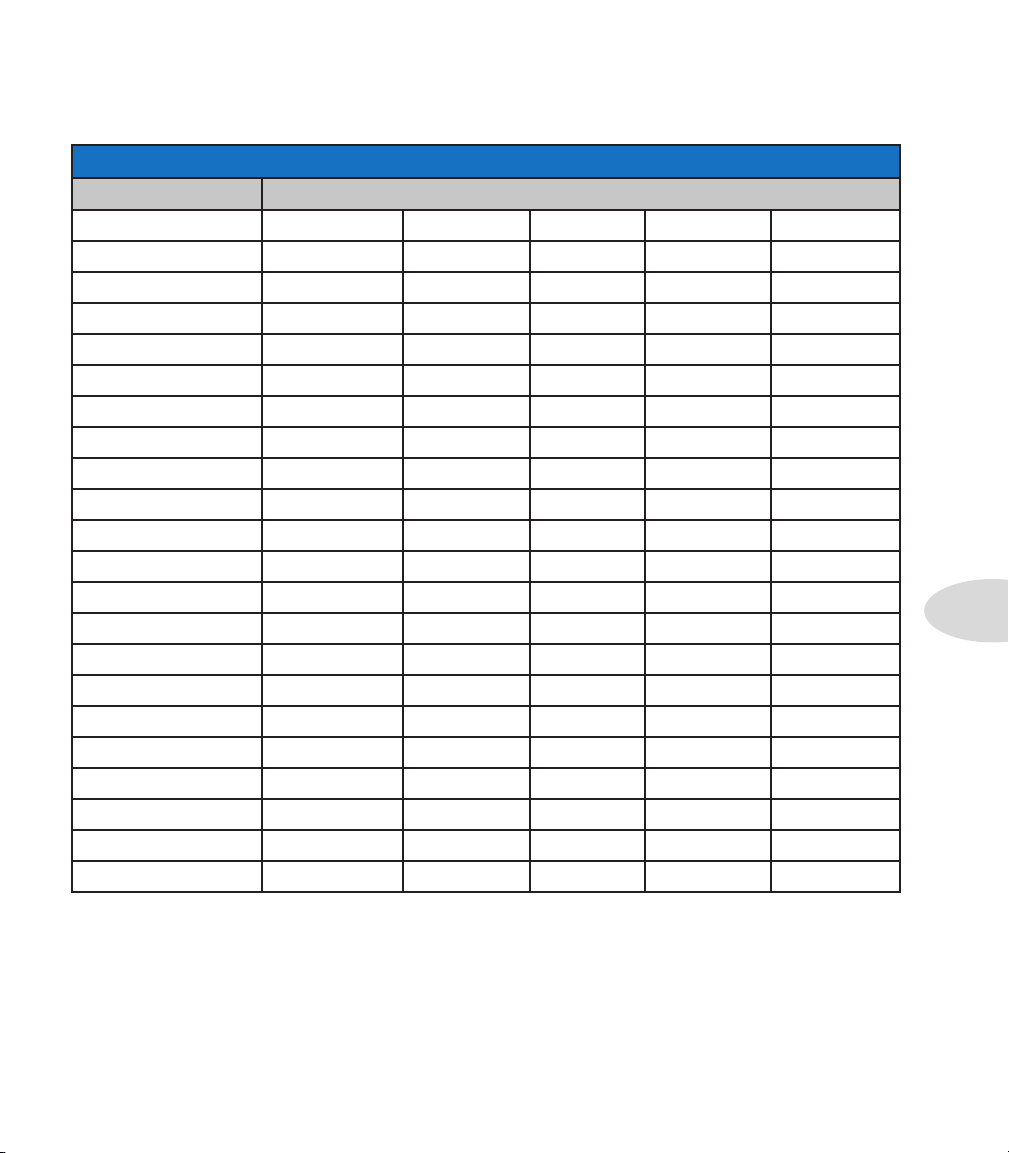
Modulation Models
Modulation Models - Parameter Reference Table
Model Parameters
Pattern Tremolo Speed Step 1 Step 2 Step 3 Step 4
Panner Speed Depth Shape VolSens Mix
Bias Tremolo Speed Level Shape VolSens Mix
Opto Tremolo Speed Level Shape VolSens Mix
Script Phase Speed -- -- -- -Panned Phaser Speed Depth Pan Pan Spd Mix
Barberpole Phaser Speed -- Fdbk Mode Mix
Dual Phaser Speed Depth Fdbk LFO Shp Mix
U-Vibe Speed Depth Fdbk VolSens Mix
Phaser Speed Depth Fdbk Stages Mix
Pitch Vibrato Speed Depth Rise VolSens Mix
Dimension Sw1 Sw2 Sw3 Sw4 Mix
Analog Chorus Speed Depth Ch Vib Tone Mix
Tri Chorus Speed Depth Depth2 Depth3 Mix
Analog Flanger Speed Depth Fdbk Manual Mix
Jet Flanger Speed Depth Fdbk Manual Mix
AC Flanger Speed Width Regen Manual -80A Flanger Speed Range Enhance Manual Even Odd
Frequency Shifter Freq Mode -- -- Mix
Ring Modulator Speed Depth Shape AM/FM Mix
Rotary Drum Speed Depth Tone Drive Mix
Rotary Drm/Hrn Speed Depth Horn Dep Drive Mix
FX Models
7•3
Page 66

FX Models
Common Parameters
The following parameters are common to most Modulation FX Models.
• Speed: Adjusts the modulation/oscillation/tremolo speed for the effect, with higher
settings providing faster rates. Note that the Speed can be adjusted to a Hz value or
Note Division:
• Choosing a Hz value provides a specific modulation speed in cycles per second.
• Choosing a Note Division value provides a time that is based on the current Tap
Tempo (see “Tap Tempo” on page 1•5).
• Depth: Adjusts the intensity of the modulation. Higher settings result in more
extreme pitch bending, wobble or throb, depending on the effect.
• Fdbk (Feedback): The amount of delayed signal that is fed back into the effect.
Higher settings can provide more dramatic textures.
• Mix: Sets the balance of the “Dry” and “Wet” signals. At 0% no effect is added to
your signal; at 100% you will hear the effected signal only. For Chorus, Flanger &
Phase FX, results are typically best with the Mix set between 0 to 50%. For Vibrato,
Tremolo and Rotary FX, try the Mix at 90 - 100%. Feel free to experiment!
7•4
Note that the Script Phase, Pattern Tremolo , AC Flanger & 80a Flanger do not offer a
Mix parameter. Their dry/wet balance is “fixed” just like the classic pedals that inspired
them!
Page 67
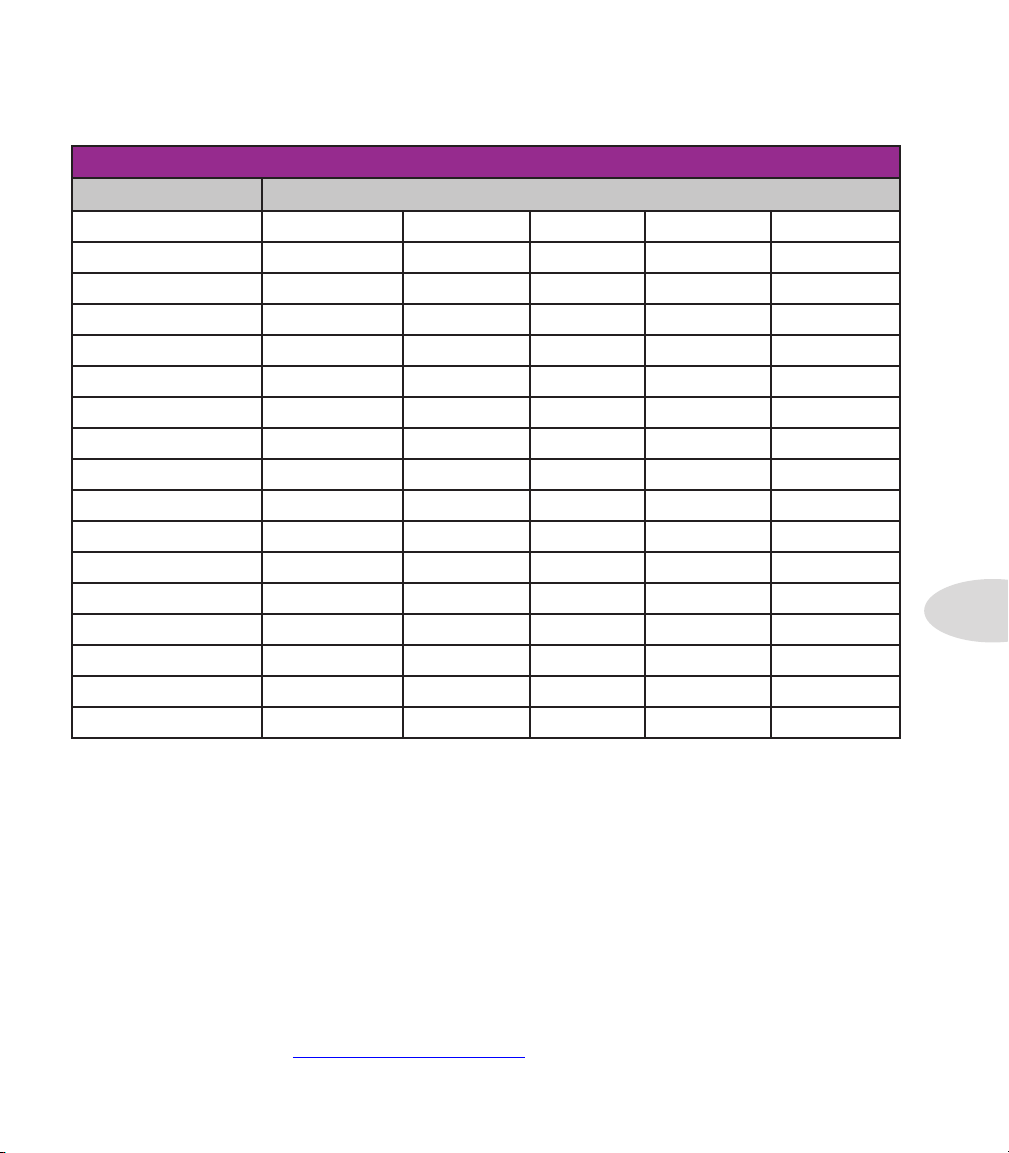
Filter Models
Filter Models - Parameter Reference Table
Model Parameters
Voice Box Speed Start End Auto Mix
V-Tron Start End Speed Mode Mix
Q Filter Freq Q Gain Type Mix
Vocoder Mic Input -- Decay Mix
Seeker Speed Freq Q Steps Mix
Obi Wah Speed Freq Q Type Mix
Tron Up Freq Q Range Type Mix
Tron Down Freq Q Range Type Mix
Throbber Speed Freq Q Wave Mix
Slow Filter Freq Q Speed Mode Mix
Spin Cycle Speed Freq Q VolSens Mix
Comet Trails Speed Freq Q Gain Mix
Octisynth Speed Freq Q Depth Mix
Synth O Matic Freq Q Wave Pitch Mix
Attack Synth Freq Wave Speed Pitch Mix
Synth String Speed Freq Attack Pitch Mix
Growler Speed Freq Q Pitch Mix
FX Models
7•5
Common Parameters
The following parameters are common to most Filter FX Models.
• Frequency: Selects the center frequency used by the effect.
• Q: Adjusts the frequency width of the filter in use.
• Speed: Adjusts the rate of the model’s modulation or oscillators, can be adjusted to
a Hz value or Note Division:
• Choosing a Hz value provides a specific modulation speed in cycles per second.
• Choosing a Note Division value provides a time that is based on the current Tap
Tempo (see “Tap Tempo” on page 1•5)
Page 68
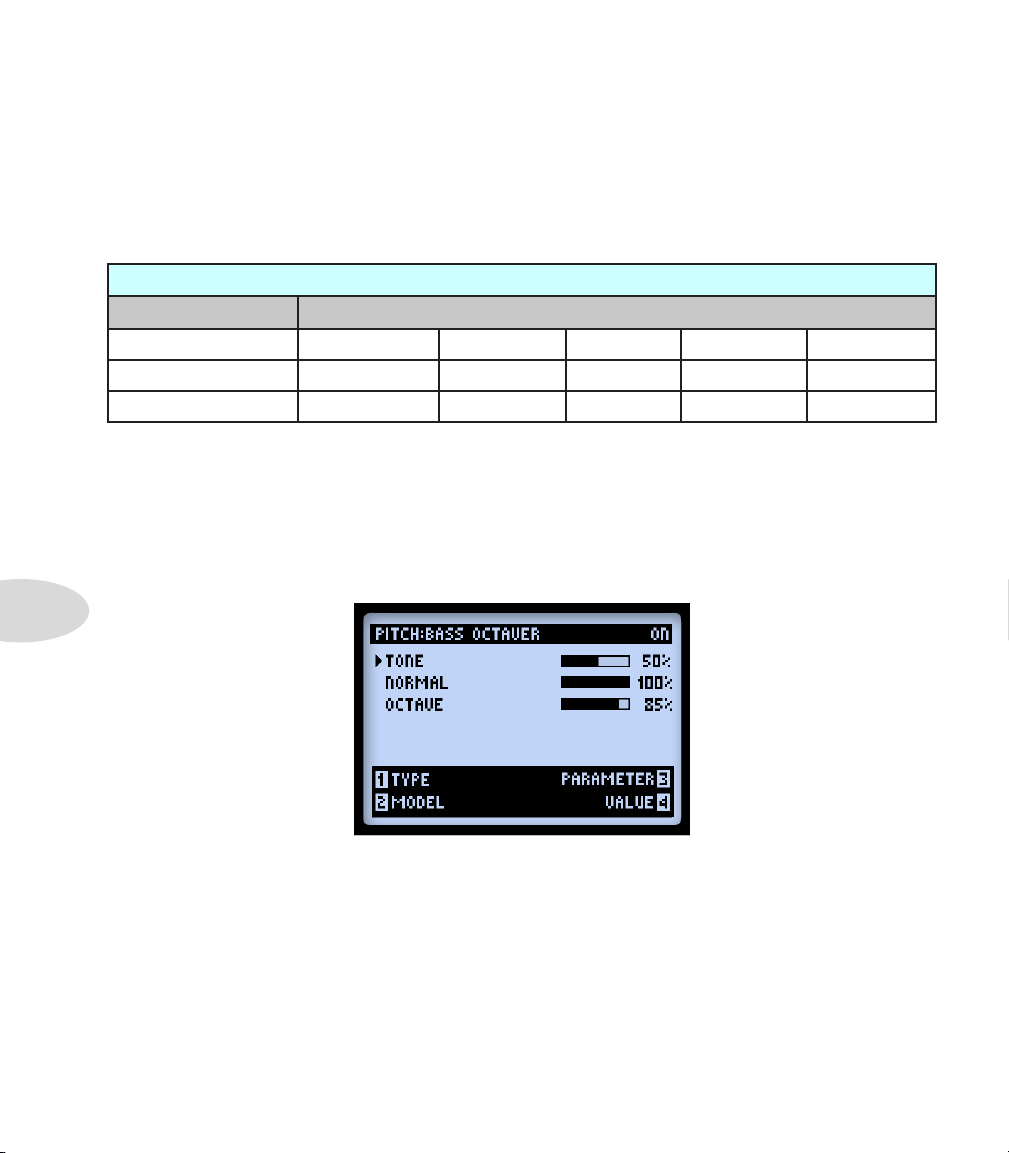
FX Models
Pitch Models
7•6
• Mix: Sets the balance of the “Dry” and “Wet” signals. At 0% no effect is added to
your signal; at 100% you will hear the effected signal only. For most Filter FX, try the
100% setting to achieve the full weirdness factor.
Pitch Models - Parameter Reference Table
Model Parameters
Bass Octaver Tone Normal Octave -- -Pitch Glide Pitch -- -- -- Mix
Smart Harmony Key Shift Scale -- Mix
Pitch FX Model Parameters
Since these FX are a bit more complex, we’ve provided examples of each Pitch FX Model’s
Edit Mode screen and parameter descriptions.
Bass Octaver
• Tone: The overall tone of the effect.
• Normal: Controls the volume of the dry signal.
• Octave: Controls the volume of the processed, octave signal.
Page 69
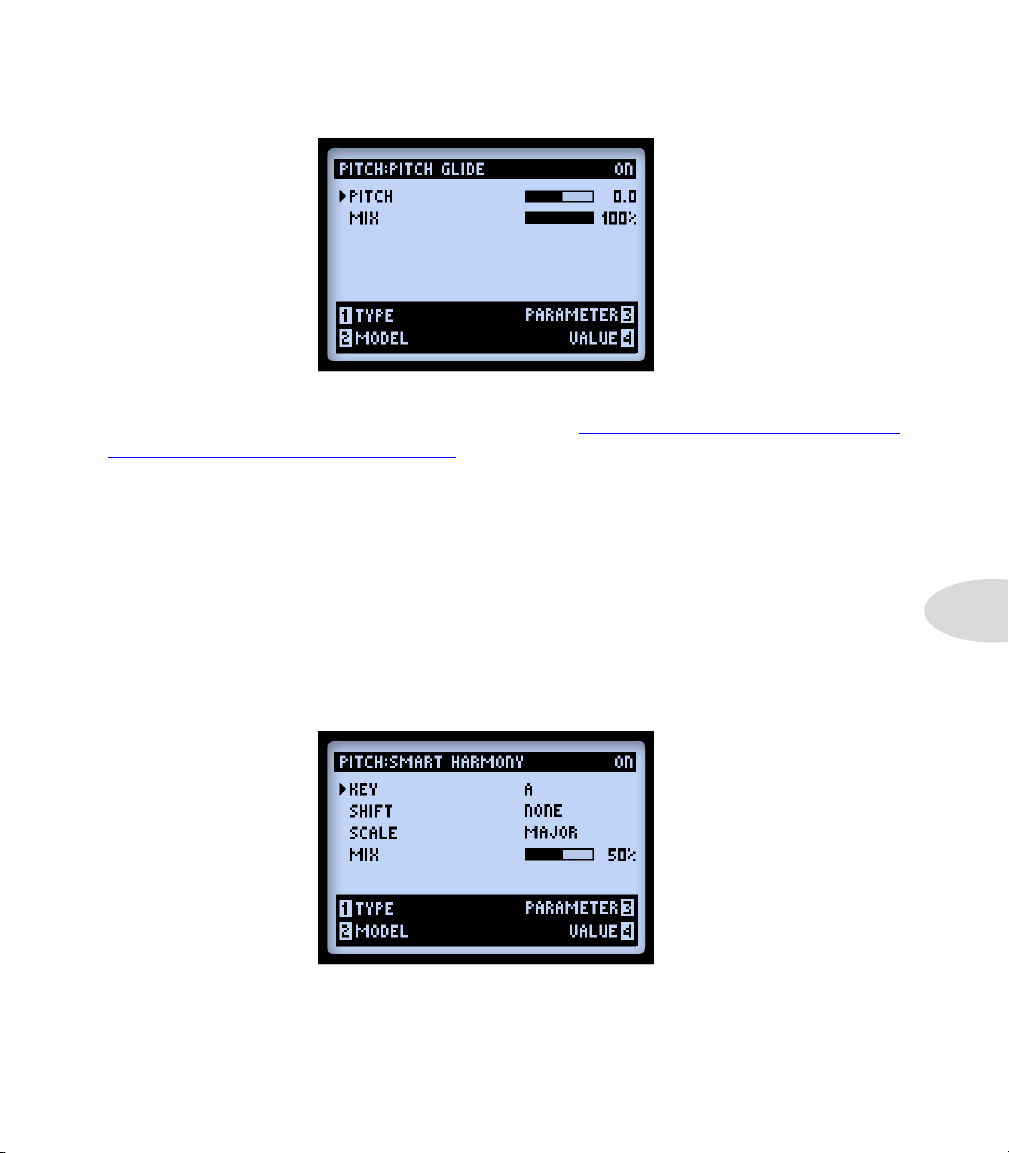
FX Models
Pitch Glide
This effect is best used by assigning a Line 6 FBV™ Pedal Controller to the Pitch parameter
to “wham” out some wild pitch-bending effects (see “Expression Pedal & Variax® Knob
Controller Assignment” on page B•16). However, you can set a specified pitch to add a
static harmony or octave unison note that follows your playing.
• Pitch: Manually lets you select the Pitch of the note that is heard in unison with
your input signal.
• Mix: Controls the balance of wet & dry signals. Set to 100% if you wish to hear only
the pitched signal, or somewhere near 50% to hear both your input signal plus the
pitched signal.
7•7
Smart Harmony
Select a Scale, Key and Shift value and our DSP algorithms will do the rest, producing a
perfect harmony note along with your guitar riffs. The available parameters are:
Page 70
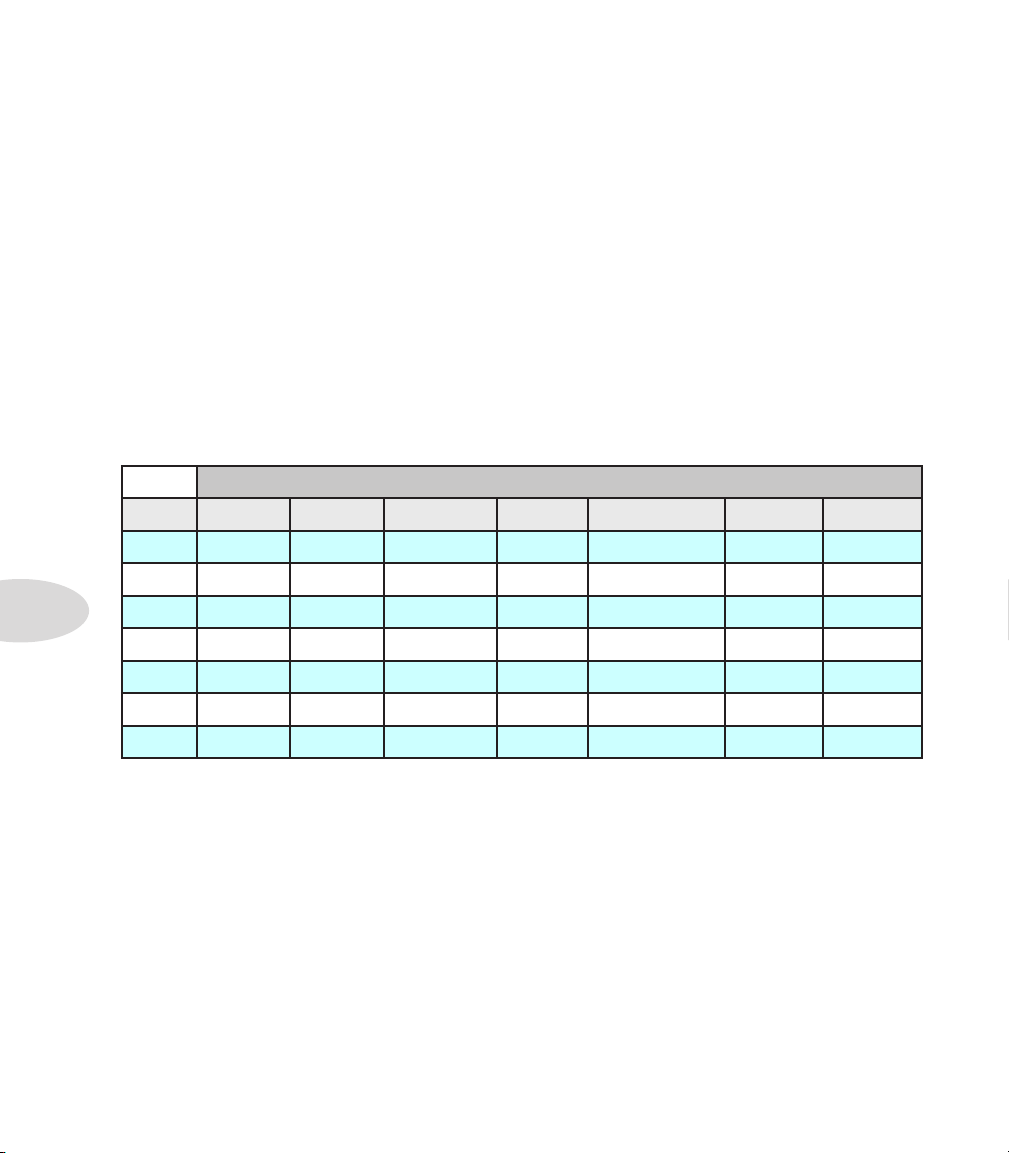
FX Models
7•8
• Key: Select the Key you’ll be playing in.
• Shift: Determines the interval value for the desired harmony note.
• Scale: Select the Scale you’d like to use (see the following instructions and table).
• Mix: Sets the balance or your dry signal + harmony notes.
The Smart Harmony effect automatically detects your guitar’s single-note pitch and shifts
it to match a user-selected Key and Scale. A choice of Keys is provided - Consult the table
below to achieve other scalic modes.
• Choose your Key on the left, then your mode on the top.
• The cell where the two connect is the Key to choose to get to the mode you’d like.
For example, for C - Lydian, the Scale you want is G Major.
Mode
Key Ionian Dorian Phrygian Lydian Mixolydian Aeolian Locrian
A
B
C
D
E
F
G
A Maj G Maj F Maj E Maj D Maj C Maj Bb Maj
B Maj A Maj G Maj Gb Maj E Maj D Maj C Maj
C Maj Bb Maj Ab Maj G Maj F Maj Eb Maj Db Maj
D Maj C Maj Bb Maj A Maj G Maj F Maj Eb Maj
E Maj D Maj C Maj B Maj A Maj G Maj F Maj
F Maj Eb Maj Db Maj C Maj Bb Maj Ab Maj Gb Maj
G Maj F Maj Eb Maj D Maj C Maj Bb Maj Ab Maj
Smart Harmony Model - Scale Reference Table
Page 71
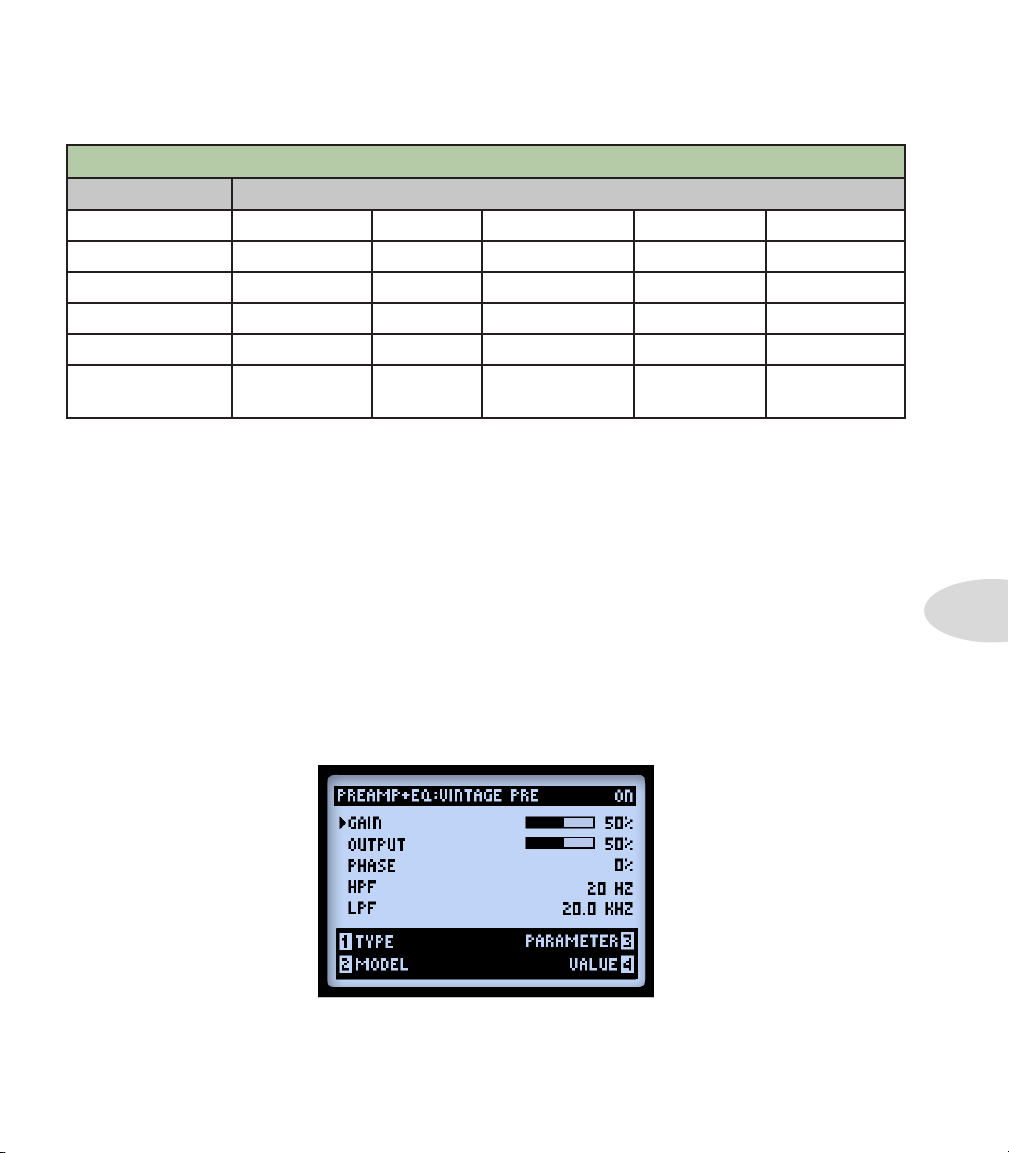
Preamp & EQ Models
Preamp+EQ Models - Parameter Reference Table
Model Parameters
Graphic EQ 80Hz 220Hz 480Hz 1.1kHz 2.2kHz
Parametric EQ Lows Highs Freq Q Gain
Studio EQ Low Freq Low Gain Hi Freq Hi Gain Gain
4 Band Shift EQ Low Low Mid Hi Mid Hi Shift
Mid Focus EQ Hi Pass Freq Hi Pass Q Low Pass Freq Low Pass Q Gain
Vintage Pre Gain Output Phase Hi Pass
Filter
Common Parameters
The following parameters are common to EQ Models.
• Frequency (as well as Low, Mid, High): Selects the center frequency or range for the
particular EQ Band. (The Graphic EQ model includes “fixed” Bands where the gain
is adjustable for each.)
• Q: Adjusts the frequency width or shape of the frequency band filter.
Lo Pass Filter
FX Models
7•9
• Gain: Adjust the output level of the particular Band. (The Gain parameters accessed
by Multi-function Knob #4 adjust the overall output level.)
Vintage Pre
Page 72
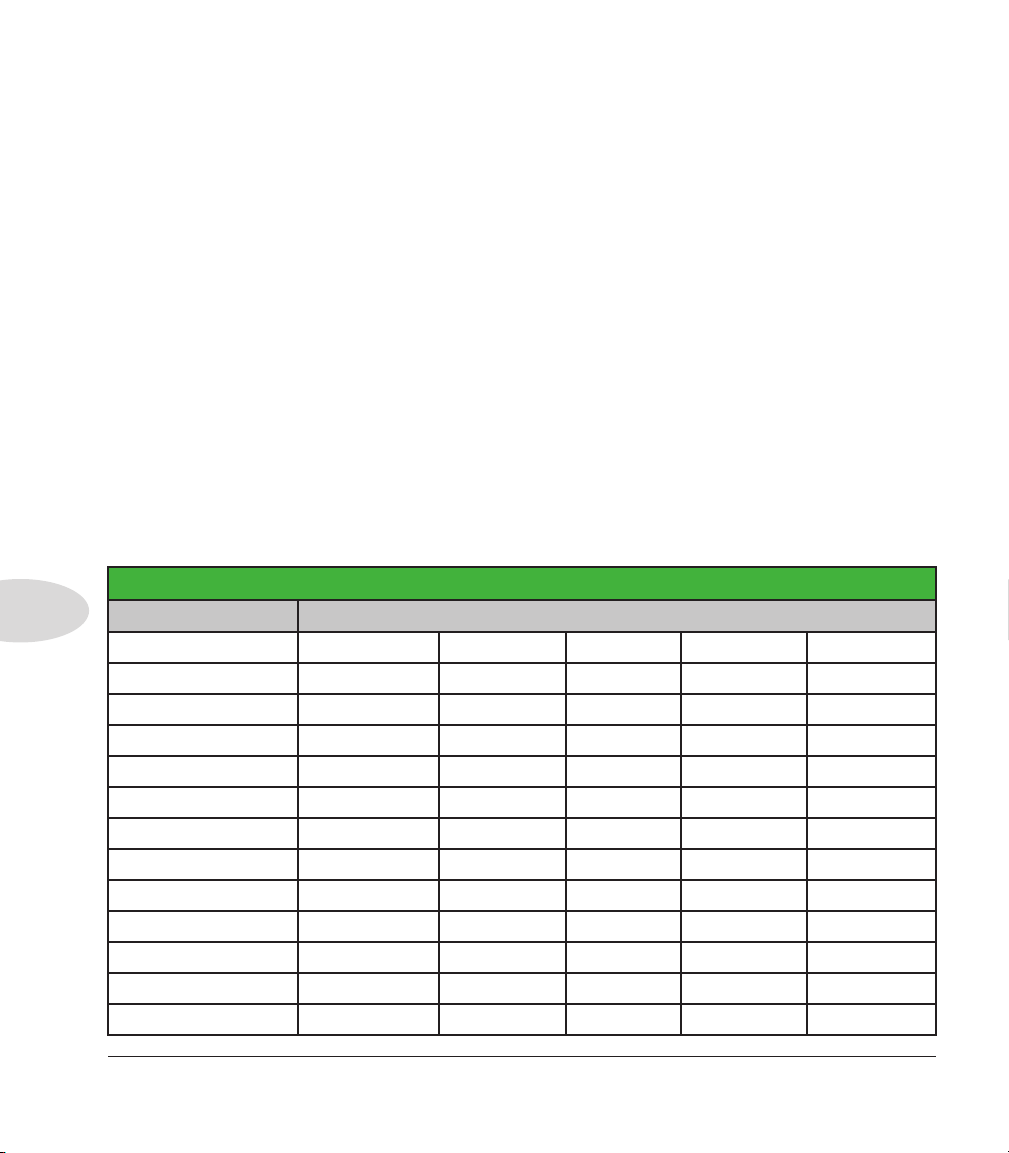
FX Models
7•10
This Model is a vintage-voiced, mono tube mic preamp based on* the Requisite® Y7
vintage Tube Mic Preamp, excellent for use with your Mic source input, Variax acoustic
guitar models, or even in conjunction with Bass or Guitar Amps, anywhere in the signal
path, to provide some nice tube warmth.
• Gain: Dial in the amount of input gain - higher levels will add some tube distortion.
• Output: Determines the final output level, capable of a significant signal boost.
• Phase: Choose 0 for normal, or 180 to reverse the phase. (It can sometimes be
necessary to reverse the phase of one mic’ed signal when combined with another, to
correct for a resulting “hollow,” out-of-phase sound.)
• HPF: A High Pass Filter to reduce bass frequencies. Increase this Hz value to choose
where the low frequency reduction begins.
• LPF: A Low Pass Filter to reduce treble frequencies. Decrease this KHz value to
choose where the high frequency reduction begins.
Delay Models
Delay Models - Parameter Reference Table
Model Parameters
Ping Pong Time Fdbk Offset Spread Mix
Dynamic Dly L Time L Fdbk R Time R Fdbk Mix
Stereo Delay Time Fdbk Thresh Ducking Mix
Digital Delay Time Fdbk Bass Treble Mix
Dig Dly W/Mod Time Fdbk ModSpd Depth Mix
Reverse Time Fdbk ModSpd Depth Mix
Lo Res Delay Time Fdbk Tone Res Mix
Tube Echo Time Fdbk Wow/Flt Drive Mix
Tube Echo Dry Time Fdbk Wow/Flt Drive Mix
Tape Echo Time Fdbk Bass Treble Mix
Tape Echo Dry Time Fdbk Bass Treble Mix
Sweep Echo Time Fdbk Swp Spd Swp Dep Mix
Sweep Echo Dry Time Fdbk Swp Spd Swp Dep Mix
*
Requisite® is a registered trademark of Requisite Audio Engineering.
Page 73
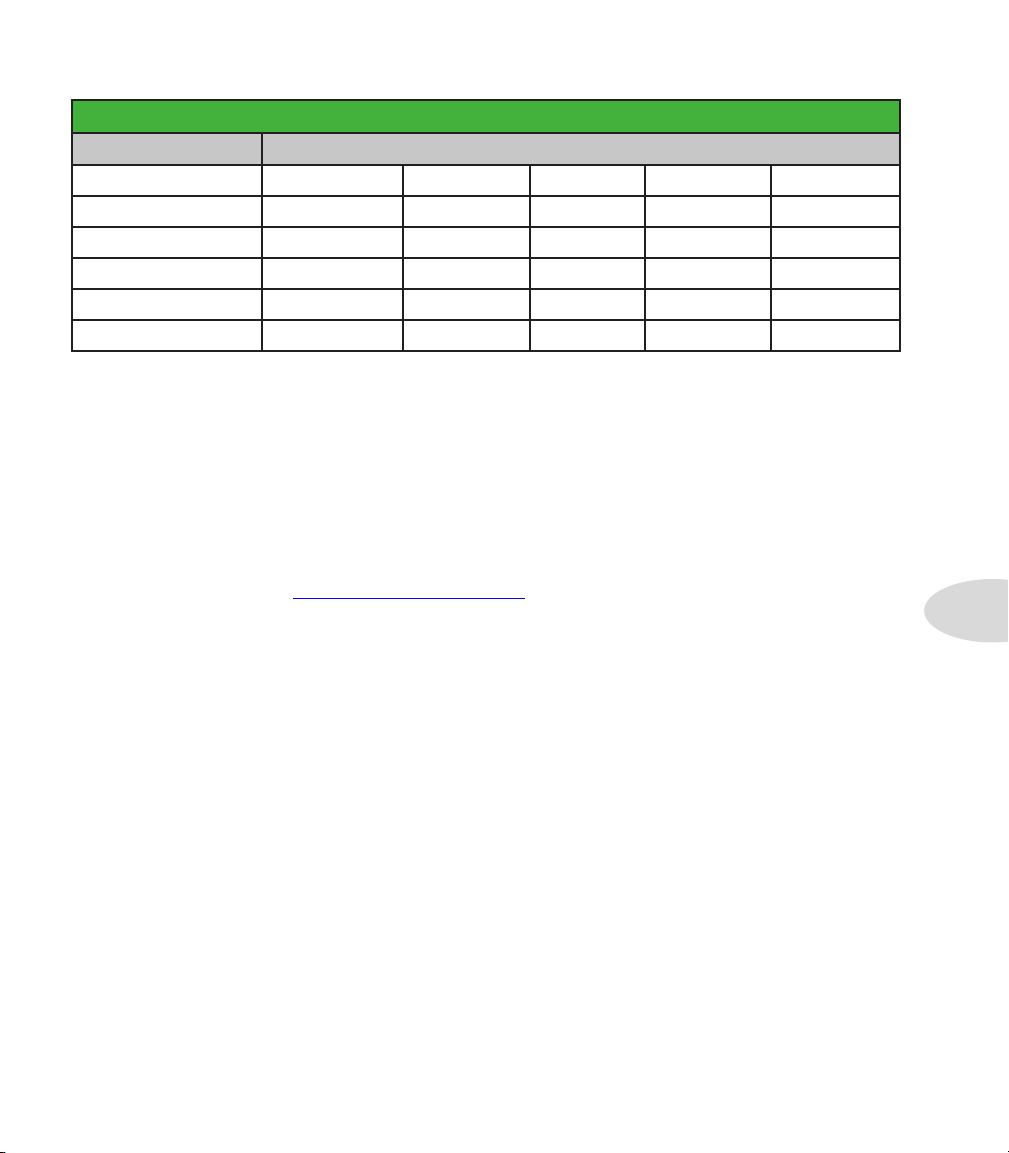
Delay Models - Parameter Reference Table
Model Parameters
Echo Platter Time Fdbk Wow/Flt Drive Mix
Echo Platter Dry Time Fdbk Wow/Flt Drive Mix
Analog W/Mod Time Fdbk ModSpd Depth Mix
Analog Echo Time Fdbk Bass Treble Mix
Auto-Volume Echo Time Fdbk ModDep Swell Mix
Multi-Head Time Fdbk Heads 1-2 Heads 3-4 Mix
Common Parameters
The following parameters are common to most Delay FX Models.
• Time: Adjusts the delay/repeat time, with higher settings providing longer delays.
Time can be adjusted to a MS value or Note Division:
• Choosing a MS value provides a specific time in milliseconds.
• Choosing a Note Division value provides a time that is based on the current Tap
Tempo (see “Tap Tempo” on page 1•5).
• Fdbk (Feedback): Sets the number of delayed repeats.
FX Models
7•11
• Depth: Some delays include modulation. These will typically include a Depth
parameter to adjust the intensity of the pitch modulation applied to the repeats.
• ModSpd: Control the speed of the pitch modulation.
• Mix: Sets the balance of the “Dry” and “Wet” signals. At 0% no effect is added to
your signal; at 100% you will hear the delayed signal only.
Page 74
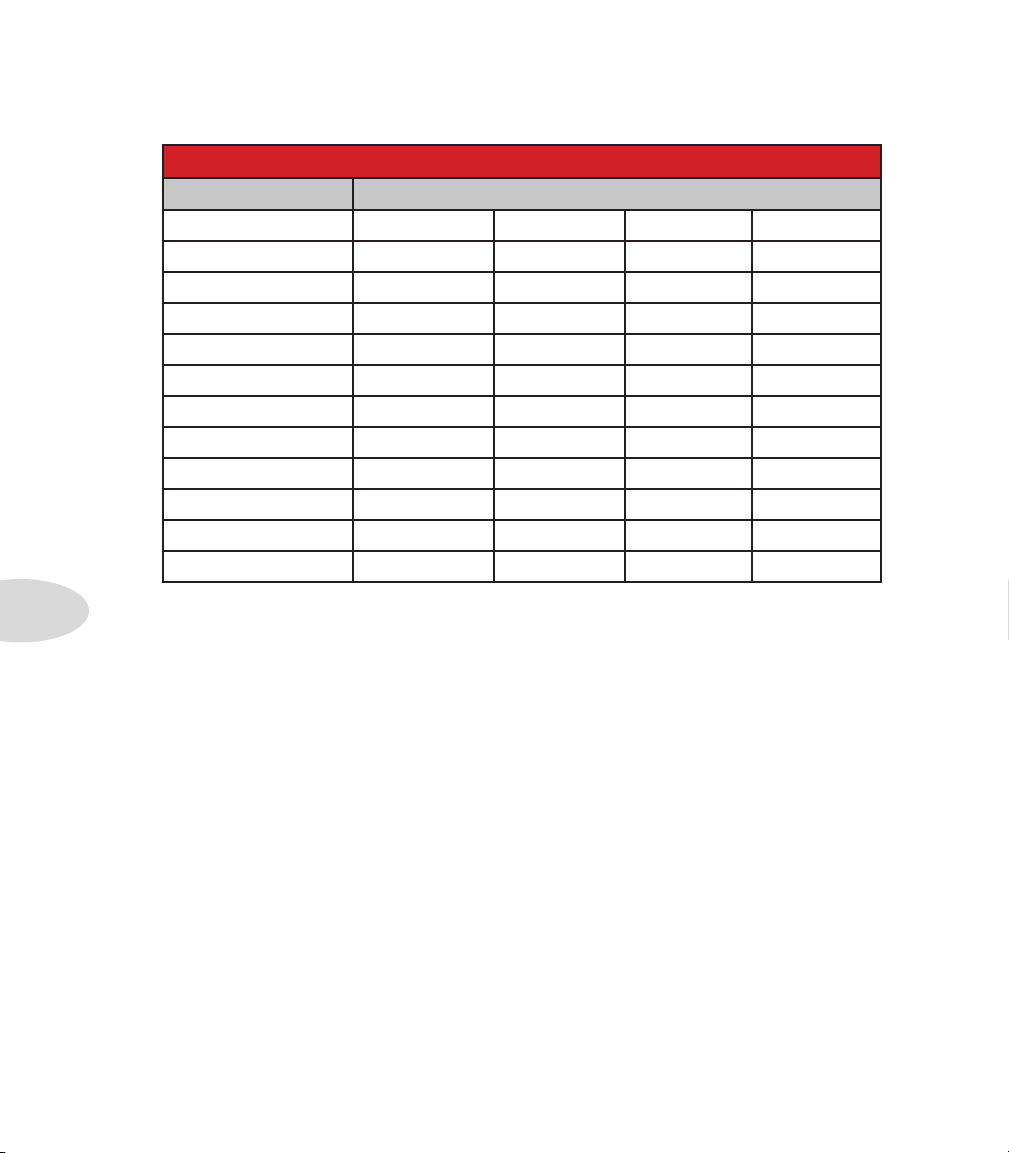
FX Models
7•12
Reverb Models
Reverb Models - Parameter Reference Table
Model Parameters
Plate Decay PreDelay Tone Mix
Room Decay PreDelay Tone Mix
Chamber Decay PreDelay Tone Mix
Hall Decay PreDelay Tone Mix
Echo Decay PreDelay Tone Mix
Tile Decay PreDelay Tone Mix
Cave Decay PreDelay Tone Mix
Ducking Decay PreDelay Tone Mix
Octo Decay PreDelay Tone Mix
Spring Decay PreDelay Tone Mix
‘63 Spring Decay PreDelay Tone Mix
Particle Verb Dwell Condition Gain Mix
Common Parameters
The following parameters are common to all Reverb Models, with the exception of the
Particle Verb Model, which we’ve described separately.
• Decay: Sets the length of time the reverb effect sustains.
• Predelay: Configures the time before the reverb effect is heard.
• Tone: Adjusts the overall Tone of the wet reverb signal. Higher settings provide a
Page 75
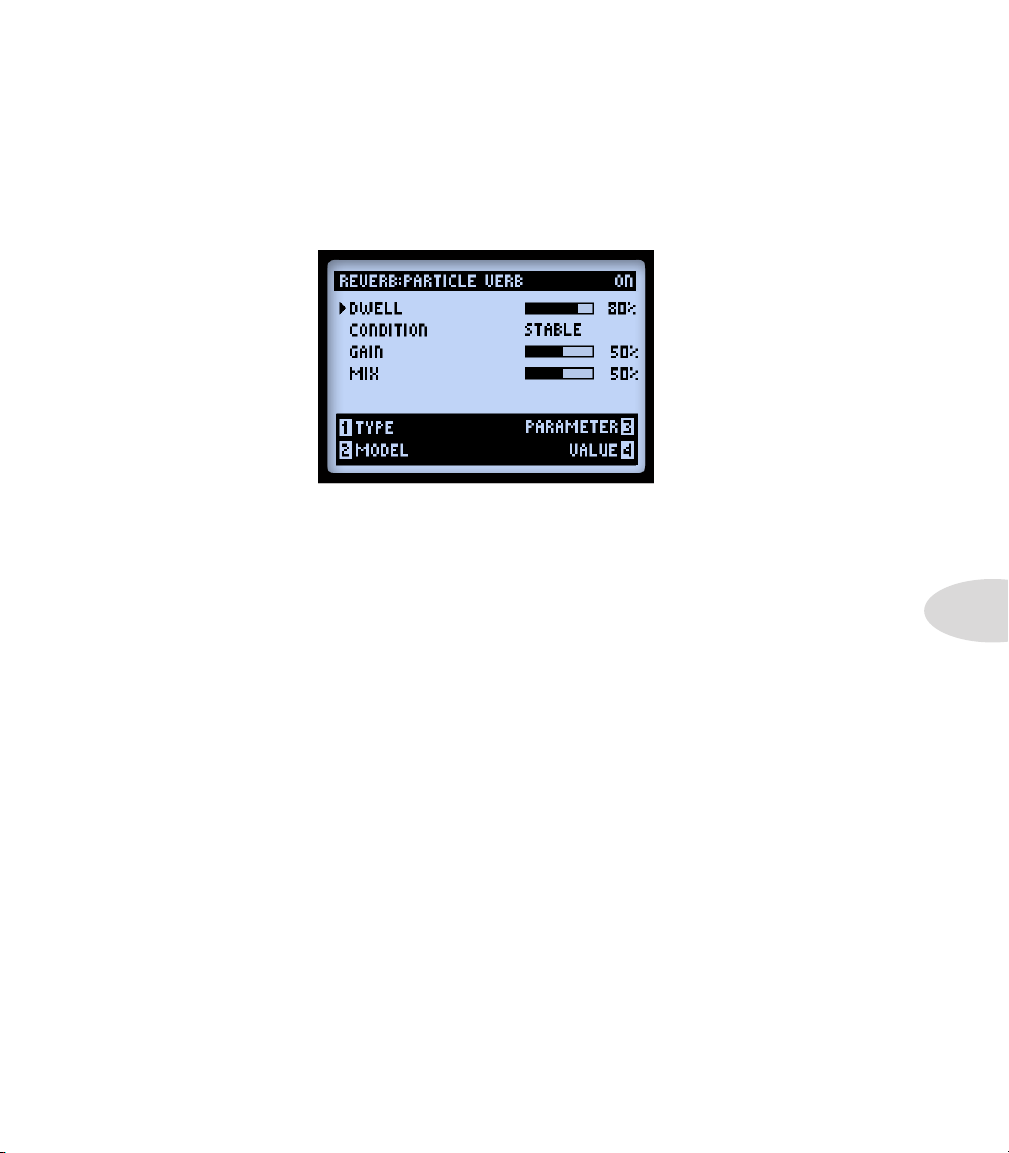
FX Models
brighter, more reflective reverb quality.
• Mix: Sets the balance of the dry & wet signals, from 0% (dry signal only) to 100%
(wet reverb signal only).
Particle Verb
A new kind of reverb effect which turns your chords into a lush modulated pad in STABLE
mode. CRITICAL mode is similar, but with a slight rise in pitch. In HAZARD mode, all
stops are removed. The parameters for this model differ from the other Reverbs:
• Dwell: Essentially a decay parameter, which adjusts the length of time the reverb
tail lasts.
• Condition: Choose between STABLE, CRITICAL and HAZARD here for some
different reverb experiences!
• Gain: Sets overall output level of the effect.
7•13
Page 76

FX Models
7•14
Volume/Pan & Wah Models
The Volume/Pan and Wah sets of Models are primarily designed to be used with a Line
6 FBV™ Series Controller Expression Pedal. When you add any Wah or Volume Model
to your tone, the EXP 1 and EXP 2 Controllers are automatically assigned! Please see
“Expression Pedal & Variax® Knob Controller Assignment” on page B•16 for details.
Volume/Pan Models - Parameter Reference Table
Model Parameter
Volume Volume Level
Pan Pan L-R Balance
Volume
Volume: Adjusts the signal level. 100% is unity gain. This parameter can be accessed via
the Multi-function knob at any time. With a Line 6 FBV Pedal assigned to control the
Volume, you’ll see this Volume parameter visually adjust with the pedal as well.
Page 77

FX Models
Pan
• Pan: Adjusts the signal balance sent to the left and right stereo channels. 0% sends
full left, 50% sends equally left & right, and 100% sends full right.
The audible effect heard when using the Pan can differ quite a bit depending on the
position in your signal chain and what types of FX follow it. Here are a few examples:
Before Path A & B split
7•15
Pan positioned before Path A & B split
When placed here, your guitar signal is panned left to Path A and right to Path B. This
can be a cool way to “blend” the sounds of two Amp models.
Page 78
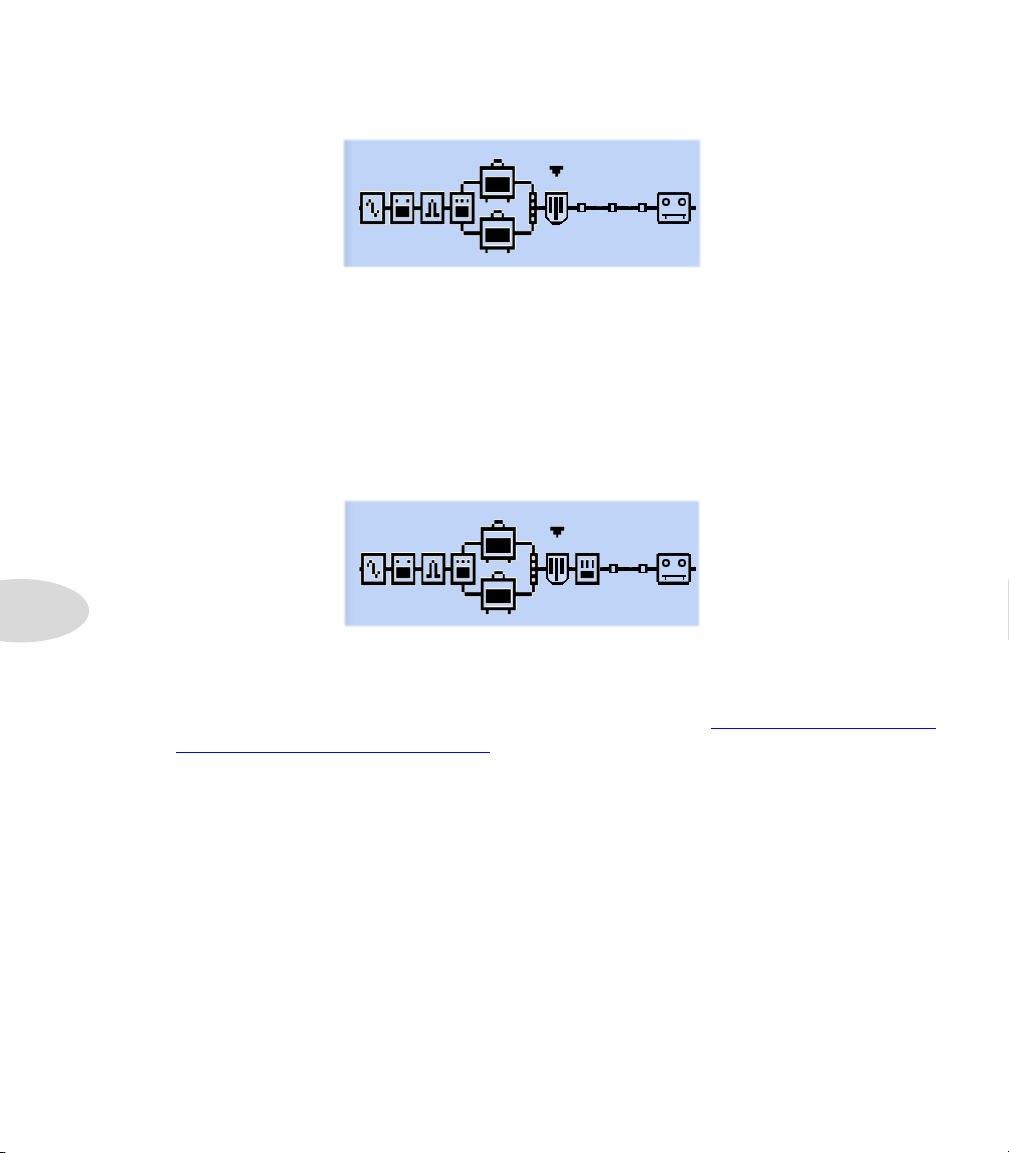
FX Models
7•16
After Path A & B Mixer
Pan positioned after Path A & B Mixer
In this position, the stereo left & right signals fed into the Pan is determined by your
Mixer Pan settings. The Pan effect then pans these signal to the left and right main
outputs. Obviously, you’ll only benefit from using the Pan in this post-Mixer position
when utilizing both the left and right outputs from POD HD Pro.
Placing a Mono Output FX Model after the Pan
Mono FX Model (EQ) positioned after Pan
Just as with all stereo FX Models, when a mono FX Model is placed after the Pan, the
Pan Model’s output will become “mono-ized, as described in “Model Types and Mono/
Stereo Signal Routing” on page 3•6. Therefore, you’ll typically want to avoid placing a
mono FX Model later within the same signal path as the Pan Model.
Page 79
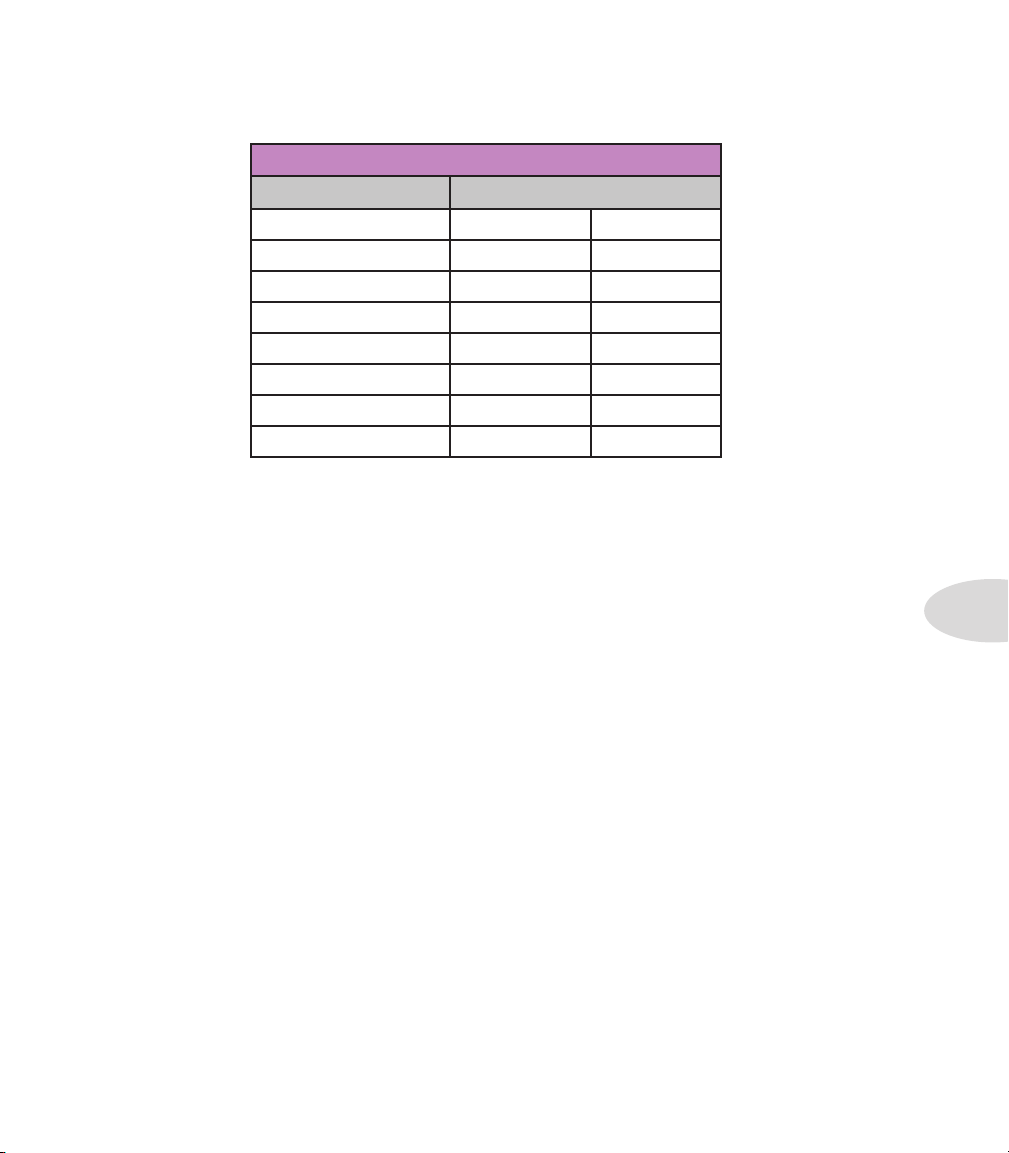
Wah Models
Wah Models - Parameter Reference Table
Model Parameters
Fassel Position Mix
Conductor Position Mix
Throaty Position Mix
Colorful Position Mix
Vetta Wah Position Mix
Chrome Position Mix
Chrome Custom Position Mix
Weeper Position Mix
Common Parameters
Each Wah offers the following two parameters:
FX Models
• Position: This controls the “sweep” of the Wah. Any Wah Model is best used with
this parameter assigned to an FBV pedal, however, you can also access this parameter
with the Multi-function Knob to dial in a “parked” Wah tone.
• Mix: Sets the balance of the “Dry” and “Wet” signals. At 0% no Wah effect is added
to your signal; at 100% you will hear the Wah-effected signal only. Try lowering the
Mix to less than 100% for a more subtle effect!
7•17
Page 80

Page 81
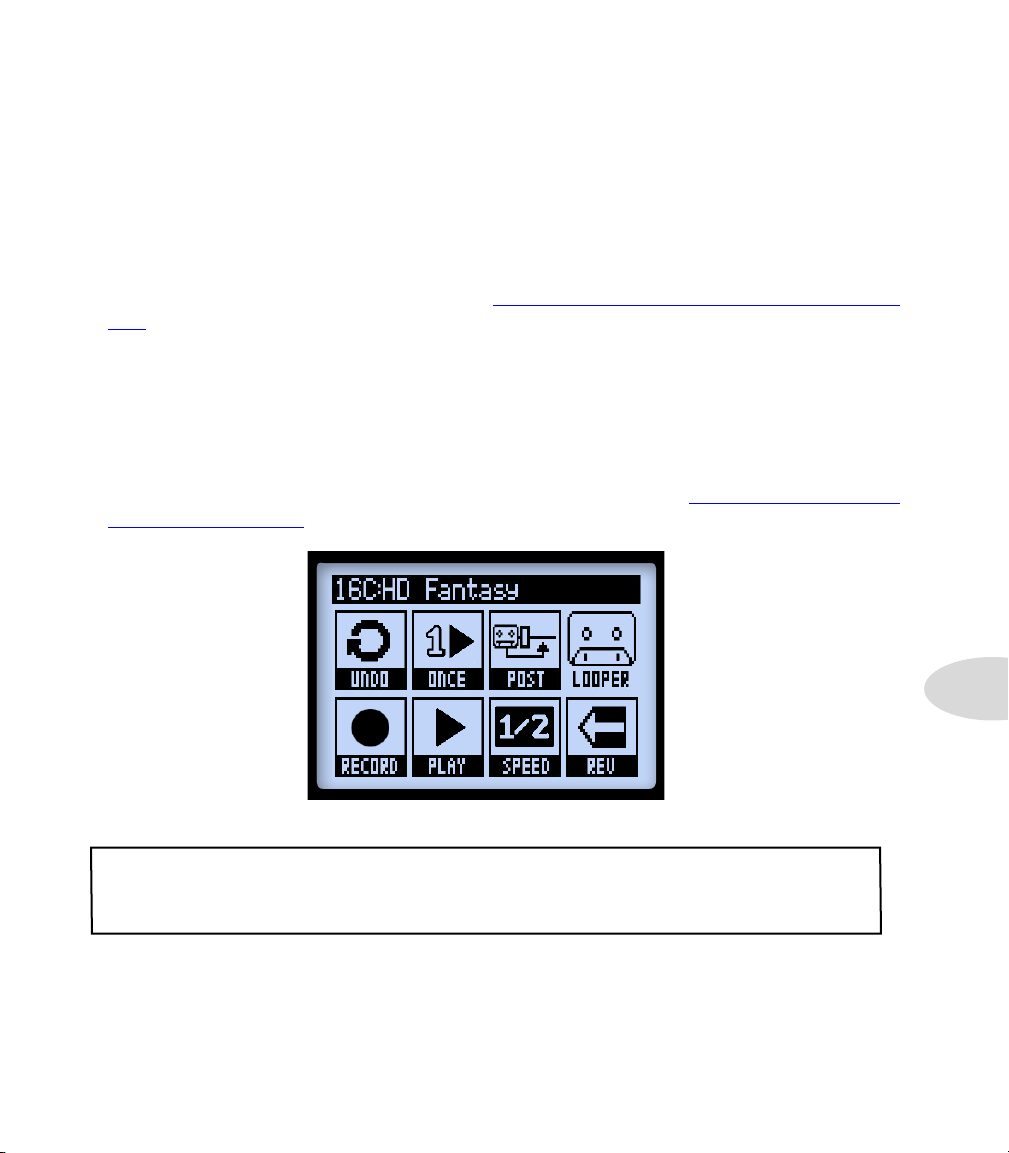
Using the Looper
lOOper mOde
POD® HD Pro includes a full-featured Looper Mode, which is accessible with the
connection of a Line 6 FBV™ Foot Controller. The Looper Mode offers up to 48 seconds
of mono recording time (in Half-Speed Mode) or 24 seconds recording time (in Normal
Mode), as well as the ability to undo, record overdubs, playback Loops at half speed, in
reverse, and more! Footswitch assignments for Looper functions vary among the supported
Line 6 FBV Controller models - please see “Appendix B: FBV Foot Controllers” on page
B•1 for the details.
Looper Controls & Performance View
When Looper Mode is active, an additional Looper screen is available as one of the
Performance View displays of POD HD Pro. This screen shows the behavior of all Looper
functions.* You can think of these as “this is what will happen when the respective button
is pressed” indicators. Press the VIEW button to show this screen whenever you use
the Looper. (Also see the Looper - Performance View options , “Page 1, Setup:Utilities
Options” on page 2•2.)
The Performance View, Looper screen
*Note: The “Pre/Post” Looper Block position option is accessible with most FBV Controller
devices, or the Looper Block can be moved like any FX Model Block within the Signal Flow
View screen.
8•1
Page 82
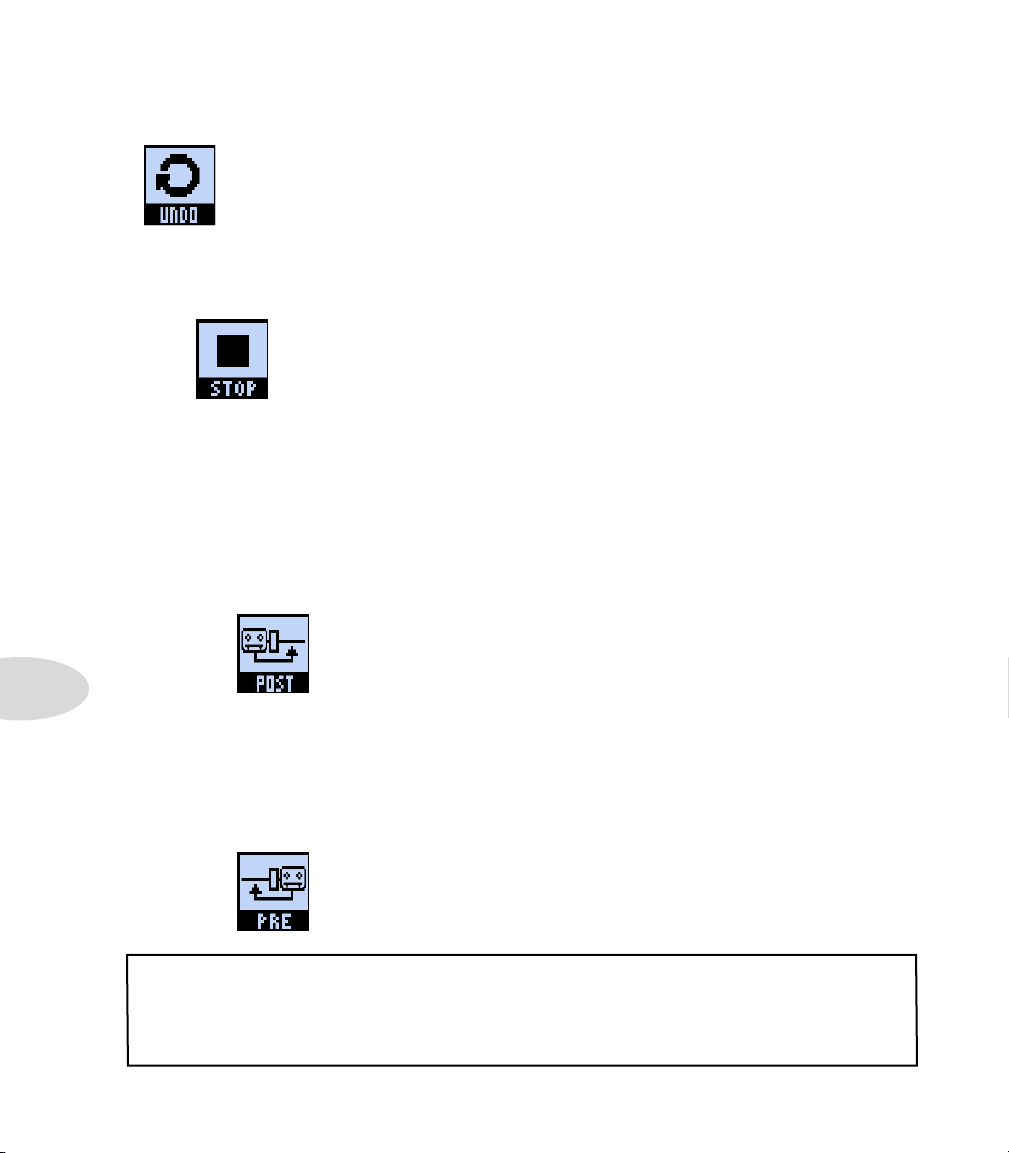
Using the Looper
To follow are descriptions of the functions shown in the Looper screen.
PLAY ONCE - Pressing the FBV footswitch plays your recorded Loop (including overdubs,
if you’ve recorded any) for one cycle. Cool for triggering a pre-recorded phrase on demand!
• While playback is active, the Play/Stop icon appears as “STOP,” to indicate
PRE/POST - The Looper Block can be moved to either a “Pre” or “Post” position within
the Signal Flow View, which dictates whether Amp & FX processing is added to your
guitar signal during the recording of your Loop, or only for the Loop’s playback.
• PRE: Your guitar signal is recorded unprocessed (i.e. - the Loop is recorded “pre”
UNDO - Use the Bank Up FBV footswitch to “undo” the last recorded overdub.
You can press this footswitch while actively in Overdub-Record mode, Loop
Playback mode, or while stopped and only the last recorded overdub is erased.
This function will not erase the originally recorded Loop.
that it can be pressed to stop playback immediately.
Amp & FX processing). When played back, the Loop audio is mixed with incoming
guitar to feed the current Preset’s Amp & FX processing. If you change Presets or
tone settings while set to PRE, you’ll hear them applied to your Loop playback.
8•2
• When the Looper is set to PRE, the Pre/Post icon appears as “POST,”
to indicate that the Looper Block can be moved to the “POST”
position.
• POST: Your guitar signal is recorded processed (i.e. - the Loop is recorded “post”
Amp & FX processing). When played back, the Loop audio is mixed with incoming
guitar AFTER the guitar signal has been processed through the Amp and FX. This
provides the ability select a new Preset which is applied only on your guitar input,
while the Loop plays back with the original recorded Preset tone!
• When the Looper is set to POST, the Pre/Post icon appears as “PRE,”
to indicate that the Looper Block can be moved to the “PRE” position.
Note: If you record your Loop in POST mode and then switch to PRE for Loop playback,
this results in the current Amp+FX to be applied to the Loop playback (where the Loop was
already recorded with Amp+FX applied). Be aware that this can cause the Loop playback
to be significantly louder!
Page 83
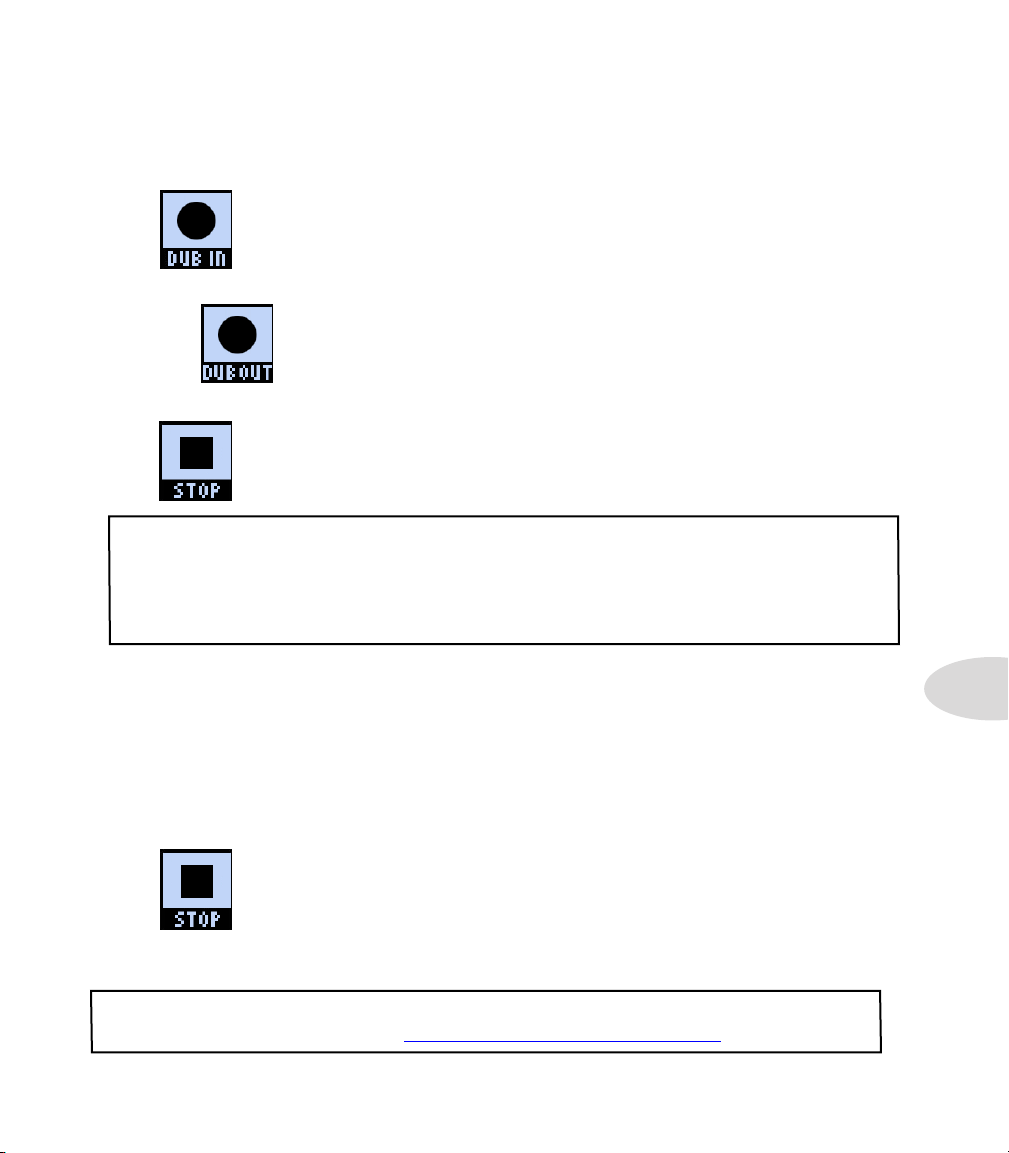
Using the Looper
RECORD/OVERDUB - To record a Loop, press the RECORD FBV footswitch and the
Looper will immediately start recording. You’ll see the Performance View display the
following:
• The Record function shows “DUB IN.” Pressing the RECORD FBV
footswitch will immediately put you into Overdub-Record mode.
• If you press RECORD at this time, whatever you play will be recorded
on top of the original Loop recording, and you’ll see the Performance
View indicator show “DUB OUT.” Press the FBV footswitch again to
stop the overdub recording.
• The Play/Record function shows “STOP” to indicate that pressing the
PLAY/STOP FBV footswitch will stop playback & recording.
Note: Once you have a Loop recorded, you can layer an overdub on top of your current
Loop at any time. Simply play back the Loop and step on the REC/OVERDUB switch
press the RECORD FBV footswitch while the Loop is playing. Your new live guitar will
be recorded on top of your previously recorded Loop. You can repeat this step and layer as
many overdubs as you like!
If you press RECORD while Loop playback is stopped, this will always record a new Loop,
and any previously recording will be discarded.
PLAY/STOP - Press the PLAY/STOP FBV footswitch to toggle Play/Stop for your recorded
Loop. If you are actively recording a Loop, press this switch to stop recording and set your
Loop “out” point. The button remains lit whenever playback is active.
• While playback is active, the Play/Stop icon appears as “STOP.”
1/2 SPEED - Press the 1/2 SPEED FBV footswitch to toggle the 1/2 Speed feature On/Off.
Note that you can use the 1/2 Speed option for recording as well as playback. Specific
behaviors apply to each - please see “1/2 Speed Operation” on page 8•5.
8•3
Page 84
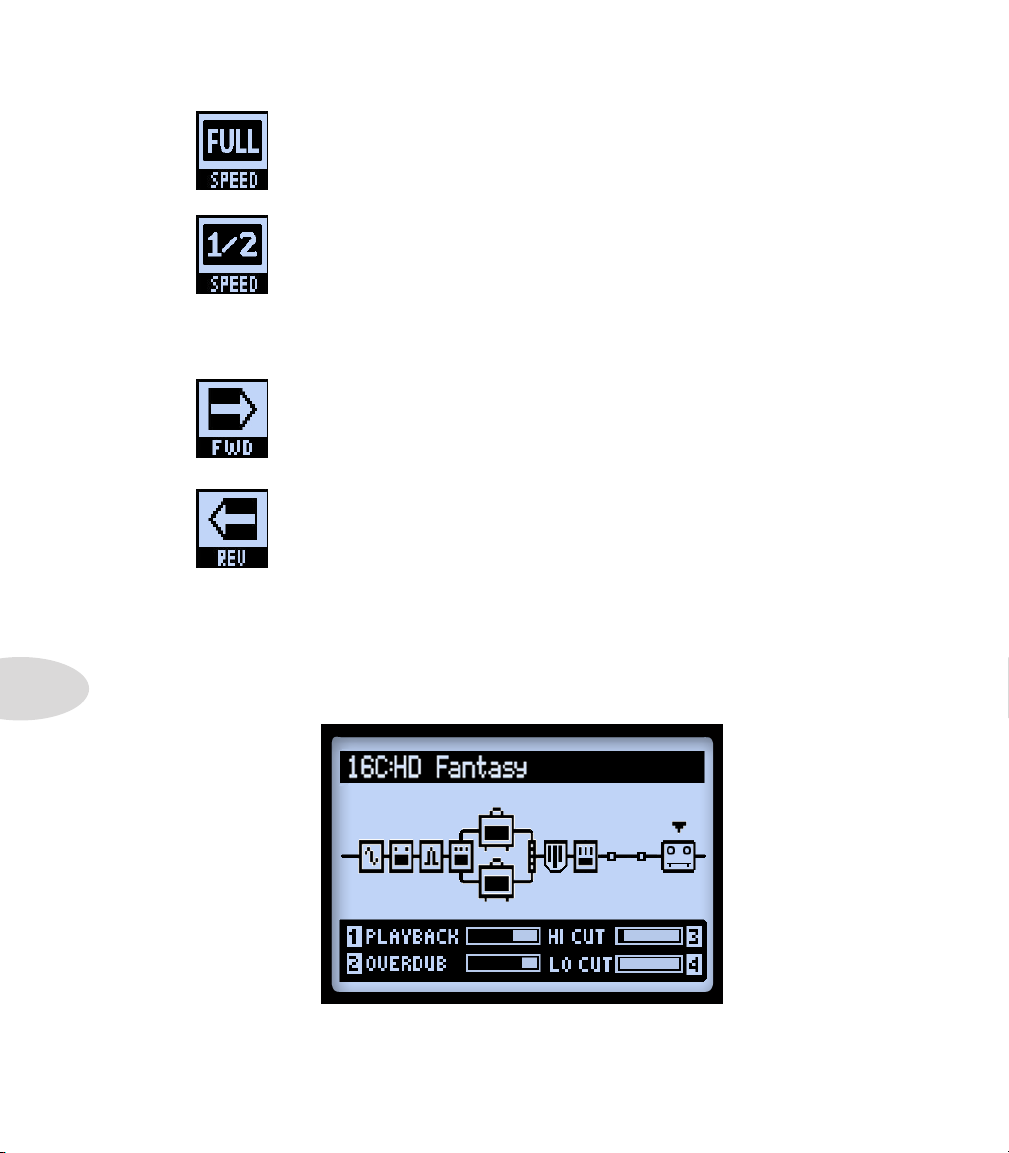
Using the Looper
• When 1/2 Speed is active, the Speed icon appears as “FULL.”
• When 1/2 Speed is Off, the Speed icon appears as “1/2.”
REVERSE - Press the REVERSE FBV footswitch to toggle the Reverse Play feature On/
Off. All Loop playback is backwards when on.
• When Reverse is active, the Reverse icon appears as “FWD.”
• When Reverse is Off, the Reverse icon appears as “REV.”
8•4
Looper Settings
Press the VIEW button to display the Signal Flow View screen and select the Looper to
access several additional settings.
The Signal Flow View screen, Looper options
Page 85
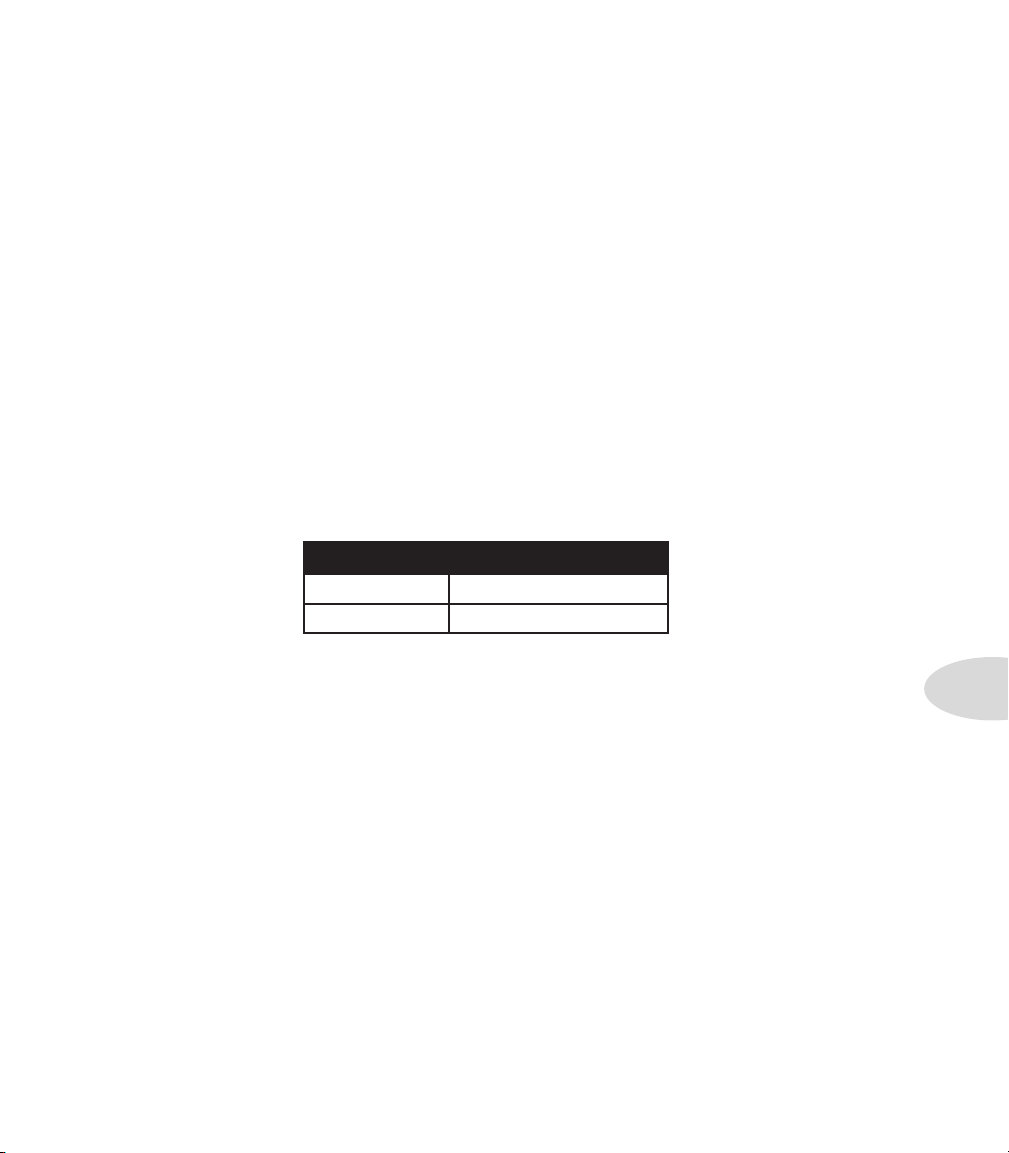
Using the Looper
• Playback (Knob 1) - Use Multi-function Knob 1 to adjust the Looper playback
volume. You may find it useful to turn this down a bit so that your live guitar can be
slightly louder.
• Overdub (Knob 2) - Use Multi-function Knob 2 to adjust the level at which all
Overdubs are recorded. This level does not affect the level of your original Loop
recording.
• Hi Cut (Knob 3) & Lo Cut (Knob 4) - Use Multi-function Knobs 3 & 4 to adjust
these EQ options, to reduce the treble and bass of your Loop playback. It can be
helpful to reduce these to optimize the “mix” of your Loop playback with your live
guitar. These controls reduce the High and Low frequencies more as you raise their
values.
1/2 Speed Operation
The Looper utilizes both the 1/2 Speed and Full Speed options for recording and playback.
These options directly affect the maximum Loop recording time.
POD HD Looper Record Time
Full Speed 24 Seconds maximum
1/2 Speed 48 Seconds maximum
Specific behaviors apply, as follows:
• Full Speed: When set to Full Speed before recording, the Looper provides up to 24
seconds max. recording time.
• Playback of the recorded Loop at the Full Speed setting is heard just as recorded.
• If you change the setting to 1/2 Speed, your recorded Loop is played back at half
speed, as well as pitched one octave lower.
• 1/2 Speed: When set to 1/2 Speed before recording, the Looper provides up to 48
seconds maximum recording time.
• Playback of the recorded Loop at the 1/2 Speed setting is heard just as recorded.
• If you change the setting to Full Speed, your recorded Loop is played back at
double speed, as well as pitched one octave higher.
8•5
Page 86

Page 87
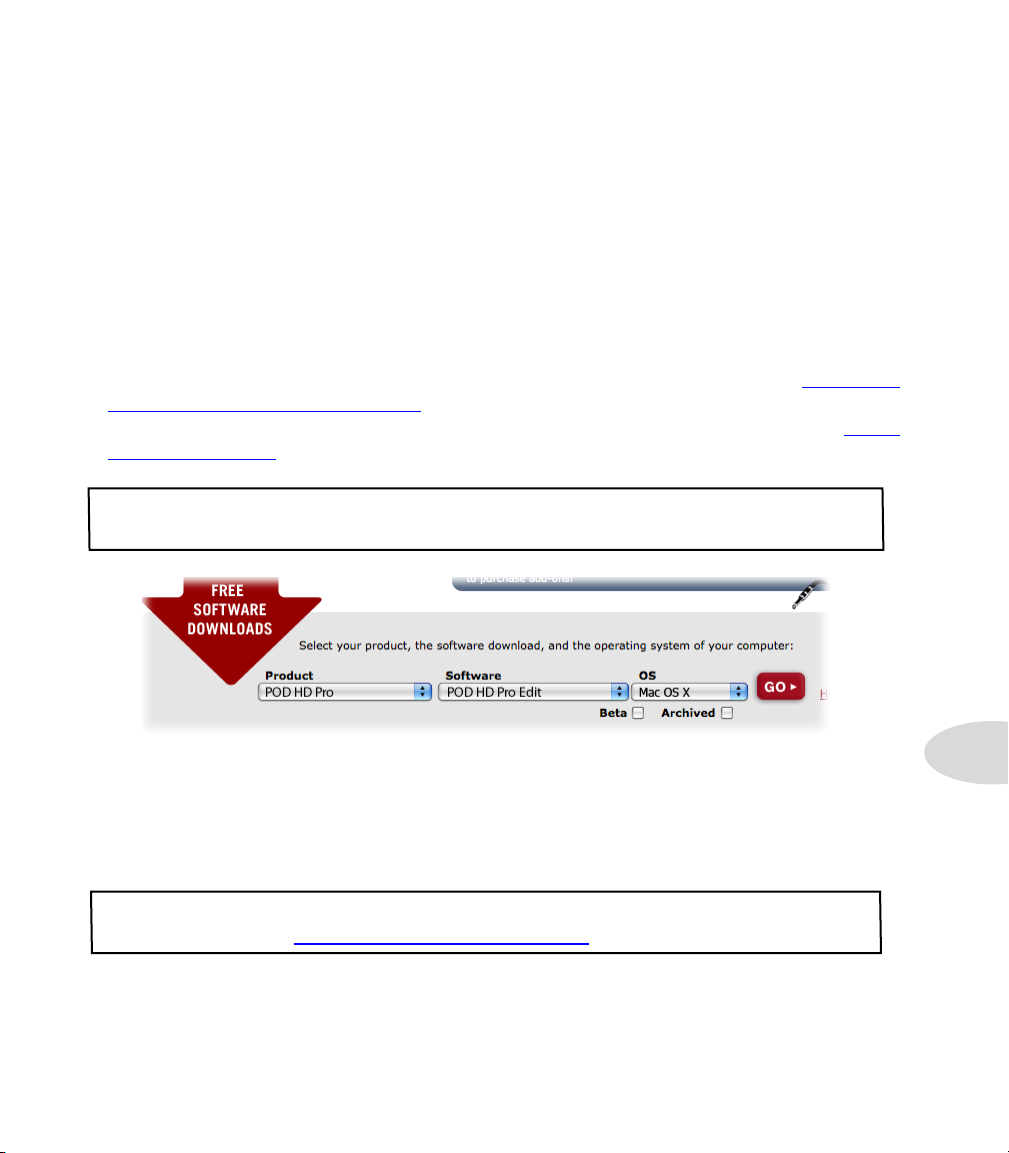
uSb audiO
In this chapter, we’ll cover the USB audio capabilities of POD® HD Pro. With the
installation of the Line 6 USB audio driver, you can use POD HD Pro as a high quality
audio interface for your Mac® or Windows® computer!
The Line 6 USB Audio Driver
Before you connect POD HD Pro to your computer, it is recommended that you download
and install the free Line 6 POD HD Pro Edit software. This installs the necessary Line
6 USB Audio Driver, as well as the Line 6 Monkey update utility (also see “Appendix
A: Line 6 Monkey” on page A•1). The latest POD HD Pro Edit installer, as well as
individual installers for the Driver & Line 6 Monkey, are also always available from http://
line6.com/software.
NOTE: The POD HD Pro USB Device Driver requires Mac OS® X version 10.5
(Leopard®) or later.
USB Audio
The Line 6 Software Downloads site - selecting the POD HD Pro Edit software
Once installation is complete, just connect your device directly to a USB port on your
computer (not into a USB hub) and power on your POD HD Pro. Note that POD HD Pro
requires the use of a USB 2.0 port on your computer.
Also see the POD HD Pro Edit Installer Guide and the POD HD Pro Edit Pilot’s
, available from http://line6.com/support/manuals.
Guide
9•1
Page 88
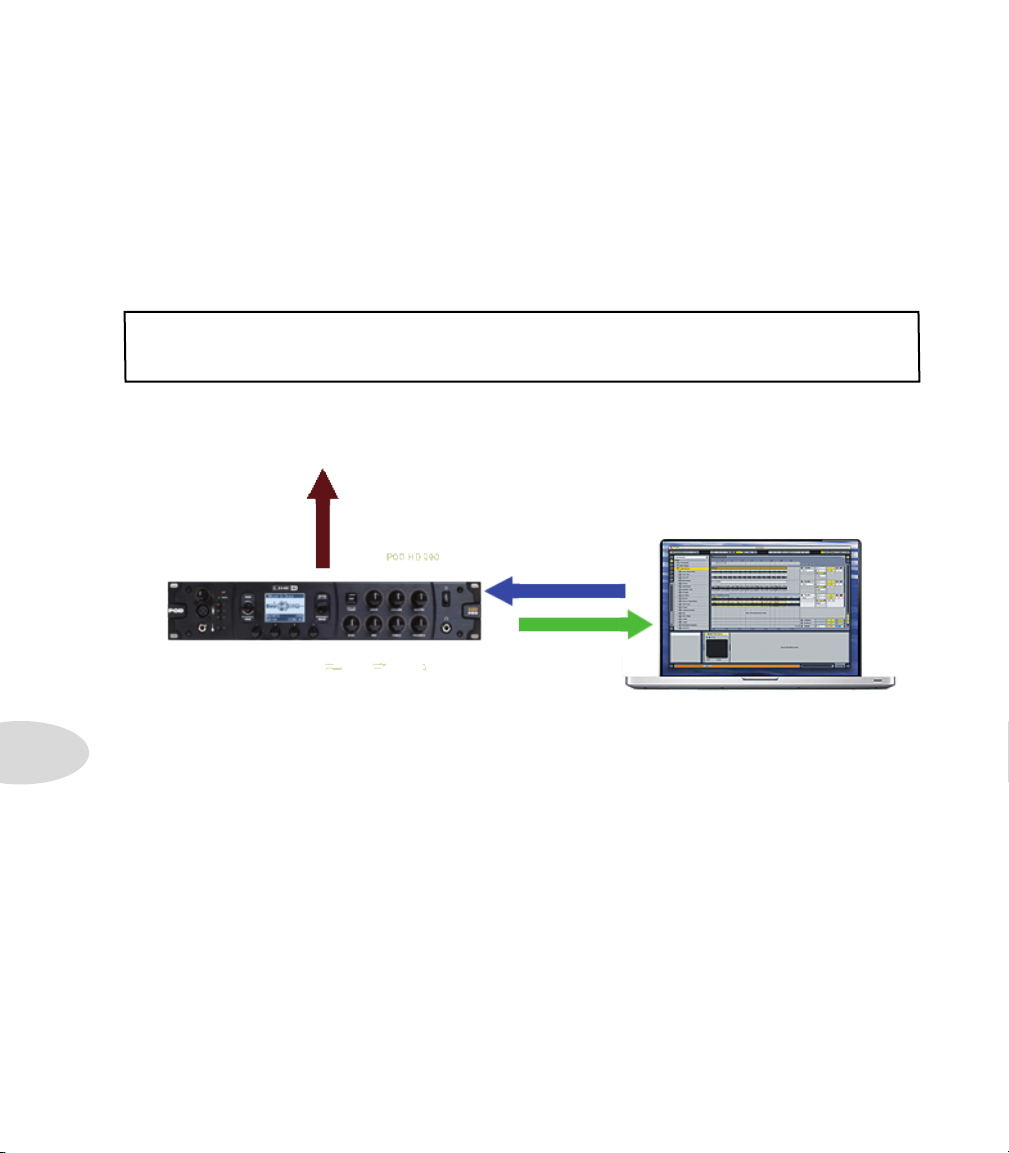
USB Audio
Audio Routing
When using the POD HD Pro USB connection, the audio driver manages several tasks.
The driver feeds the processed guitar signal out the USB Record Send to your computer
and receives playback audio from the computer. It also grabs the processed guitar signal
before routing it to the Record Send, to provide a low latency monitor signal, and then
mixes the monitor signal with the playback audio and feeds this combined signal to your
POD HD Pro analog outputs.
Note that all USB audio is muted whenever a L6 LINK™ connection is active between
POD HD Pro and a DT Series amplifier.
Mix of monitor signal + playback
audio fed to analog outputs
Playback audio
from computer
9•2
Record Send audio to
computer
USB audio routing provided by the Line 6 USB audio driver
Page 89

The POD HD Pro Record Send
As shown above, the Record Send is the virtual “pipeline” that carries your POD HDprocessed, 24-bit digital signal across the USB connection, making it available to your
audio software as an input signal for recording.
The Record Send appears as an available audio input/recording device within your audio
software. Simply select this Send as the input for your audio track and you’ll be able to
record your POD HD Pro signal. The level of the signal fed to the Send is affected by your
POD HD Pro controls: Mixer block Volume A & B, Amp Model Drive & Volume, FX
Model Gain controls, Volume Pedal, etc., (but not the Master Volume knob). For the best
recording quality, watch the input meters provided in your software and adjust your level
to be at least halfway up, but never “clipping.”
Note that the type of audio signal fed to the Record Sends is controlled by the Output
setting found in the POD HD Pro Setup:Outputs screen. For most USB recording
Mode
situations, you’ll likely want to set this to “Studio/Direct.” Please see “Page 4, Setup:
Output Options” on page 2•8
for more info.
The Line 6 Audio-MIDI Devices Panel
USB Audio
The Line 6 Audio-MIDI Devices utility is the place where you configure various audio
driver settings. The options in the Line 6 Audio-MIDI Devices dialog are slightly different
if you are on a Mac® versus a Windows® system. See the following descriptions that
match your setup: For Mac® see next section, or for Windows® see page 9•8.
9•3
Page 90
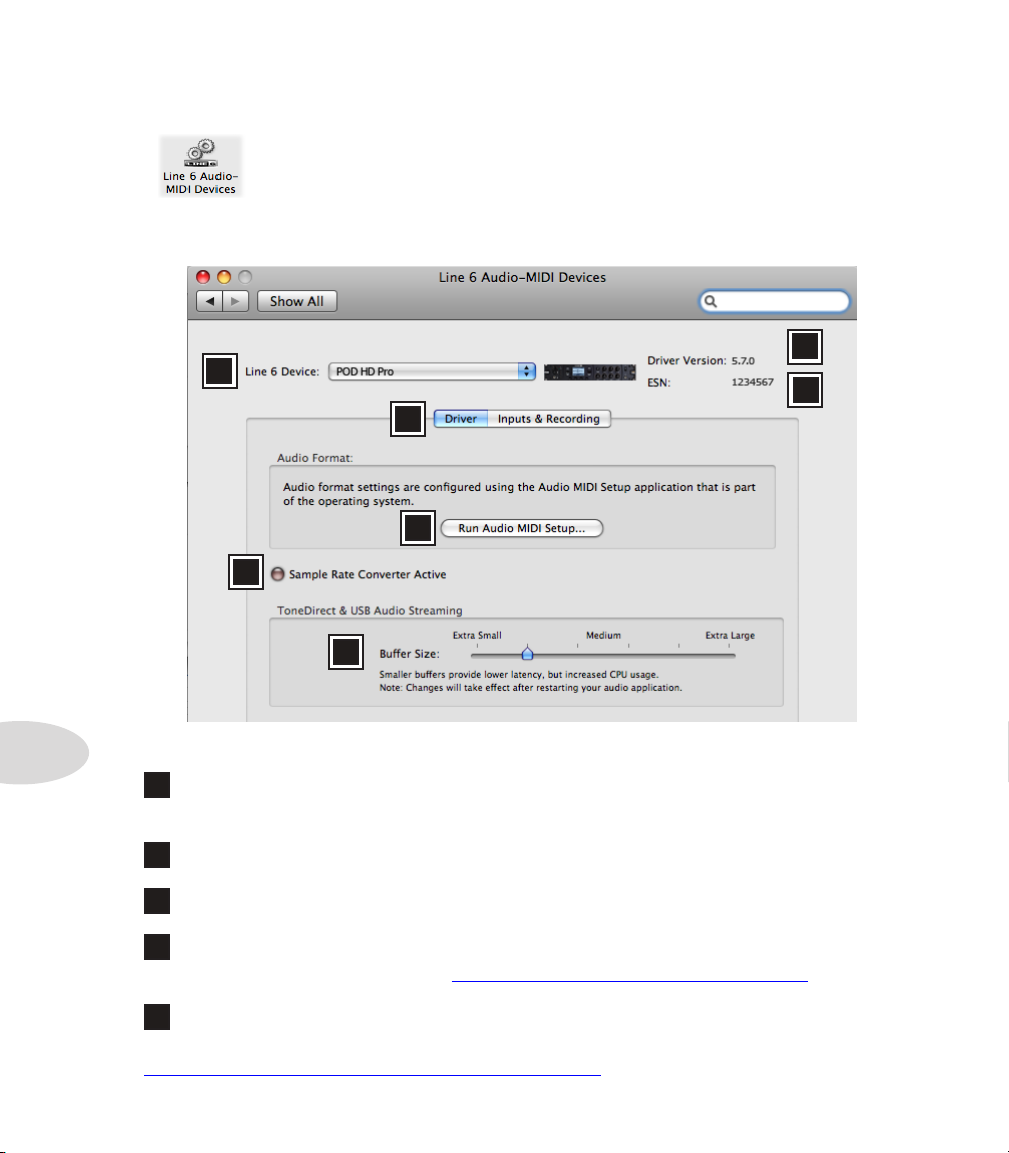
USB Audio
Mac® - Line 6 Audio-MIDI Devices
Launch the Line 6 Audio-MIDI Devices utility from within the Mac®
System Preferences. This utility provides access to several driver options.
Line 6 Audio-MIDI Settings - Driver Options (Mac®)
2
1
3
4
5
6
9•4
7
The Line 6 Audio-MIDI Settings window - Driver page
1
Device Selector: Select your POD HD Pro here. If you have more than one supported
Line 6 audio device connected, each will be selectable in this list.
2
Driver Version: Displays the current device’s installed driver version number.
3
ESN: Displays the current device’s unique Electronic Serial Number.
4
Driver/Inputs & Recording Selector: Choose between displaying the two pages of the
Driver Options window. (Also see “Inputs & Recording Page” on page 9•5.)
5
Run Audio MIDI Setup: Mac® Core Audio interface driver settings are configured in
the Mac OS® X Audio MIDI Setup utility. This button launches this dialog for you (see
“Mac® - Line 6 Audio-MIDI Devices” on page 9•4).
Page 91
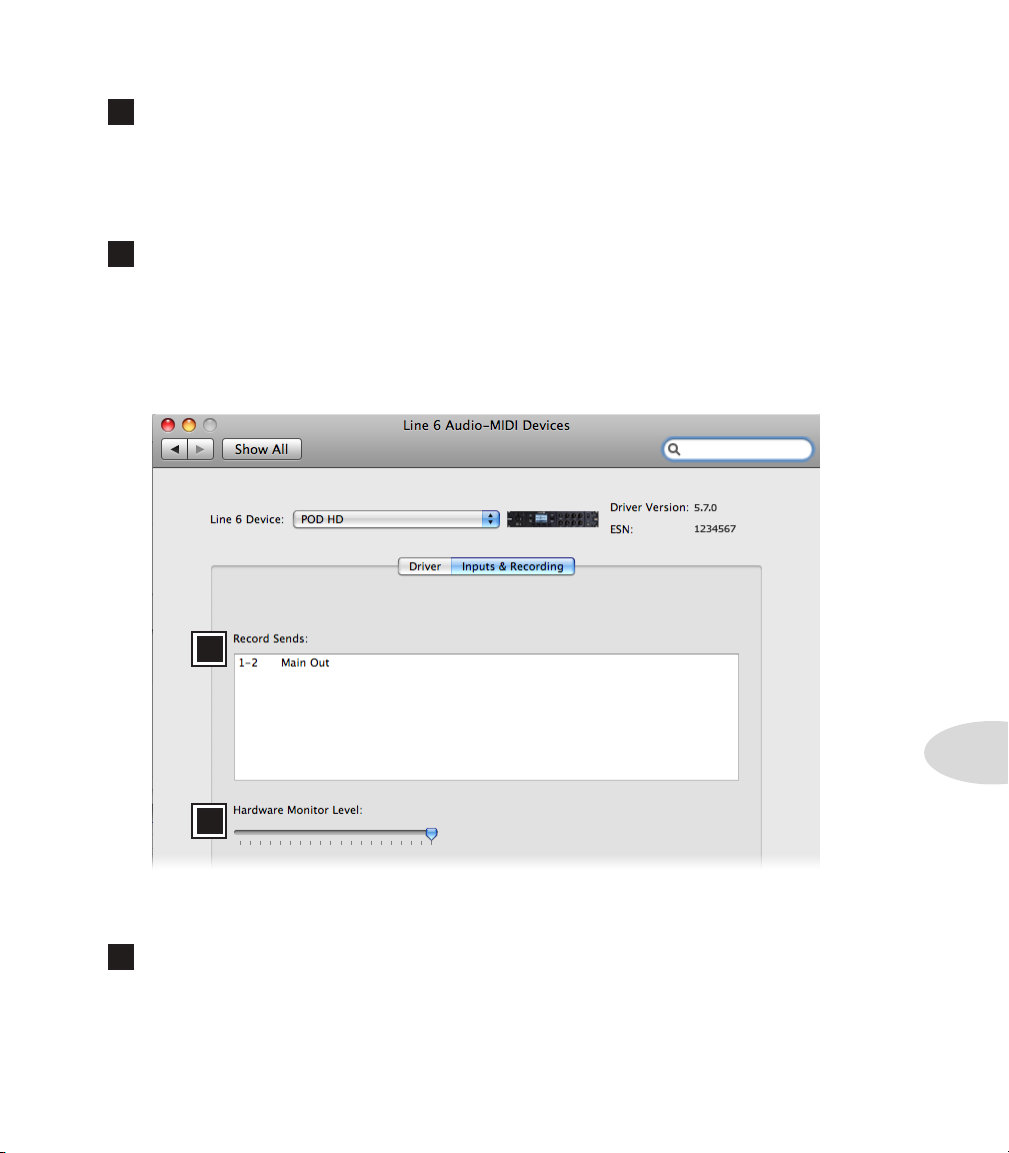
USB Audio
6
Sample Rate Converter Active: You’ll see this indicator light up whenever the device
is operating at a sample rate other than its native 48kHz rate. In addition to 48kHz, POD
HD Pro supports 44.1kHz, 88.2kHz and 96kHz rates by utilizing an internal sample rate
converter. Please check your specific software’s documentation for details on configuring
its audio sample rate.
7
USB Audio Streaming Buffer: Adjusts the buffer size for the audio responsiveness of
the Input Monitoring signal. Basically, the default setting should be fine for most systems,
but if getting audio dropouts or working with large CPU demands on your system, raise the
slider a notch or two to the right until it alleviates the problem.
Inputs & Recording Page
8
9
The Line 6 Audio-MIDI Settings window - Inputs & Recording page
8
Record Sends List: Displayed here are the Record Sends for the current Line 6 device
that will be available to your audio software. For POD HD Pro you’ll see the one, stereo
“1-2 Main Out” Record Send.
9•5
Page 92
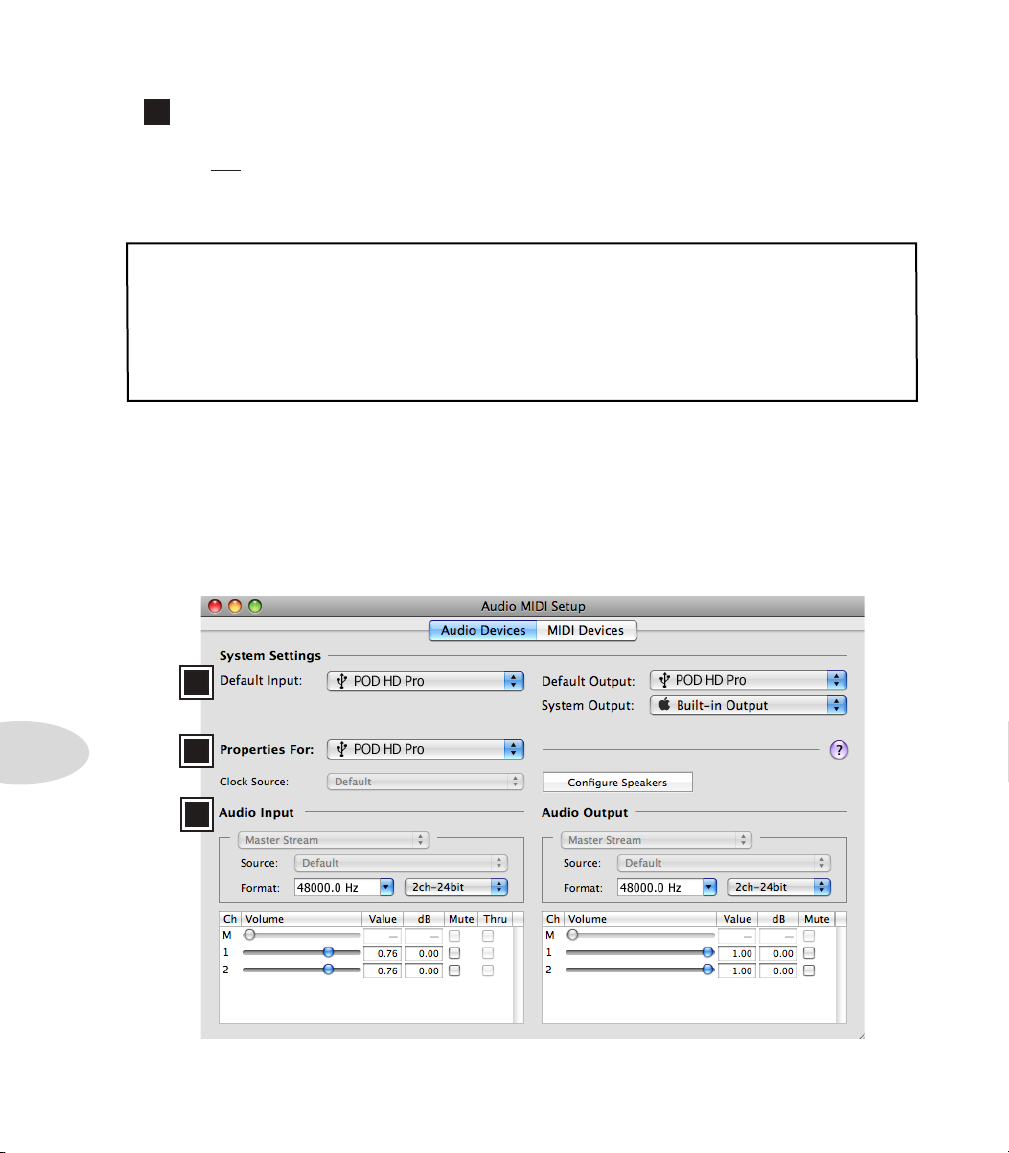
USB Audio
9
Hardware Monitor Level: This slider independently controls the volume of your
processed guitar tone output for monitoring (the signal fed to the device’s main outputs).
It does not affect the level of the signal fed to your computer via the Record Send. This
allows you to balance your guitar’s monitor level against the playback audio from your
computer, such as when recording in DAW software.
If using POD HD Pro as the audio interface for recording into a DAW application, then
your DAW may also offer its own “software monitoring” function. You may want to
use the DAW’s software monitoring in some scenarios, such as if you want to hear your
guitar signal processed with plug-ins on the DAW track. When utilizing DAW software
monitoring, you’ll want to set this slider’s level to minimum to allow you to hear only the
DAW software monitoring signal.
Mac OS® X Audio MIDI Setup Utility
POD HD Pro utilizes the Mac® Core Audio driver type, making it a compatible audio
interface for practically any Mac® audio/multimedia software. As with most Core Audio
devices, some settings are found in the Audio Devices page of the Mac® Audio MIDI
Setup dialog.
9•6
A
B
C
The Audio MIDI Setup utility - Mac OS® X 10.5*
Page 93
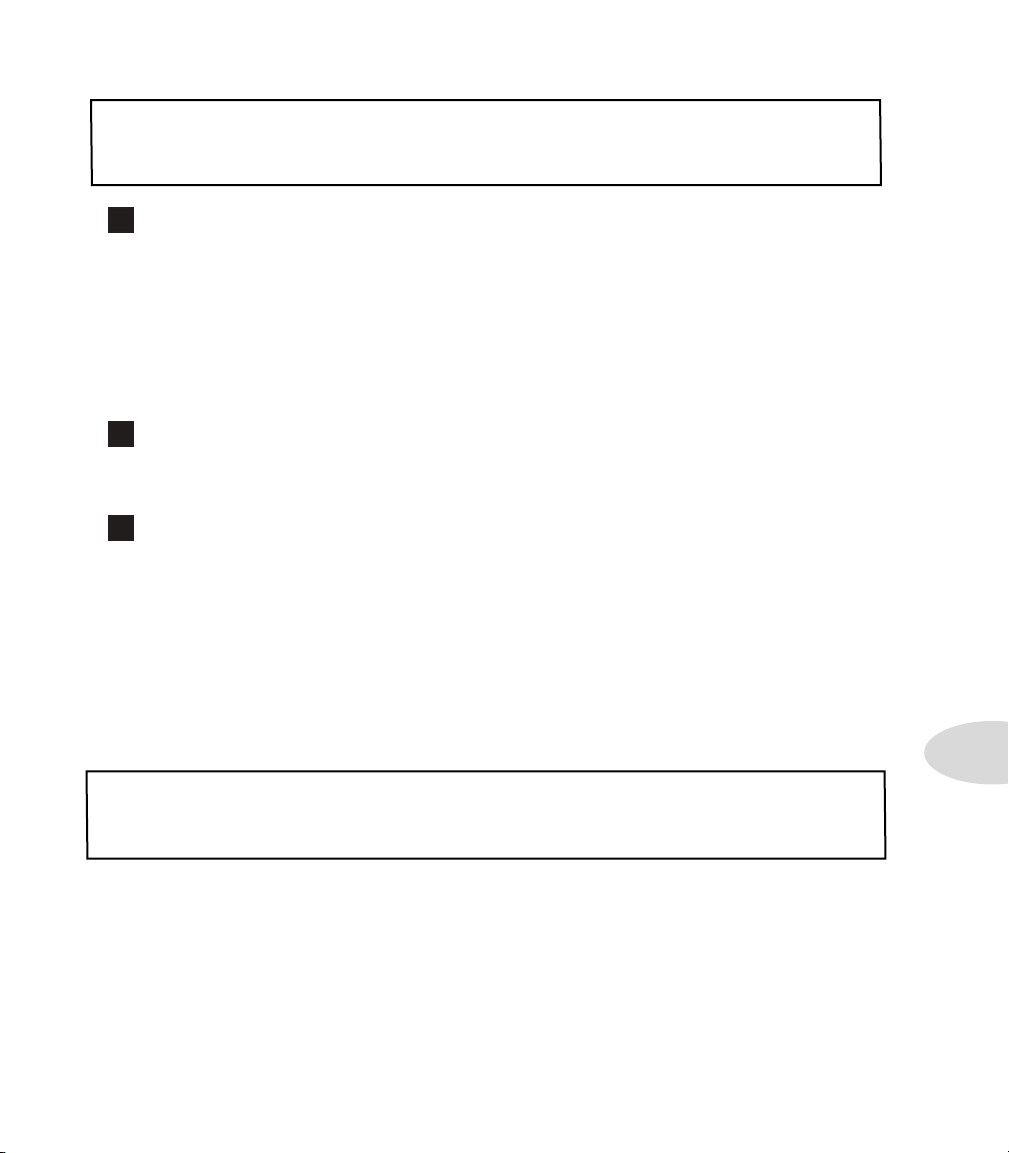
*Note: The Audio MIDI Setup utility window within Mac OS® X versions 10.6 and later
has a slightly different layout, but offers the same options and functionality as described
here.
A
System Settings:
• The Default Input and Default Output options allow you to choose the audio
interface you want your Mac® audio applications to use by default. If you want this
to be your Line 6 device, select it here.
• The System Output option allows you to choose which audio interface the Mac®
System sounds are played through.
B
Device Properties: Choose your POD HD Pro device here to allow the Audio Input
and Audio Output options display its settings.
C
Audio Input & Output Options: If you’ve selected your POD HD Pro in the Device
Properties, these settings will all refer to your POD HD Pro device:
• You’ll see the Input and Output selectors both disabled, showing Master Stream for
each. POD HD Pro includes one stereo “xed” Input (Record Send 1-2) and one
xed stereo Output (Out 1-2).
USB Audio
• The Source options are also disabled for POD HD Pro.
• The Format selectors show you the Sample Rate* and Bit Depth that POD HD Pro
is operating at for recording. The Bit Depth for POD HD Pro is fixed at 24 bit.
*It is recommended that you do not use the Sample Rate selectors in this window to set the
sample rate when your audio software is running. Typically, your audio software will offer a
sample rate option within its own “Preferences” settings.
• The Input Volume Sliders offer level control for the Record Send signal fed to your
recording software. Note that the sliders offer 12dB of input gain at the highest
setting.
• The Output Volume Sliders offer stereo level control for your software’s audio
playback fed to POD HD Pro.
9•7
Page 94
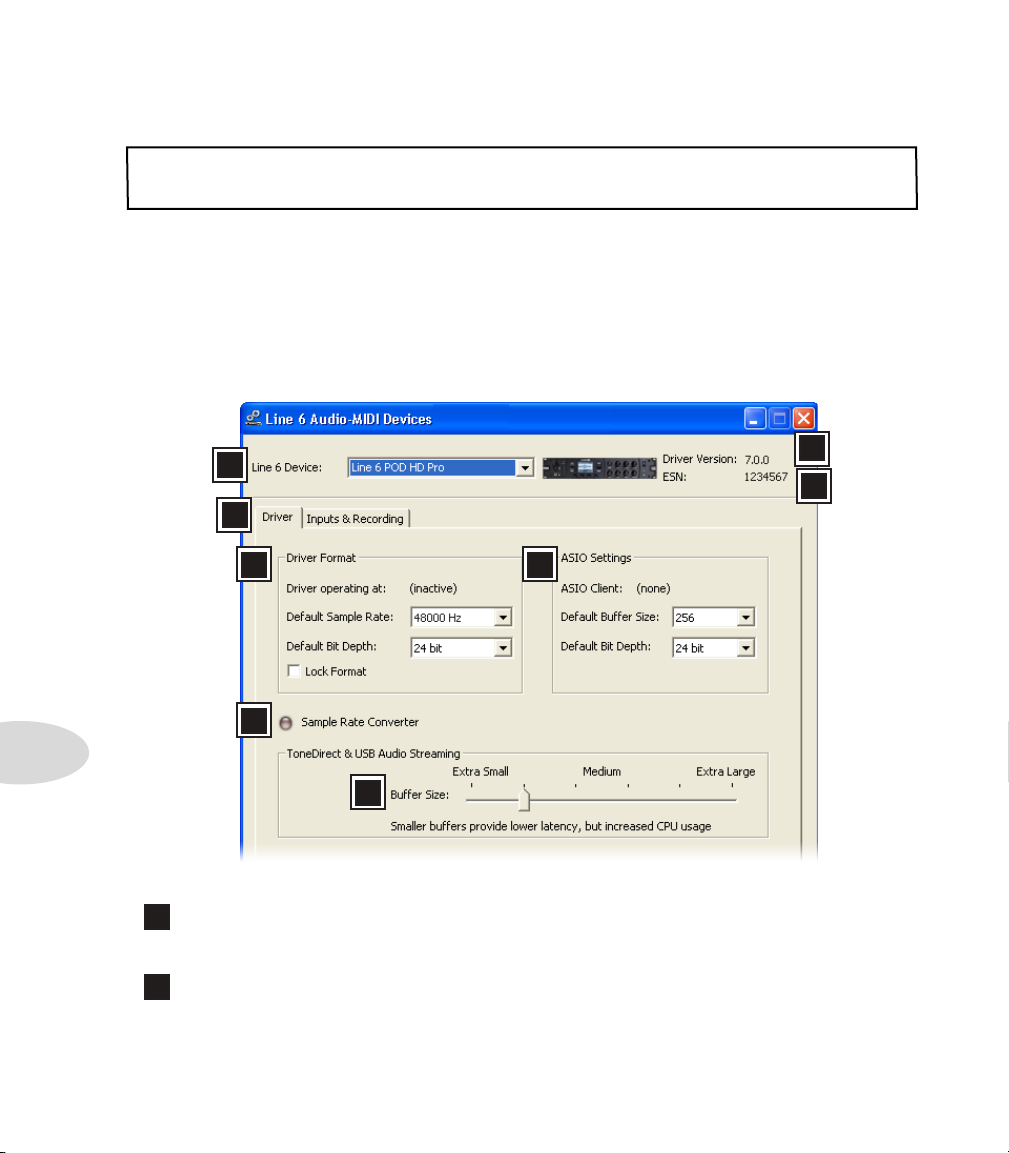
USB Audio
Windows® - Line 6 Audio-MIDI Devices
The following settings are the same for Windows® XP, Windows Vista® or Windows® 7,
unless otherwise noted.
Launch the Line 6 Audio-MIDI Devices from within the Windows® Control Panel.
On Windows® systems, POD HD Pro offers both a DirectSound and ASIO® recording
driver for maximum compatibility with audio & multimedia software applications. It is
always recommended that you select the ASIO® audio driver within your audio software,
if supported, since this offers higher performance. When prompted for ASIO® driver
settings, this dialog is where you will make them.
9•8
1
4
65
7
8
The Line 6 Audio MIDI Devices - Driver tab (Windows® XP)
1
Device Selector - Select your POD HD Pro here. If you have more than one supported
Line 6 audio device connected, each will be selectable in this list.
2
Driver Version - Displays the current device’s installed driver version number.
2
3
Page 95

USB Audio
3
ESN - Displays the current device’s unique Electronic Serial Number.
4
Driver/Inputs & Recording Selector - Choose between displaying the two tabs of the
Driver Options window. (Also see “Inputs & Recording Page” on page 9•12.)
5
Driver Operation (Windows® XP only) - These options are only applicable for when
an application utilizes the POD HD Pro device via the Windows® DirectSound® driver.
They will be non-selectable when in use via the ASIO® driver.
• Driver operating at: Displays the actual Sample Rate & Bit Depth the driver is
operating at when in use by an audio application. If not in use, “inactive” is displayed.
• Default Sample Rate & Bit Depth: Use this option to set the default sample rate &
bit depth that (non-ASIO®) applications will use when using POD HD Pro as the
audio interface.
• Lock Driver Format: When checked, this forces the DirectSound® driver to always
operate at the Sample Rate and Bit Depth settings entered in the two fields above (as
opposed to following the sample rate requested by a Windows® audio application).
9•9
Page 96

USB Audio
5
Driver Operation (Windows Vista® & Windows® 7)
On Windows® Vista & Windows® 7 you will see a Sound Control Panel button - click
this to launch the Windows® Sound panel. Within the Sound panel’s Playback and
Recording tabs you can designate POD HD Pro as the “Default” audio device if you want
all your Windows® multimedia programs to utilize it as their sound card device.
9•10
POD HD Pro selected as the Default Playback Device
You can also click on the Properties button in the Sound dialog to access the default format
settings for the POD HD Pro Sample Rate and Bit Depth when used with Windows®
multimedia applications. (Note that if you are using an audio application that is set to
utilize the ASIO® driver for your Line 6 device, then ASIO® communicates directly with
the device, and these “default format” settings do not apply.)
Page 97
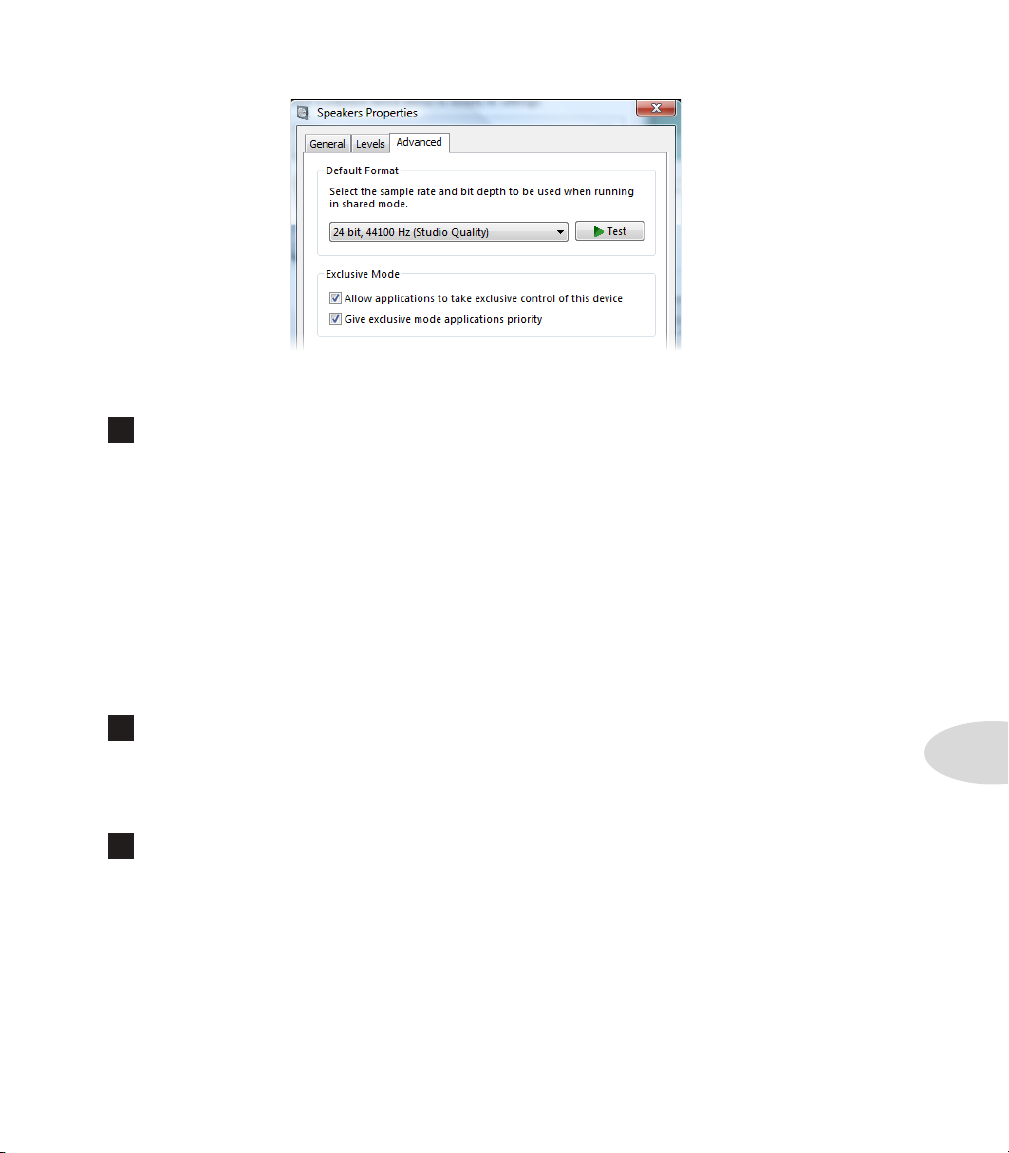
The Window Vista/7 Control Panel>Sounds>Properties - Advanced tab
6
ASIO® Driver Settings
• ASIO® Client: If you are running audio software that is using POD HD Pro as its
ASIO® audio device, the name of the software will appear here.
• Buffer Size: The ASIO® buffer size in use, which will affect the “responsiveness”
and “latency” of the DAW software. The lower the setting, the faster the response,
but with the trade-off of higher processor usage and the risk of audio dropouts. Raise
the value if you are getting inconsistent playback or recording in the audio software.
256 is generally a good setting to start with.
USB Audio
• Bit Depth: The ASIO® bit depth in use. It is recommended to use 24-bit here.
7
Sample Rate Converter Active - You’ll see this indicator light up whenever
the device is operating at a sample rate other than its native 48kHz rate. In addition to
48kHz, POD HD Pro supports 44.1kHz, 88.2kHz and 96kHz rates by utilizing an internal
sample rate converter.
8
USB Audio Streaming Buffer - This slider adjusts the buffer size for the audio
responsiveness of the Input Monitoring signal. Basically, the default setting should be fine
for most systems, but if getting audio dropouts or working with large CPU demands on
your system, raise the slider a notch or two to the right until it alleviates the problem.
9•11
Page 98
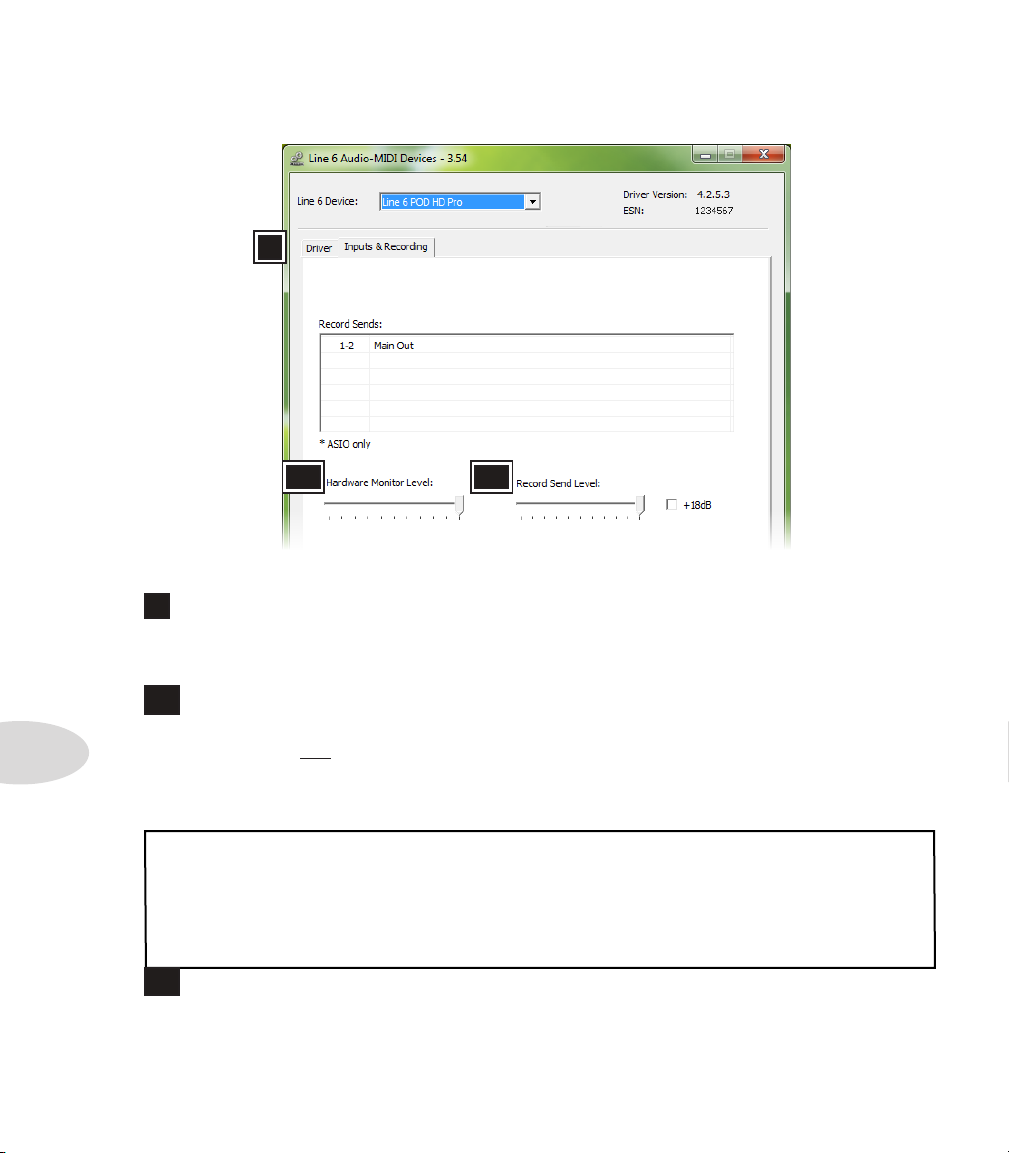
USB Audio
Inputs & Recording Page
9
10 11
The Line 6 Audio MIDI Devices - Inputs & Recording tab
9
Record Sends List: Displayed here are the Record Sends for the current Line 6 device
that will be available to your audio software. For POD HD Pro you’ll see the one, stereo
“1-2 Main Out” Record Send.
9•12
10
Hardware Monitor Level: This slider independently controls the volume of your
processed Source Input tone output for monitoring (the signal fed to the device’s main
outputs). It does not affect the level of the signal fed to your computer via the Record
Send. This allows you to balance your guitar’s monitor level against the playback audio
from your computer, such as when recording in DAW software.
Your DAW software may also offer its own “software monitoring” function. You may want
to use the DAW’s software monitoring in some scenarios, such as if you want to hear your
guitar signal processed with plug-ins on the DAW track. When utilizing DAW software
monitoring, you’ll want to set this Hardware Monitor slider to minimum to allow you to
hear only the DAW software monitoring signal.
11
Record Send Level: This slider independently controls the level of the POD signal
fed to your computer via the Record Send. This directly affects the signal level that is
recorded into your DAW tracks. Note that you can also check the +18dB checkbox here
if you need to boost the signal fed to your DAW.
Page 99

Appendix A: Line 6 Monkey
appendiX a: line 6 mOnkey
Line 6 Monkey™ is the free, intelligent updater software that can be used
to keep your POD® HD Pro, Line 6 FBV™ MkII Controller, and related
Line 6 products, up to date. Line 6 Monkey is installed on your Mac® or
Windows® computer along with the POD HD Pro USB device drivers. If
you have not yet installed the USB device drivers, you’ll need to do so to
utilize POD HD Pro with your computer - see “USB Audio” on page 9•1.
It’s highly recommended to run Line 6 Monkey periodically to check for the
latest updates.
Attention Line 6 Variax® Owners: It is highly recommended that you also use Line 6
Monkey to also get the latest updates for your Variax instrument! Please see “Line 6 Variax
Updates” on page A•4
Launch Line 6 Monkey
Connect POD HD Pro to your computer’s USB 2.0 port and power on your device. To
launch Line 6 Monkey:
• On Mac®, go to /Applications/Line 6/Line 6 Monkey.
for instructions.
A•1
• On Windows®, go to Start menu\Programs\Line 6\Tools\Line 6 Monkey.
The following instructions are the same on Mac® or Windows®, unless otherwise noted.
Login Account
You’ll need to Login so that Line 6 Monkey can communicate with Line 6 and provide you
with exactly what you need. It’s just a few clicks, and it’s free! If you have not yet created
an account, click the New User button and you’ll be walked right through the steps.
Page 100
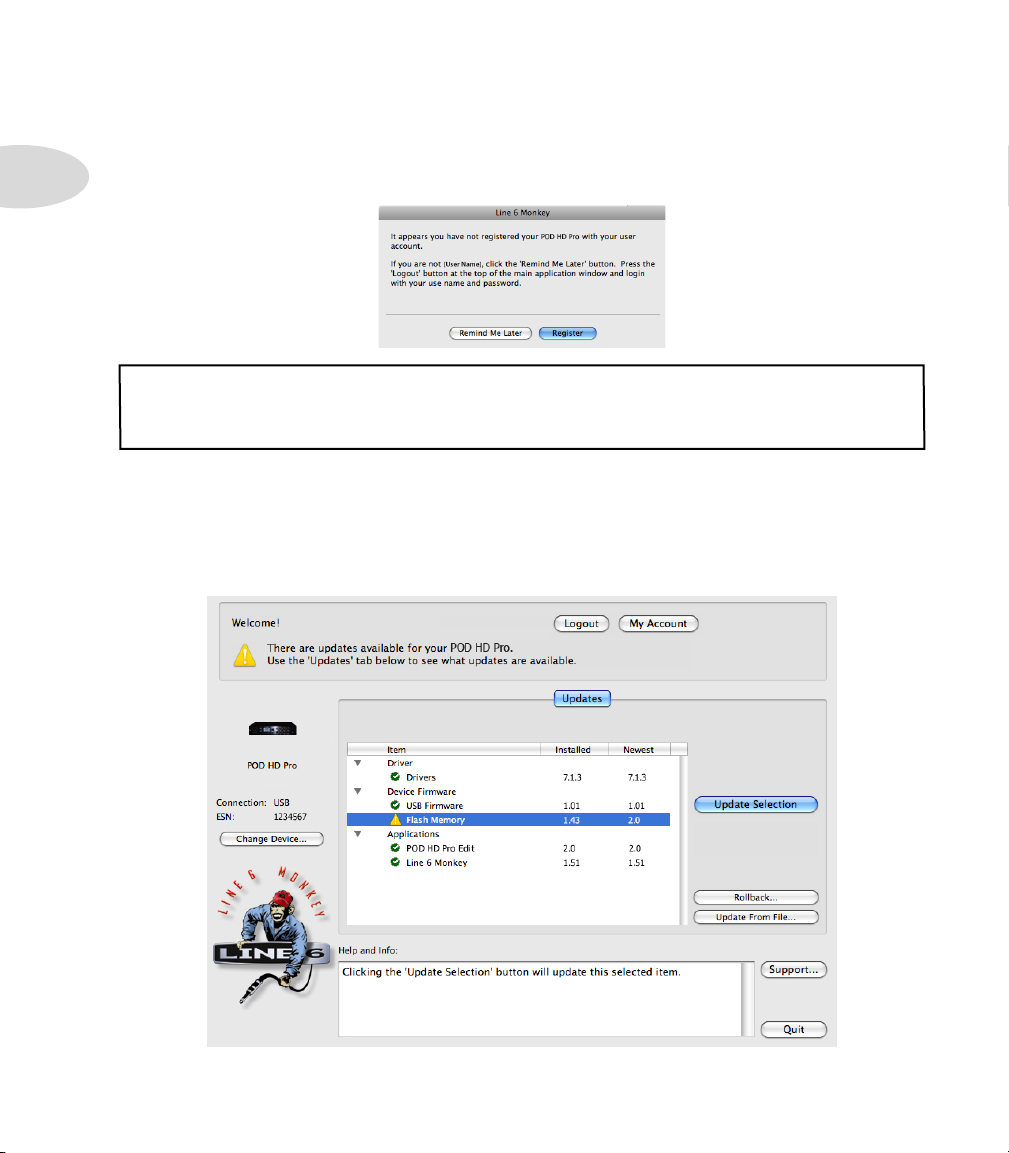
Appendix A : Line 6 Monkey
Register Your Hardware
If you have not already done so, you’ll be prompted to Register your connected Line 6
A•2
hardware. It’s a painless process really, so click that Register button now.
FBV MkII Users: If you are using a Line 6 FBV MkII Controller then it is recommended
to install any available updates for it as well. Just connect your FBV MkII directly to your
computer’s USB port and use Line 6 Monkey as described above.
Grab Those Updates
If you see any items where a newer version is available, then you should click on that item
and let the little Monkey fellow walk you through the installation steps.
Line 6 Monkey - Update screen for POD HD Pro
